Paul van Yperen's Blog, page 128
April 11, 2022
Three films with Jackie Coogan: Oliver Twist (1922), Daddy (1923), and A Boy of Flanders (1924)
American actor Jackie Coogan (1914-1984) is beloved as Uncle Fester in the classic TV series The Addams Family (1964-1966). He began in silent films as Charlie Chaplin's irascible sidekick in The Kid (Charles Chaplin, 1921). In the following years, he became the most popular child actor of the silent era and one of the highest-paid stars in Hollywood. In this post, we highlight three of his best films from that period, Oliver Twist (1922), Daddy (1923), and A Boy of Flanders (1924).
Oliver Twist (1922)
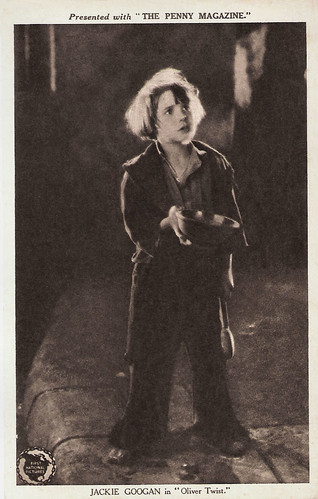
British postcard presented with The Penny Magazine. Photo: First National. Jackie Coogan in Oliver Twist (Frank Lloyd, 1922). “Please, sir, I want some more”.
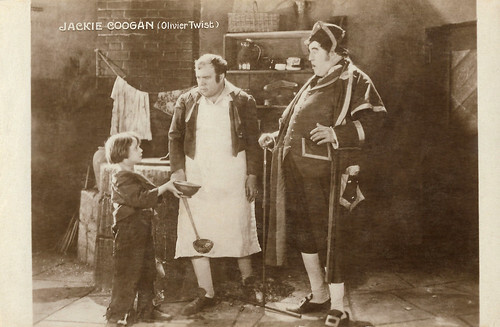
French postcard by Cinémagazine-Edition. Photo: Jackie Coogan in Oliver Twist (Frank Lloyd, 1922).
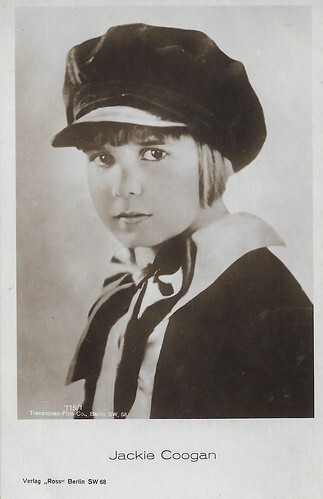
German postcard by Ross Verlag, Berlin, no. 715/1. Photo: Transocean-Film-Co., Berlin. Jackie Coogan in Oliver Twist (Frank Lloyd, 1922).
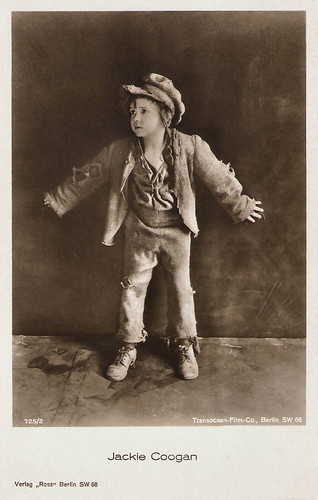
German postcard by Ross Verlag, Berlin, no. 725/2. Photo: Transocean-Film Co., Berlin. Jackie Coogan in Oliver Twist (Frank Lloyd, 1922).
In Oliver Twist (Frank Lloyd, 1922), Jackie Coogan plays Charles Dickens' beloved orphan named Oliver Twist. Oliver's mother, a penniless outcast, died giving birth to him. As a young boy, Oliver is brought up in a workhouse, is deemed a troublemaker, and sent away to apprentice to an undertaker, Mr. Sowerberry (Nelson McDowell).
Then Oliver meets a pickpocket, Edouard Trebaol as The Artful Dodger, on the streets of London. From there, he joins a household of boys who are trained to steal for their master ( Lon Chaney as Fagin). Oliver also meets a burglar named Bill Sykes (George Siegmann) and a prostitute named Nancy (Gladys Brockwell). After realizing that his new friends are on the wrong side of the law, Oliver spends the rest of the film trying to escape them, all the while, his mysterious past is threatening to come to light…
Producer Sol Lesser of First National Pictures and the Coogan family correctly saw Charles Dickens' classic story as an excellent vehicle for their young star, who adds a touch of his own personality to the character. Lon Chaney had built his reputation as a villain and a master of makeup. Director Frank Lloyd had already successfully tackled Dickens in the Fox prestige production of A Tale of Two Cities. Jackie Coogan , Lon Chaney , and Frank Lloyd all get the job done. Once feared lost, a print was reportedly discovered in Yugoslavia in 1973. The print lacked intertitles, which were subsequently restored by Blackhawk Films with the help of Jackie Coogan and Sol Lesser.
Lugonian at IMDb : "many of the film's best moments belong to little Jackie. It's certainly hard to forget his sad facial emotions capturing the essence of Dickens's character, particularly one who's never experienced happiness. Even in a courtroom scene where the accused thief is forced to stand on a platform as he fights dizziness and keeping his eyes open to what's happening around him, brings forth emotional pity, though not by his stern judges.
Only when taken in by the wealthy Mr. Brownlow is he given that opportunity to find the true meaning of happiness and consider himself one of the family. Being abducted back to the gang of thieves who strip him of his luxury clothing and revert him back to his former pauper-looking appearance is quite an emotional impact for little Oliver, especially when in the clutches of the likes of Bill Sykes. No wonder Coogan became the most popular child actor of his time."
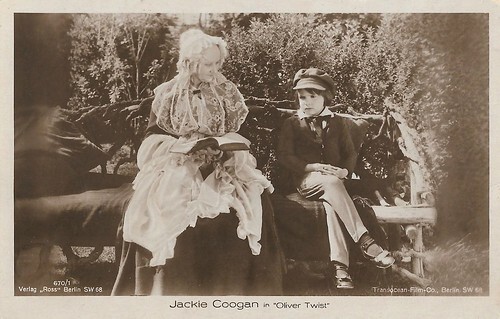
German postcard by Ross Verlag, no. 670/1, 1919-1924. Photo: Transocean-Film-Co., Berlin. Jackie Coogan as Oliver and Gertrude Claire as Mrs. Maylie in Oliver Twist (Frank Lloyd, 1922).
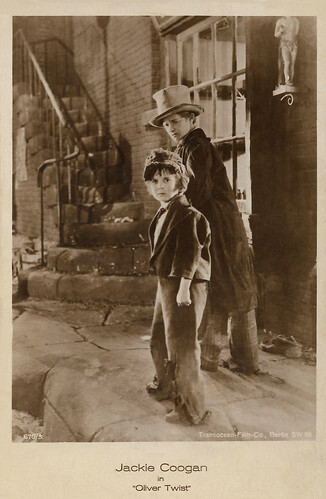
German postcard by Ross Verlag, no. 670/3, 1919-1924. Photo: Transocean Film-Co., Berlin. Jackie Coogan as Oliver and Edouard Trebaol as The Artful Dodger in Oliver Twist (Frank Lloyd, 1922).
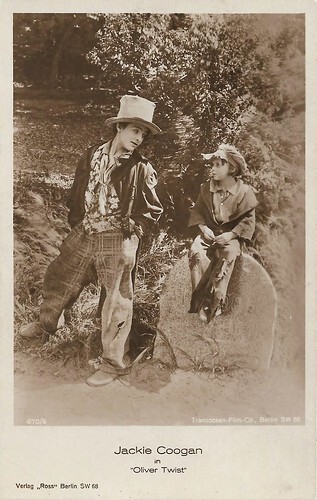
German postcard by Ross Verlag, no. 670/5, 1919-1924. Photo: Transocean Film-Verleih. Jackie Coogan in Oliver Twist (Frank Lloyd, 1922). On the left, Edouard Trebaol as The Artful Dodger.

German postcard by Ross Verlag, Berlin, no. 670/6. Photo: Transocean-Film-Co., Berlin. Jackie Coogan in Oliver Twist (Frank Lloyd, 1922). The stout man on the right must be George Siegmann playing Bill Sykes.
Daddy (1923)
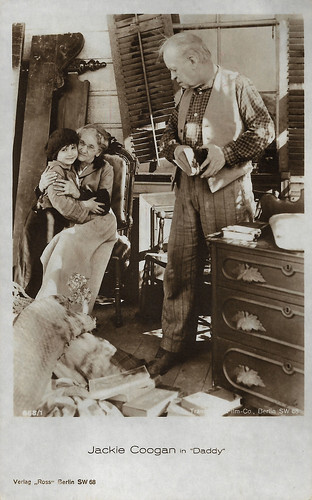
German postcard by Ross Verlag, no. 668/1, 1919-1924. Photo: Transocean Film-Co., Berlin. Jackie Coogan in Daddy (E. Mason Hopper, 1923) with Anna Townsend and Bert Woodruff.
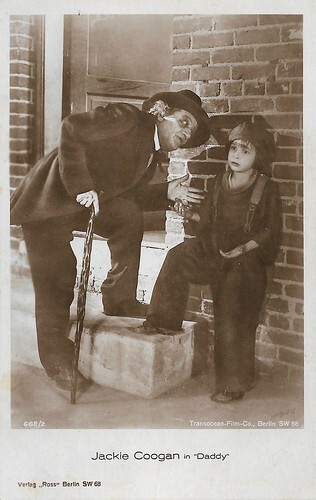
German postcard by Ross Verlag, Berlin, no. 668/2. Photo: Transocean-Film-Co., Berlin. Jackie Coogan and Cesare Gravina in Daddy (E. Mason Hopper, 1923).
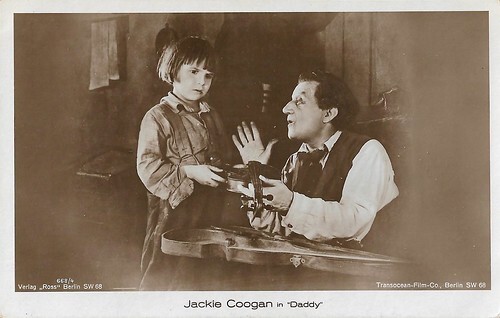
German postcard by Ross Verlag, Berlin, no. 668/4. Photo: Transocean-Film-Co., Berlin. Jackie Coogan and Cesare Gravina in Daddy (E. Mason Hopper, 1923).
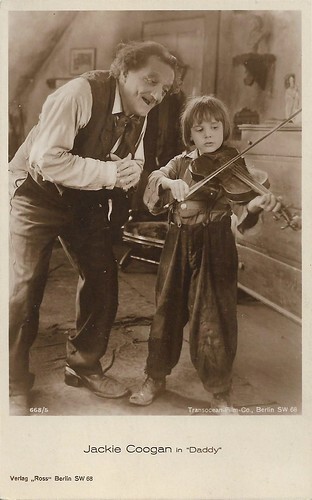
German postcard by Ross Verlag, Berlin, no. 668/5. Photo: Transocean-Film-Co., Berlin. Jackie Coogan and Cesare Gravina in Daddy (E. Mason Hopper, 1923).
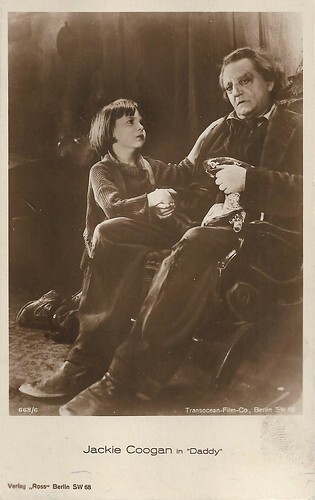
German postcard by Ross Verlag, Berlin, no. 668/6. Photo: Transocean-Film-Co., Berlin. Jackie Coogan and Cesare Gravina in Daddy (E. Mason Hopper, 1923).
Jackie Coogan 's parents, Jack and Lillian Coogan, wrote the script for the silent drama Daddy (E. Mason Hopper, 1923) for Associated First National Pictures. In fact, Daddy was a family affair, it was "A Jackie Coogan Production," "personally supervised by Jack Coogan".
Jackie plays the son of a poor violin teacher (Arthur Edmund Carewe) who is separated from his father when his parents break up their marriage. Believing her husband to be unfaithful, Helene Savelli (Josie Sedgwick) takes her little son Jackie (Coogan) to live on the Holden farm. Helene dies shortly thereafter and Jackie runs away from home when the Holdens (Bert Woodruff and Anna Townsend) are forced into the poorhouse. In the Big City, Jackie befriends Gallo (Cesare Gravina), a sidewalk musician who just happens to be the former teacher of world-famous violinist Paul Savelli, Jackie's long-lost father. Before he dies, Gallo manages not only to reunite father and son but restore the farm to the kindhearted Holdens.
Daddy was a commercial and critical success. It was the 5th highest-grossing American film of 1923 at the box office after Safety Last!.
The Daily Independent of Murphysboro, Illinois praised the full cast, believing Hopper's "directorial genius" to have brought out the best in everybody. They stated that Coogan possessed an "undiminished power" as a star which "draw[s] to him all classes and ages and both sexes".
The Daily Courier of Connellsville, Pennsylvania stated that the film is "richer in opportunities than any previous Jackie Coogan vehicle and reported that spectators at the theatres were "thrilled to hushed silence when little Jackie moved through the scene in which his guardian passes away and Jackie finds his real daddy". The newspaper declared that the film will "live in our memory forever".
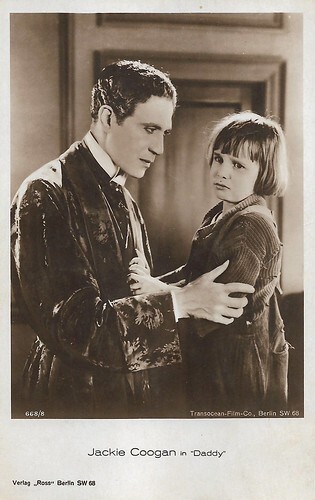
German postcard by Ross Verlag, Berlin, no. 668/8. Photo: Transocean-Film-Co., Berlin. Jackie Coogan and Arthur Edmund Carewe in Daddy (E. Mason Hopper, 1923).
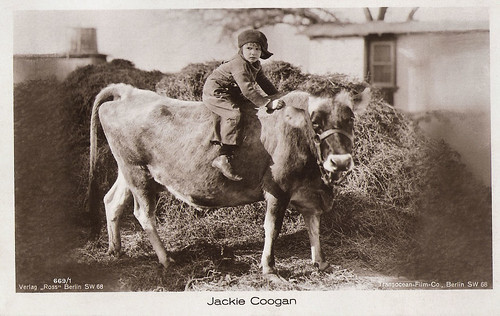
German postcard by Ross Verlag, no. 669/1, 1919-1924. Photo: Transocean-Film-Co., Berlin. Jackie Coogan in Daddy (1923).
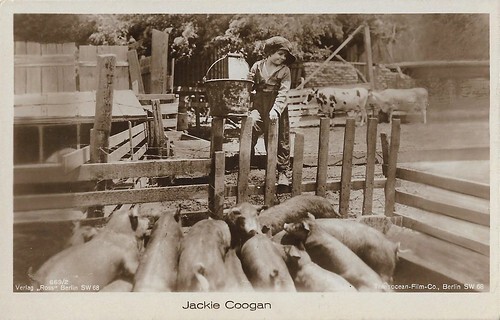
German postcard by Ross Verlag, Berlin, no. 669/2. Photo: Transocean Film-Co., Berlin. Jackie Coogan in Daddy (E. Mason Hopper, 1923).
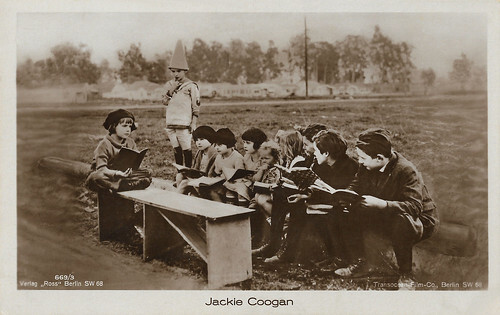
German postcard by Ross Verlag, Berlin, no. 669/3. Photo: Transocean Film-Co., Berlin. Jackie Coogan in Daddy (E. Mason Hopper, 1923).
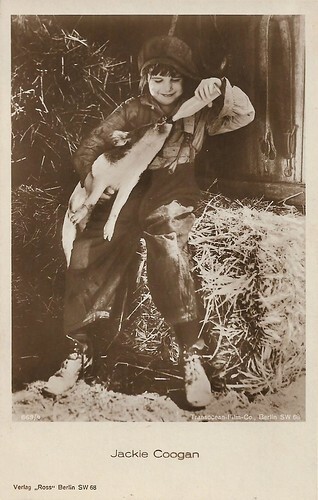
German postcard by Ross Verlag, Berlin, no. 669/4. Photo: Transocean-Film-Co., Berlin. Jackie Coogan and his pet piglet in Daddy (E. Mason Hopper, 1923).
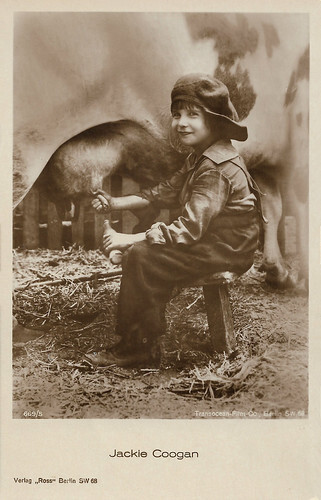
German postcard by Ross Verlag, Berlin, no. 669/5. Photo: Transocean Film-Co., Berlin. Jackie Coogan in Daddy (E. Mason Hopper, 1923).
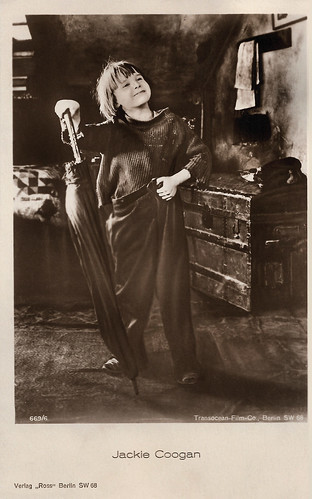
German postcard by Ross Verlag, Berlin, no. 669/6. Photo: Transocean Film Co., Berlin. Jackie Coogan in Daddy (E. Mason Hopper, 1923). Postcard sent in the former Kingdom of Serbs, Croats, and Slovenes (Yugoslavia).
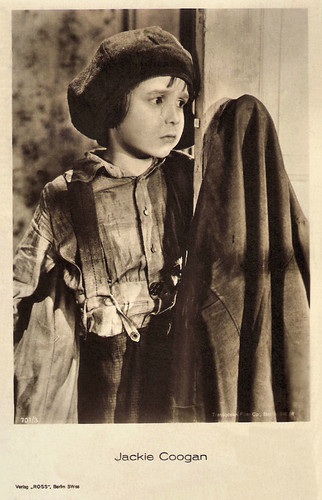
German postcard by Ross Verlag, Berlin, no. 701/3. Photo: Transocean-Film-Co., Berlin. Jackie Coogan in Daddy (E. Mason Hopper, 1923).
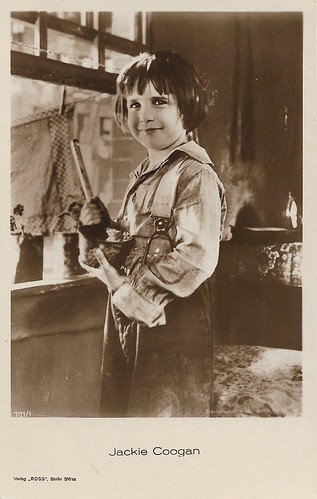
German postcard by Ross Verlag, no. 701/4. Photo: Transocean-Film-Co., Berlin. Jackie Coogan possibly in Daddy (E. Mason Hopper, 1923).
A Boy of Flanders (1924)
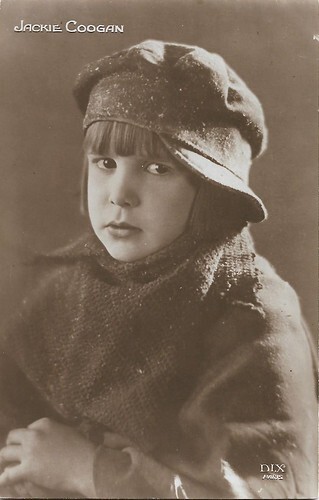
French postcard by Cinémagazine-Editions. Photo: DIX, Paris.
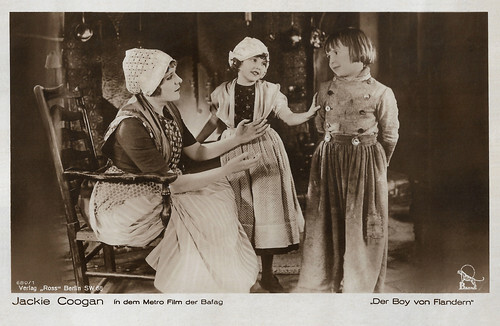
German postcard by Ross Verlag, no. 680/1, 1919-1924. Photo: Bafag / MGM. Jackie Coogan in A Boy of Flanders (Victor Schertzinger, MGM 1924), based on the novel by Ouida. The girl is Jeanne "Jean" Carpenter, who plays Alios Cogez, while the woman may be Nell Craig, who plays her mother, Marie Cogez.
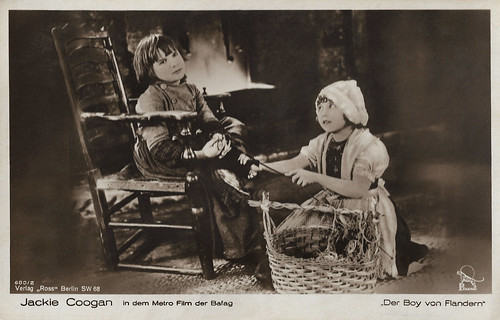
German postcard by Ross Verlag, no. 680/2, 1919-1924. Photo: Transocean-Film-Co., Berlin. Jackie Coogan in A Boy of Flanders (Victor Schertzinger, 1924).
The American drama A Boy of Flanders (Victor Schertzinger, 1924) is the second adaptation of the novel 'A Dog of Flanders' published in 1872 by the British author Ouida. The script was written by Max Abramson. The first adaptation was A Dog of Flanders (Howell Hansel, 1914) with Marguerite Snow as Nello.
The film was conceived as a vehicle for the young star, Jackie Coogan , who had starred successfully in Charlie Chaplin 's The Kid (1921) followed by My Boy (Victor Heerman, Albert Austin, 1921), Oliver Twist (Frank Lloyd, 1922) and Daddy (E. Mason Hopper, 1923). Coogan was the first child actor to play the leading role in this story. In the first version of 1914, the role had been entrusted to an actress.
The prominence given to the young star is also immediately apparent in the change of title from the original 'A Dog of Flanders' to 'A Boy of Flanders'. For the role of the dog, however, a superstar was chosen, Teddy the Dog ("Keystone Teddy, the Wonder Dog"), a canine celebrity of Hollywood cinema at the time, who had already starred in numerous short films, but also in successful films such as Stella Maris (Marshall Neilan, 1918) with Mary Pickford .
When his mother and grandfather die, Nello is left to be an orphan boy in the village of St Agnes. His only friend is Alois Cogez (Jeanne Carpenter), the daughter of the richest man in the village. Nello is sent away by her father (Lionel Belmore) and befriends the dog Patrasche. When Cogez's barn burns down, Nello is blamed. The villagers are about to send him to the orphanage when the famous painter Jan van Dullen arrives in the village.
Jan van Dullen (Josef Swickard) awards a prize for the best children's drawing. Because Nello's drawing is overlooked, another child wins the contest. Later, when Van Dullen notices the drawing, he goes looking for the boy during a snowstorm. Patrasche helps to find Nello, who is dying.
As in the 1914 version, A Boy of Flanders is given a happy ending, where the original story ended with the death of the boy and the dog. Eventually, Cogez decides to take the boy under his wing. In this way, Coogan can once again play his usual role of a poor orphan child who eventually finds happiness and a new family.
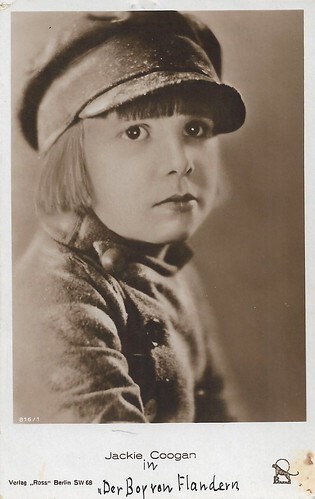
German postcard by Ross Verlag, Berlin, no. 816/1. Photo: Bafag / MGM. Jackie Coogan in A Boy of Flanders (Victor Schertzinger, 1924), based on the novel by Ouida.
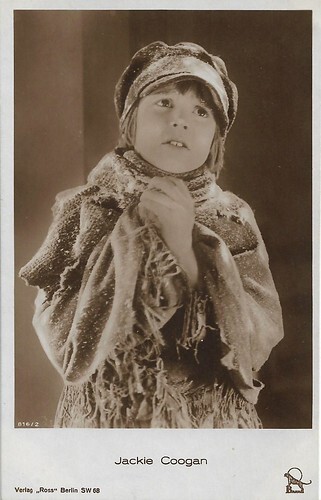
German postcard by Ross Verlag, Berlin, no. 816/2. Photo: Bafag / MGM. Jackie Coogan in A Boy of Flanders (Victor Schertzinger, 1924), based on the novel by Ouida.
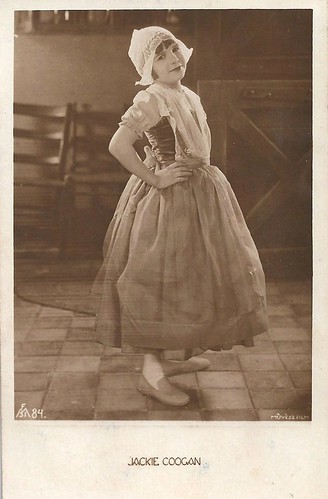
Hungarian postcard by FMSI, no. 84. Photo: Mûvèsz Film. In 1924 Coogan visited Budapest during his grand European tour. The photo refers to Coogan's outfit in A Boy of Flanders (Victor Schertzinger, 1924). Mûvèsz Film may have been the Hungarian distributor of that film.
Sources: Hans J. Wollstein (AllMovie), Movies Silently, Lugonian (IMDb), Wikipedia, and IMDb.
Oliver Twist (1922)

British postcard presented with The Penny Magazine. Photo: First National. Jackie Coogan in Oliver Twist (Frank Lloyd, 1922). “Please, sir, I want some more”.

French postcard by Cinémagazine-Edition. Photo: Jackie Coogan in Oliver Twist (Frank Lloyd, 1922).

German postcard by Ross Verlag, Berlin, no. 715/1. Photo: Transocean-Film-Co., Berlin. Jackie Coogan in Oliver Twist (Frank Lloyd, 1922).

German postcard by Ross Verlag, Berlin, no. 725/2. Photo: Transocean-Film Co., Berlin. Jackie Coogan in Oliver Twist (Frank Lloyd, 1922).
In Oliver Twist (Frank Lloyd, 1922), Jackie Coogan plays Charles Dickens' beloved orphan named Oliver Twist. Oliver's mother, a penniless outcast, died giving birth to him. As a young boy, Oliver is brought up in a workhouse, is deemed a troublemaker, and sent away to apprentice to an undertaker, Mr. Sowerberry (Nelson McDowell).
Then Oliver meets a pickpocket, Edouard Trebaol as The Artful Dodger, on the streets of London. From there, he joins a household of boys who are trained to steal for their master ( Lon Chaney as Fagin). Oliver also meets a burglar named Bill Sykes (George Siegmann) and a prostitute named Nancy (Gladys Brockwell). After realizing that his new friends are on the wrong side of the law, Oliver spends the rest of the film trying to escape them, all the while, his mysterious past is threatening to come to light…
Producer Sol Lesser of First National Pictures and the Coogan family correctly saw Charles Dickens' classic story as an excellent vehicle for their young star, who adds a touch of his own personality to the character. Lon Chaney had built his reputation as a villain and a master of makeup. Director Frank Lloyd had already successfully tackled Dickens in the Fox prestige production of A Tale of Two Cities. Jackie Coogan , Lon Chaney , and Frank Lloyd all get the job done. Once feared lost, a print was reportedly discovered in Yugoslavia in 1973. The print lacked intertitles, which were subsequently restored by Blackhawk Films with the help of Jackie Coogan and Sol Lesser.
Lugonian at IMDb : "many of the film's best moments belong to little Jackie. It's certainly hard to forget his sad facial emotions capturing the essence of Dickens's character, particularly one who's never experienced happiness. Even in a courtroom scene where the accused thief is forced to stand on a platform as he fights dizziness and keeping his eyes open to what's happening around him, brings forth emotional pity, though not by his stern judges.
Only when taken in by the wealthy Mr. Brownlow is he given that opportunity to find the true meaning of happiness and consider himself one of the family. Being abducted back to the gang of thieves who strip him of his luxury clothing and revert him back to his former pauper-looking appearance is quite an emotional impact for little Oliver, especially when in the clutches of the likes of Bill Sykes. No wonder Coogan became the most popular child actor of his time."

German postcard by Ross Verlag, no. 670/1, 1919-1924. Photo: Transocean-Film-Co., Berlin. Jackie Coogan as Oliver and Gertrude Claire as Mrs. Maylie in Oliver Twist (Frank Lloyd, 1922).

German postcard by Ross Verlag, no. 670/3, 1919-1924. Photo: Transocean Film-Co., Berlin. Jackie Coogan as Oliver and Edouard Trebaol as The Artful Dodger in Oliver Twist (Frank Lloyd, 1922).

German postcard by Ross Verlag, no. 670/5, 1919-1924. Photo: Transocean Film-Verleih. Jackie Coogan in Oliver Twist (Frank Lloyd, 1922). On the left, Edouard Trebaol as The Artful Dodger.

German postcard by Ross Verlag, Berlin, no. 670/6. Photo: Transocean-Film-Co., Berlin. Jackie Coogan in Oliver Twist (Frank Lloyd, 1922). The stout man on the right must be George Siegmann playing Bill Sykes.
Daddy (1923)

German postcard by Ross Verlag, no. 668/1, 1919-1924. Photo: Transocean Film-Co., Berlin. Jackie Coogan in Daddy (E. Mason Hopper, 1923) with Anna Townsend and Bert Woodruff.

German postcard by Ross Verlag, Berlin, no. 668/2. Photo: Transocean-Film-Co., Berlin. Jackie Coogan and Cesare Gravina in Daddy (E. Mason Hopper, 1923).

German postcard by Ross Verlag, Berlin, no. 668/4. Photo: Transocean-Film-Co., Berlin. Jackie Coogan and Cesare Gravina in Daddy (E. Mason Hopper, 1923).

German postcard by Ross Verlag, Berlin, no. 668/5. Photo: Transocean-Film-Co., Berlin. Jackie Coogan and Cesare Gravina in Daddy (E. Mason Hopper, 1923).

German postcard by Ross Verlag, Berlin, no. 668/6. Photo: Transocean-Film-Co., Berlin. Jackie Coogan and Cesare Gravina in Daddy (E. Mason Hopper, 1923).
Jackie Coogan 's parents, Jack and Lillian Coogan, wrote the script for the silent drama Daddy (E. Mason Hopper, 1923) for Associated First National Pictures. In fact, Daddy was a family affair, it was "A Jackie Coogan Production," "personally supervised by Jack Coogan".
Jackie plays the son of a poor violin teacher (Arthur Edmund Carewe) who is separated from his father when his parents break up their marriage. Believing her husband to be unfaithful, Helene Savelli (Josie Sedgwick) takes her little son Jackie (Coogan) to live on the Holden farm. Helene dies shortly thereafter and Jackie runs away from home when the Holdens (Bert Woodruff and Anna Townsend) are forced into the poorhouse. In the Big City, Jackie befriends Gallo (Cesare Gravina), a sidewalk musician who just happens to be the former teacher of world-famous violinist Paul Savelli, Jackie's long-lost father. Before he dies, Gallo manages not only to reunite father and son but restore the farm to the kindhearted Holdens.
Daddy was a commercial and critical success. It was the 5th highest-grossing American film of 1923 at the box office after Safety Last!.
The Daily Independent of Murphysboro, Illinois praised the full cast, believing Hopper's "directorial genius" to have brought out the best in everybody. They stated that Coogan possessed an "undiminished power" as a star which "draw[s] to him all classes and ages and both sexes".
The Daily Courier of Connellsville, Pennsylvania stated that the film is "richer in opportunities than any previous Jackie Coogan vehicle and reported that spectators at the theatres were "thrilled to hushed silence when little Jackie moved through the scene in which his guardian passes away and Jackie finds his real daddy". The newspaper declared that the film will "live in our memory forever".

German postcard by Ross Verlag, Berlin, no. 668/8. Photo: Transocean-Film-Co., Berlin. Jackie Coogan and Arthur Edmund Carewe in Daddy (E. Mason Hopper, 1923).

German postcard by Ross Verlag, no. 669/1, 1919-1924. Photo: Transocean-Film-Co., Berlin. Jackie Coogan in Daddy (1923).

German postcard by Ross Verlag, Berlin, no. 669/2. Photo: Transocean Film-Co., Berlin. Jackie Coogan in Daddy (E. Mason Hopper, 1923).

German postcard by Ross Verlag, Berlin, no. 669/3. Photo: Transocean Film-Co., Berlin. Jackie Coogan in Daddy (E. Mason Hopper, 1923).

German postcard by Ross Verlag, Berlin, no. 669/4. Photo: Transocean-Film-Co., Berlin. Jackie Coogan and his pet piglet in Daddy (E. Mason Hopper, 1923).

German postcard by Ross Verlag, Berlin, no. 669/5. Photo: Transocean Film-Co., Berlin. Jackie Coogan in Daddy (E. Mason Hopper, 1923).

German postcard by Ross Verlag, Berlin, no. 669/6. Photo: Transocean Film Co., Berlin. Jackie Coogan in Daddy (E. Mason Hopper, 1923). Postcard sent in the former Kingdom of Serbs, Croats, and Slovenes (Yugoslavia).

German postcard by Ross Verlag, Berlin, no. 701/3. Photo: Transocean-Film-Co., Berlin. Jackie Coogan in Daddy (E. Mason Hopper, 1923).

German postcard by Ross Verlag, no. 701/4. Photo: Transocean-Film-Co., Berlin. Jackie Coogan possibly in Daddy (E. Mason Hopper, 1923).
A Boy of Flanders (1924)

French postcard by Cinémagazine-Editions. Photo: DIX, Paris.

German postcard by Ross Verlag, no. 680/1, 1919-1924. Photo: Bafag / MGM. Jackie Coogan in A Boy of Flanders (Victor Schertzinger, MGM 1924), based on the novel by Ouida. The girl is Jeanne "Jean" Carpenter, who plays Alios Cogez, while the woman may be Nell Craig, who plays her mother, Marie Cogez.

German postcard by Ross Verlag, no. 680/2, 1919-1924. Photo: Transocean-Film-Co., Berlin. Jackie Coogan in A Boy of Flanders (Victor Schertzinger, 1924).
The American drama A Boy of Flanders (Victor Schertzinger, 1924) is the second adaptation of the novel 'A Dog of Flanders' published in 1872 by the British author Ouida. The script was written by Max Abramson. The first adaptation was A Dog of Flanders (Howell Hansel, 1914) with Marguerite Snow as Nello.
The film was conceived as a vehicle for the young star, Jackie Coogan , who had starred successfully in Charlie Chaplin 's The Kid (1921) followed by My Boy (Victor Heerman, Albert Austin, 1921), Oliver Twist (Frank Lloyd, 1922) and Daddy (E. Mason Hopper, 1923). Coogan was the first child actor to play the leading role in this story. In the first version of 1914, the role had been entrusted to an actress.
The prominence given to the young star is also immediately apparent in the change of title from the original 'A Dog of Flanders' to 'A Boy of Flanders'. For the role of the dog, however, a superstar was chosen, Teddy the Dog ("Keystone Teddy, the Wonder Dog"), a canine celebrity of Hollywood cinema at the time, who had already starred in numerous short films, but also in successful films such as Stella Maris (Marshall Neilan, 1918) with Mary Pickford .
When his mother and grandfather die, Nello is left to be an orphan boy in the village of St Agnes. His only friend is Alois Cogez (Jeanne Carpenter), the daughter of the richest man in the village. Nello is sent away by her father (Lionel Belmore) and befriends the dog Patrasche. When Cogez's barn burns down, Nello is blamed. The villagers are about to send him to the orphanage when the famous painter Jan van Dullen arrives in the village.
Jan van Dullen (Josef Swickard) awards a prize for the best children's drawing. Because Nello's drawing is overlooked, another child wins the contest. Later, when Van Dullen notices the drawing, he goes looking for the boy during a snowstorm. Patrasche helps to find Nello, who is dying.
As in the 1914 version, A Boy of Flanders is given a happy ending, where the original story ended with the death of the boy and the dog. Eventually, Cogez decides to take the boy under his wing. In this way, Coogan can once again play his usual role of a poor orphan child who eventually finds happiness and a new family.

German postcard by Ross Verlag, Berlin, no. 816/1. Photo: Bafag / MGM. Jackie Coogan in A Boy of Flanders (Victor Schertzinger, 1924), based on the novel by Ouida.

German postcard by Ross Verlag, Berlin, no. 816/2. Photo: Bafag / MGM. Jackie Coogan in A Boy of Flanders (Victor Schertzinger, 1924), based on the novel by Ouida.

Hungarian postcard by FMSI, no. 84. Photo: Mûvèsz Film. In 1924 Coogan visited Budapest during his grand European tour. The photo refers to Coogan's outfit in A Boy of Flanders (Victor Schertzinger, 1924). Mûvèsz Film may have been the Hungarian distributor of that film.
Sources: Hans J. Wollstein (AllMovie), Movies Silently, Lugonian (IMDb), Wikipedia, and IMDb.
Published on April 11, 2022 22:00
April 10, 2022
VerzamelJaarbeurs 2022: Paul's treasures
Now covid seems on the way back, the VerzamelJaarbeurs could finally return. On Saturday 9 and Sunday 10 April 2022, the Jaarbeurs halls in the city of Utrecht were transformed into the largest collectors' fair in Europe. Finally! The VerzamelJaarbeurs takes place twice a year, in the spring and in the autumn. You can find pretty much everything you can collect, from vintage furniture, a huge collection of vinyl, toys from the past and present, games, stamps, and lots of other beautiful curiosities and articles. Marlene, Ivo, and I were there to look for interesting film postcards for EFSP. Each of us will present you with 15 of the treasures we discovered in Utrecht. I will be the first to start.
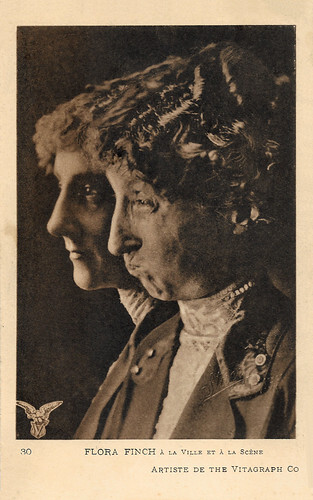
French postcard by Vitagraph Co, no. 30. Photo: Vitagraph Caption: Flora Finch in the city and on stage.
Extraordinarily tall and skinny British actress Flora Finch (1867-1940) was one of the early comedy stars of the silent-film era. Together with John Bunny, she made more than 250 short films for the Vitagraph Co. between 1910 and 1915.
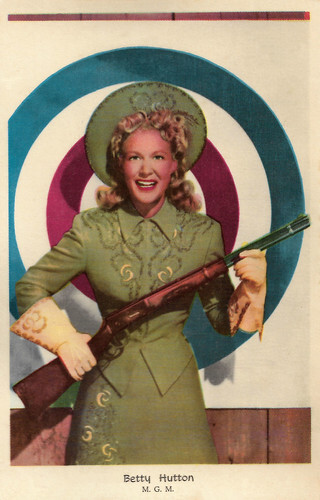
Vintage postcard. Photo: M.G.M. Betty Hutton in Annie Get Your Gun (George Sidney, 1950).
American actress Betty Hutton (1921-2007) was an energetic 'blonde bombshell' of the 1940s. She appeared in successful musicals and comedies, including The Miracle of Morgan's Creek (1943), Red, Hot and Blue (1949), Annie Get Your Gun (1950), and The Greatest Show on Earth (1952).
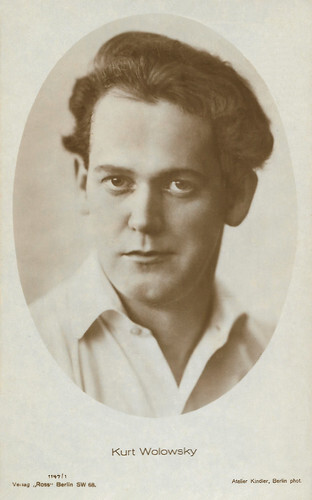
German postcard by Ross Verlag, no. 1147/1, 1927-1928. Photo: Kindler, Berlin.
Kurt Wolowsky (1897-1985), was a German actor, who mainly acted in German silent cinema. He was impressive as young Hoffmann in the classic Hoffmans Erzählungen/The Tales of Hoffmann (Richard Oswald, 1916), a liberal adaptation of Jacques Offenbach's opera, which in its turn was loosely based on E.T.A. Hoffmann's Tales.
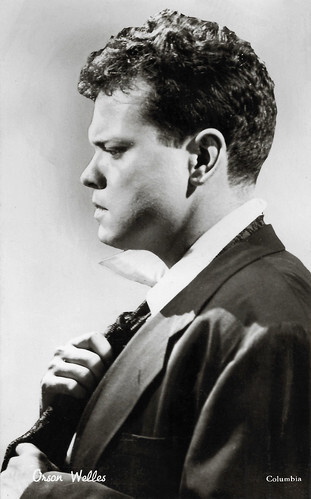
Vintage postcard. Photo: Columbia. Orson Welles in The Lady From Shanghai (Orson Welles, 1947).
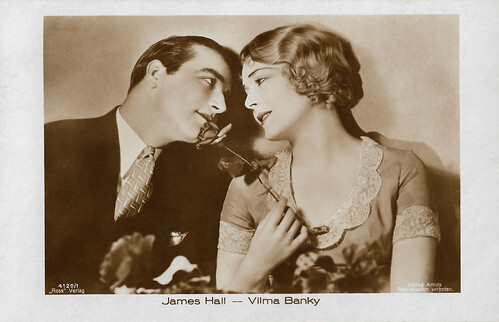
German postcard by Ross Verlag, no. 4120/1, 1929-1930. Photo: United Artists. James Hall and Vilma Banky in This is Heaven (Alfred Santell, 1929).
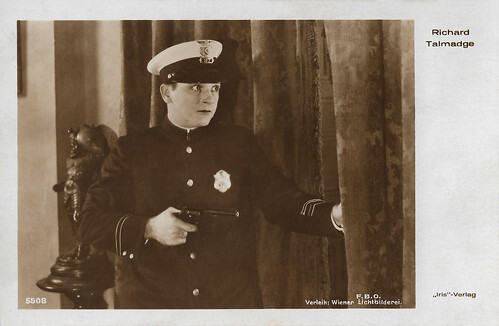
Austrian postcard by Iris Verlag, no. 5508. Photo: F.B.O. / Wiener Lichtbilderei. Richard Talmadge in The Night Patrol (Noel M. Smith, 1926).
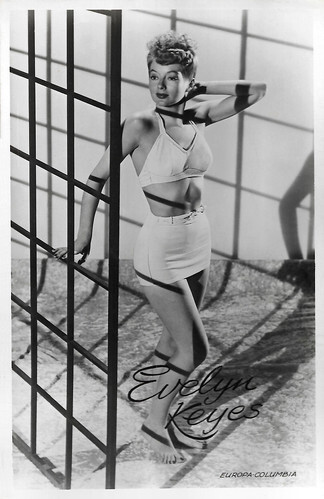
Dutch postcard, no. 3198. Photo: Europa Columbia.
Evelyn Keyes (1916-2008) was an American film actress. She is best known for her role as Suellen O'Hara in Gone with the Wind (1939) and for the female lead in the blockbuster hit The Jolson Story (1946). Her final film was The Seven Year's Itch (1955) starring Marilyn Monroe.
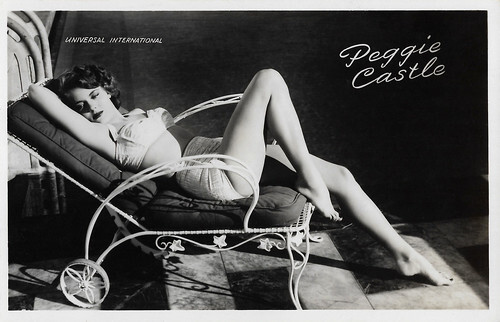
Dutch postcard by Takken, no. 461. Photo: Universal International.
Tall, sultry, green-eyed blonde Peggie Castle (1927-1973) was an American actress who specialised in playing the "other woman" in B-movies. Castle was Miss Cheesecake in 1949.
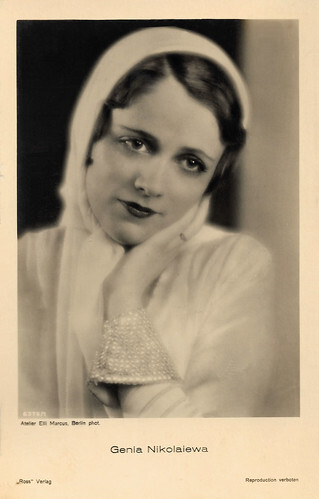
German postcard by Ross Verlag, no. 6375/1, 1931-1932. Photo: Elli Marcus, Berlin.
Russian-born ballet dancer and actress Genia Nikolaieva (1904-2001) worked in the German cinema during the 1930s. In 1938 she emigrated to the United States, where she became ‘one of the most beautiful studio secretaries for Warner Bros'.
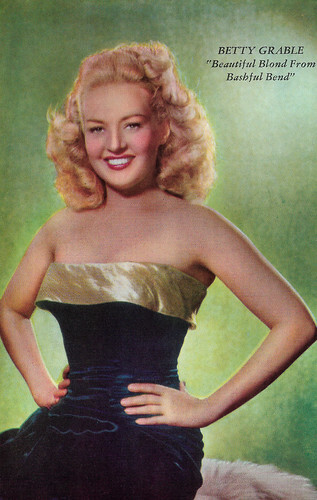
American by Movie Candid Color Card, Beverly Hills, Calif., no. A20. Photo: Frank Powolny (Kodachrome) / 20th Century. Caption: Betty Grable , whose singing and dancing have won her the top20th Century Fox and Hollywood stardom, is married to bandleader Harry James. They have two children.
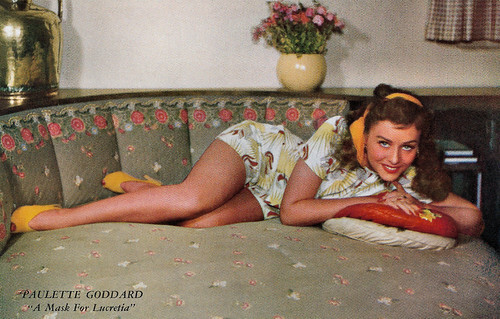
American postcard by Movie Candid Color Card, Beverly Hills, Calif., no. A18. Photo: Jack Albin (Kodachrome). Publicity still for Bride of Vengeance/A Mask for Lucretia (Mitchell Leisen, 1949). Caption: Paulette Goddard , former Ziegfeld girl, later cavorted for Samuel Goldwyn, and won stardom opposite Charlie Chaplin in Modern Times. Paulette really clicked at Paramount, where she teamed with Bob Hope, and followed with several starring roles for C.B. De Mille. Once married to Charlie Chaplin, she is now the wife of actor Burgess Meredith.
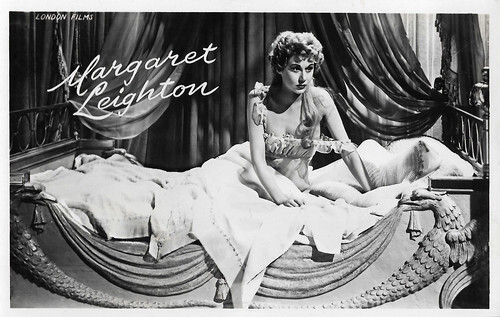
Vintage card. Photo: London Films. Margaret Leighton in The Elusive Pimpernel (Michael Powell, Emeric Pressburger, 1949).
Tall, reedy, thin-browed, light-haired Margaret Leighton (1922-1976) was a British award-winning theatre and film actress. She appeared with her future husband Michael Wilding in the Hitchcock film Under Capricorn (1949). She won two Tony Awards for Broadway performances as Best Actress (Dramatic): in 1957 for 'Separate Tables' and in 1962 for Tennessee Williams' 'The Night of the Iguana'. 'Leighton received an Oscar nomination and a BAFTA award for her role in The Go-Between (Joseph Losey, 1971). She also won an Emmy Award for a 1970 television version of 'Hamlet'.
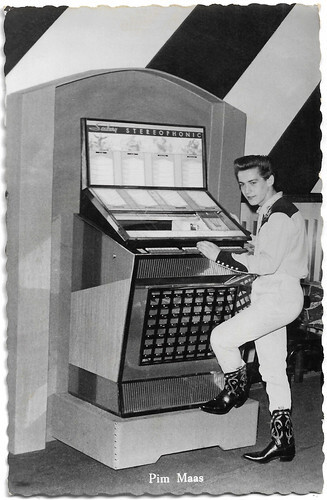
Dutch postcard by Weenenk & Snel, Baarn.
Pim Maas (1944) is a Dutch rock'n'roll singer and guitarist. In 1959, he won the Dutch Elvis Presley election, just before Ria Valk, who came in second. In the 1960s and 1970s, a number of singles by Maas were released and he performed with various accompaniment groups.
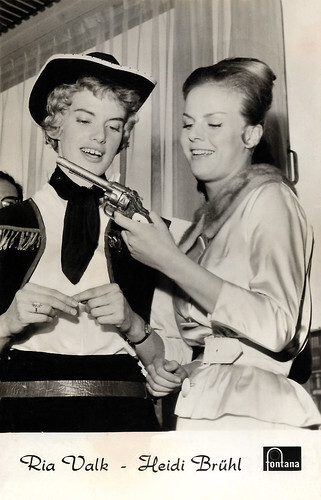
Dutch postcard by Gebr. Spanjersberg, Rotterdam, no. 6017. Photo: Fontana / Phonogram. Singers Ria Valk and Heidi Brühl during a promotional visit of the latter in the Netherlands.
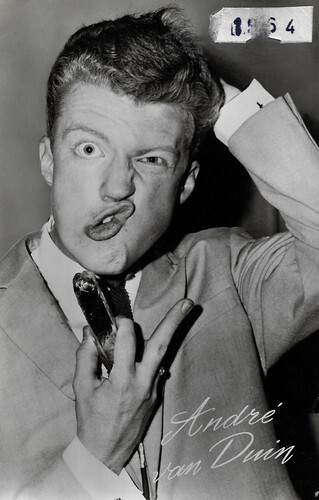
Dutch postcard by Uitgeverij Takken, Utrecht, no. AX 5985, 1964.
Funny-looking, reddish André van Duin (1947) is a famous comedian and actor in Dutch-speaking countries. He is also a singer, writer, and creator of television programs, and he starred in three Dutch film comedies.
Source: VerzamelJaarbeurs (Dutch).

French postcard by Vitagraph Co, no. 30. Photo: Vitagraph Caption: Flora Finch in the city and on stage.
Extraordinarily tall and skinny British actress Flora Finch (1867-1940) was one of the early comedy stars of the silent-film era. Together with John Bunny, she made more than 250 short films for the Vitagraph Co. between 1910 and 1915.

Vintage postcard. Photo: M.G.M. Betty Hutton in Annie Get Your Gun (George Sidney, 1950).
American actress Betty Hutton (1921-2007) was an energetic 'blonde bombshell' of the 1940s. She appeared in successful musicals and comedies, including The Miracle of Morgan's Creek (1943), Red, Hot and Blue (1949), Annie Get Your Gun (1950), and The Greatest Show on Earth (1952).

German postcard by Ross Verlag, no. 1147/1, 1927-1928. Photo: Kindler, Berlin.
Kurt Wolowsky (1897-1985), was a German actor, who mainly acted in German silent cinema. He was impressive as young Hoffmann in the classic Hoffmans Erzählungen/The Tales of Hoffmann (Richard Oswald, 1916), a liberal adaptation of Jacques Offenbach's opera, which in its turn was loosely based on E.T.A. Hoffmann's Tales.

Vintage postcard. Photo: Columbia. Orson Welles in The Lady From Shanghai (Orson Welles, 1947).

German postcard by Ross Verlag, no. 4120/1, 1929-1930. Photo: United Artists. James Hall and Vilma Banky in This is Heaven (Alfred Santell, 1929).

Austrian postcard by Iris Verlag, no. 5508. Photo: F.B.O. / Wiener Lichtbilderei. Richard Talmadge in The Night Patrol (Noel M. Smith, 1926).

Dutch postcard, no. 3198. Photo: Europa Columbia.
Evelyn Keyes (1916-2008) was an American film actress. She is best known for her role as Suellen O'Hara in Gone with the Wind (1939) and for the female lead in the blockbuster hit The Jolson Story (1946). Her final film was The Seven Year's Itch (1955) starring Marilyn Monroe.

Dutch postcard by Takken, no. 461. Photo: Universal International.
Tall, sultry, green-eyed blonde Peggie Castle (1927-1973) was an American actress who specialised in playing the "other woman" in B-movies. Castle was Miss Cheesecake in 1949.

German postcard by Ross Verlag, no. 6375/1, 1931-1932. Photo: Elli Marcus, Berlin.
Russian-born ballet dancer and actress Genia Nikolaieva (1904-2001) worked in the German cinema during the 1930s. In 1938 she emigrated to the United States, where she became ‘one of the most beautiful studio secretaries for Warner Bros'.

American by Movie Candid Color Card, Beverly Hills, Calif., no. A20. Photo: Frank Powolny (Kodachrome) / 20th Century. Caption: Betty Grable , whose singing and dancing have won her the top20th Century Fox and Hollywood stardom, is married to bandleader Harry James. They have two children.

American postcard by Movie Candid Color Card, Beverly Hills, Calif., no. A18. Photo: Jack Albin (Kodachrome). Publicity still for Bride of Vengeance/A Mask for Lucretia (Mitchell Leisen, 1949). Caption: Paulette Goddard , former Ziegfeld girl, later cavorted for Samuel Goldwyn, and won stardom opposite Charlie Chaplin in Modern Times. Paulette really clicked at Paramount, where she teamed with Bob Hope, and followed with several starring roles for C.B. De Mille. Once married to Charlie Chaplin, she is now the wife of actor Burgess Meredith.

Vintage card. Photo: London Films. Margaret Leighton in The Elusive Pimpernel (Michael Powell, Emeric Pressburger, 1949).
Tall, reedy, thin-browed, light-haired Margaret Leighton (1922-1976) was a British award-winning theatre and film actress. She appeared with her future husband Michael Wilding in the Hitchcock film Under Capricorn (1949). She won two Tony Awards for Broadway performances as Best Actress (Dramatic): in 1957 for 'Separate Tables' and in 1962 for Tennessee Williams' 'The Night of the Iguana'. 'Leighton received an Oscar nomination and a BAFTA award for her role in The Go-Between (Joseph Losey, 1971). She also won an Emmy Award for a 1970 television version of 'Hamlet'.

Dutch postcard by Weenenk & Snel, Baarn.
Pim Maas (1944) is a Dutch rock'n'roll singer and guitarist. In 1959, he won the Dutch Elvis Presley election, just before Ria Valk, who came in second. In the 1960s and 1970s, a number of singles by Maas were released and he performed with various accompaniment groups.

Dutch postcard by Gebr. Spanjersberg, Rotterdam, no. 6017. Photo: Fontana / Phonogram. Singers Ria Valk and Heidi Brühl during a promotional visit of the latter in the Netherlands.

Dutch postcard by Uitgeverij Takken, Utrecht, no. AX 5985, 1964.
Funny-looking, reddish André van Duin (1947) is a famous comedian and actor in Dutch-speaking countries. He is also a singer, writer, and creator of television programs, and he starred in three Dutch film comedies.
Source: VerzamelJaarbeurs (Dutch).
Published on April 10, 2022 22:00
April 9, 2022
Published by M. Bonnist & Zonen
M. Bonnist & Zonen was a Dutch publishing company located in Amsterdam. The name of the publisher is sometimes abbreviated to M.B. & Z. During the 1920s and 1930s, Bonnist published hundreds of film postcards. The firm published several postcards for the blossoming Dutch film industry of the 1930s but also postcards with star portraits or film scenes of popular Hollywood and European films.

Dutch postcard by M. Bonnist & Zonen, no. 115. Renée Adorée and John Gilbert in The Big Parade (King Vidor, 1925). Collection: Marlene Pilaete.
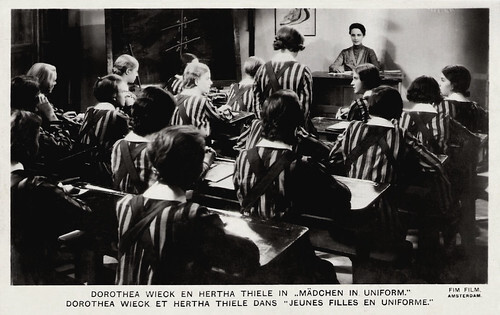
Dutch Postcard by M. Bonnist & Zonen, Amsterdam, Z., no. 104 e. Photo: Fim Film, Amsterdam. Dorothea Wieck and Hertha Thiele in Mädchen in Uniform/Girls in Uniform (Leontine Sagan, Carl Froelich, 1931).
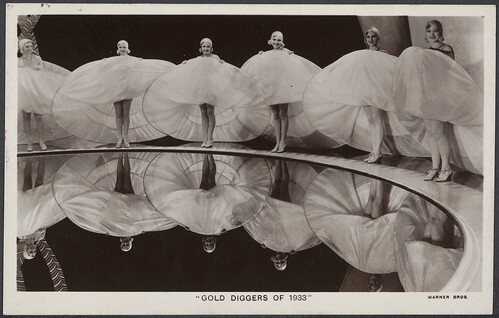
Dutch postcard by M. Bonnist & Zonen Amsterdam. Photo: Warner Bros. Publicity still for Golddiggers of 1933 (Mervyn LeRoy, 1933). Collection: Amsterdam EYE Filmmuseum.
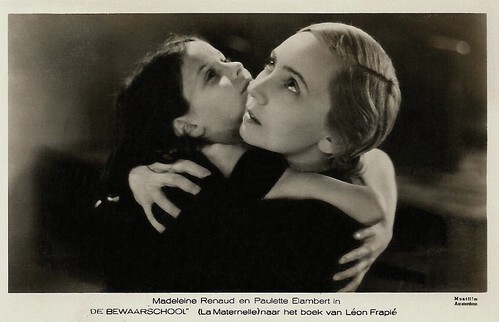
Dutch postcard by M.B.& Z. (M. Bonnist & Zonen). Photo: Muntfilm, Amsterdam. Madeleine Renaud and Paulette Élambert in La Maternelle (1933). The card bears the stamp of the Dutch National Board of Film Censors.
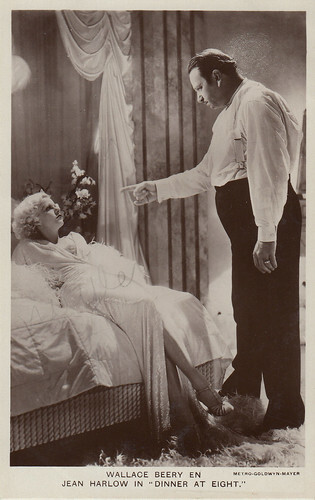
Dutch postcard by M. Bonnist & Zonen, no. B335. Photo: M.G.M. Jean Harlow and Wallace Beery in Dinner at Eight (George Cukor, 1933). Collection: Marlene Pilaete.
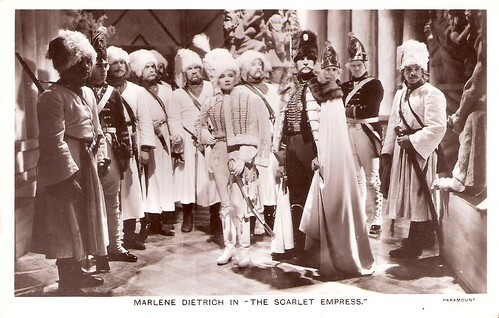
British-Dutch postcard by M. Bonnist & Zonen, Amsterdam, no. B 351. Photo: Paramount. Publicity still for The Scarlet Empress (Josef von Sternberg, 1934) with Marlene Dietrich as Catherine the Great, the notorious Empress of Russia.
The only importer of international film star photos
Maurits Bonnist (1871-1935) started out in Amsterdam as a diamond cutter but later set up a publishing company in advertising, photographs, and reproductions.
One of his sons, David (Donald) Maurits Bonnist, joined the company in 1924. In 1939, he and his bride Serine van Embden (an artist) went to America on their honeymoon. Unable to return to their homeland due to the war, Bonnist resigned from the parent company in Holland and the following year founded the Donald Art Company in America.
At the international exhibition 'Klank en Beeld' (Sound and Vision) in Amsterdam in 1932, M. Bonnist & Sons had a stand. In a newspaper article, the firm was described as follows: "The firm M. Bonnist & Sons in Amsterdam is the only importer of international film star photos. It has more than a thousand different ones!"
The Bonnist cards have the regular postcard size (14 x 9 cm). And there are not any colorised motifs in the collection. The motifs show excellent quality and most do have an edge around.
The individual card numbers can't be seen on the front sides, they are listed on the reverse sides. Besides unnumbered cards, two numbered series can be distinguished: Numbers 100 to 135 without a B in front of the number. Number B136 to B499. There are both cards of film stars and of film scenes.
Very popular stars in the Netherlands during the 1930s were Marlene Dietrich and Greta Garbo. Bonnist & Zonen paid tribute to Garbo with 100 postcards showing her unique beauty to the whole world.
Maurits Bonnist died in 1935. His wife, Elisabeth Bonnist-Vredenburg, was killed in the Nazi extermination camp Sobibor in 1943. Their children Jules and Willy died in 1941.
Donald survived the war in the US. In the following decades, his American firm Donald Art Company grew to be recognised as one of the leading picture publishing companies in the world. Donald Bonnist passed away in 1986.
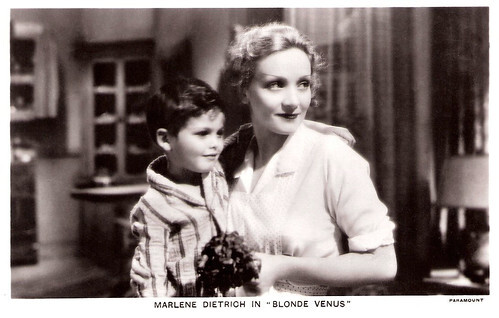
British postcard, distributed in the Netherlands by M. Bonnist & Zonen, Amsterdam, no. 136e. Photo: Paramount. Marlene Dietrich and Dickie Moore in Blonde Venus (Josef von Sternberg, 1932).
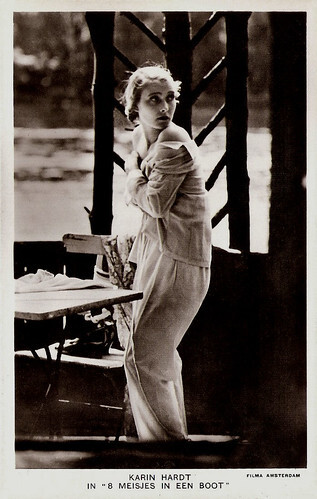
Dutch postcard by M. Bonnist & Zonen, Amsterdam, no. 146. Photo: Filma, Amsterdam. Karin Hardt in Acht Mädels im Boot/Eight Girls in a Boat (Erich Waschneck, 1932).
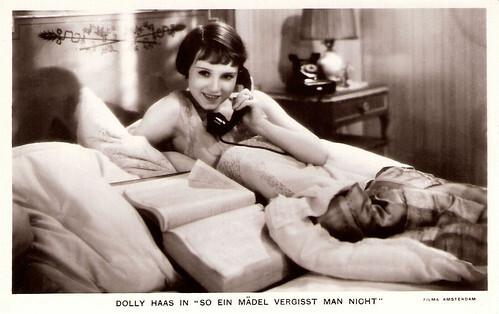
Dutch postcard by M. Bonnist & Zonen, Amsterdam, Z., no. B 168. Photo: Filma, Amsterdam. Dolly Haas in So ein Mädel vergisst man nicht/A Girl You Don't Forget (Fritz Kortner, 1932).
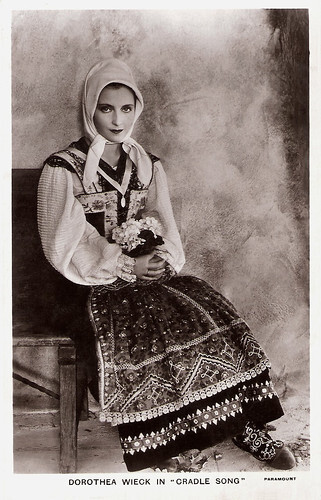
Dutch postcard by M. Bonnist & Zonen, Amsterdam-Z., no. B 299. Photo: Paramount. Dorothea Wieck in Cradle Song (Mitchell Leisen, 1933).
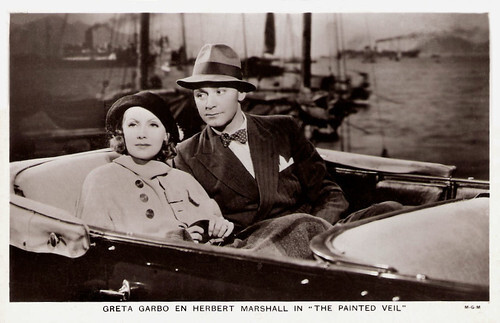
Dutch postcard by M. Bonnist & Zonen, Amsterdam, no. B 422. Photo: MGM. Greta Garbo and Herbert Marshall in The Painted Veil (Richard Boleslawski, 1934).
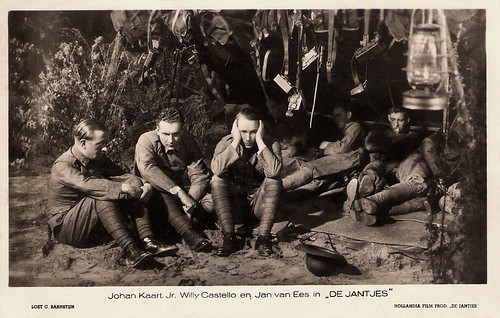
Dutch postcard by M. B.& Z. (M. Bonnist & Zonen, Amsterdam). Photo: Hollandia Film Prod. / Loet C. Barnstijn. Johan Kaart jr. , Willy Costello and Jan van Ees in De Jantjes/The Tars (Jaap Speyer, 1934).
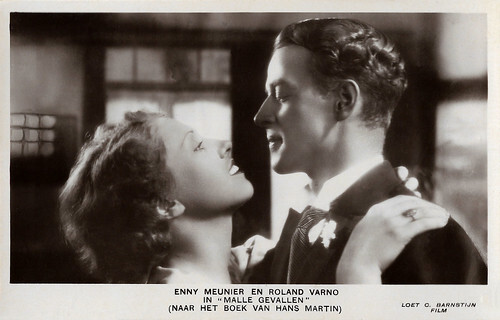
Dutch postcard by M. B.& Z. (M. Bonnist & Zonen, Amsterdam), no. 10. Photo: Loet C. Barnstijn Film. Enny Meunier and Roland Varno in Malle gevallen/Ludicrous Events (Jaap Speyer, 1934).
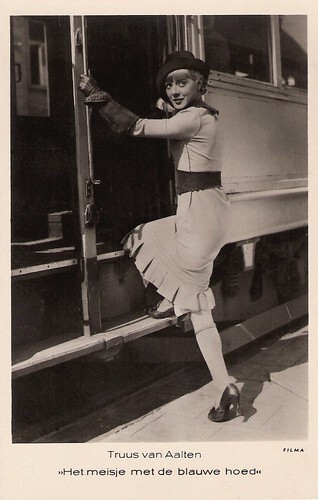
Dutch postcard by M. B. & Z. (M. Bonnist & Zonen, Amsterdam). Photo: Filma. Truus van Aalten in Het meisje met den blauwen hoed/The girl with the blue hat (Rudolf Meinert, 1934). Collection: Geoffrey Donaldson Institute.
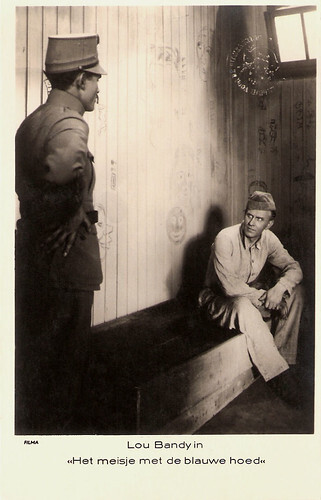
Dutch postcard by M. B. & Z. (M. Bonnist & Zonen, Amsterdam). Photo: Filma. Lou Bandy in Het Meisje met de Blauwe Hoed/The girl with the blue hat (Rudolf Meinert, 1934).
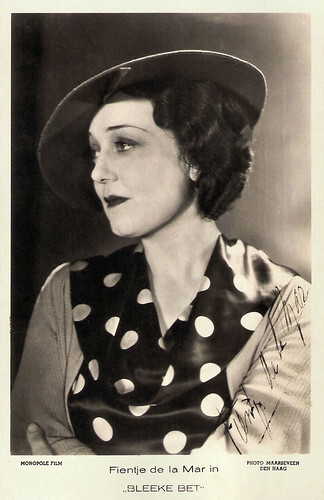
Dutch postcard by M. B. & Z. (M. Bonnist & Zonen, Amsterdam). Photo: Dick van Maarseveen, Den Haag / Monopole Film. Fien de la Mar in Bleeke Bet/Pale Betty (Alex Benno, Richard Oswald, 1934). Collection: Geoffrey Donaldson Institute.
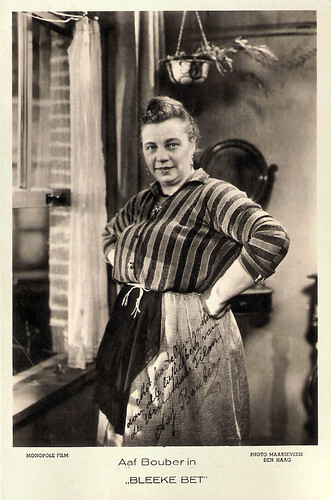
Dutch postcard by M.B. & Z. (M. Bonnist & Zonen, Amsterdam). Photo: Dick van Maarseveen, Den Haag / Monopole Film. Aaf Bouber in Bleeke Bet (Alex Benno, Richard Oswald, 1934). Collection: Geoffrey Donaldson Institute.
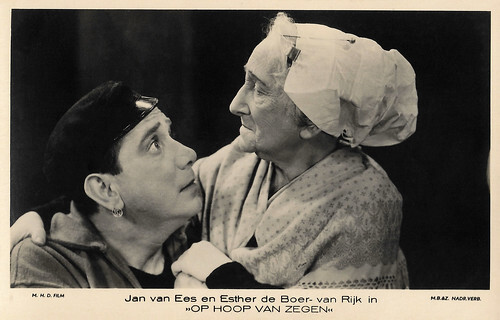
Dutch postcard by M.B. & Z. (M. Bonnist & Zonen, Amsterdam). Photo: Dick van Maarseveen, Den Haag / M.H.D. Film. Jan van Ees and Esther de Boer-van Rijk in Op Hoop van Zegen/The Good Hope (Alex Benno, Louis Saalborn, 1934).
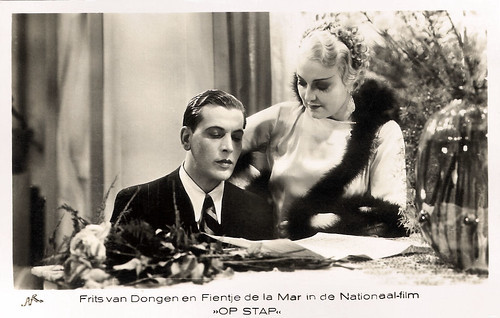
Dutch postcard by M.B. & Z. (M. Bonnist & Zonen, Amsterdam). Photo: Dick van Maarseveen, Den Haag / Nationaal Film. Frits van Dongen and Fien de la Mar in Op stap/On the Move (Ernst Winar, 1935).
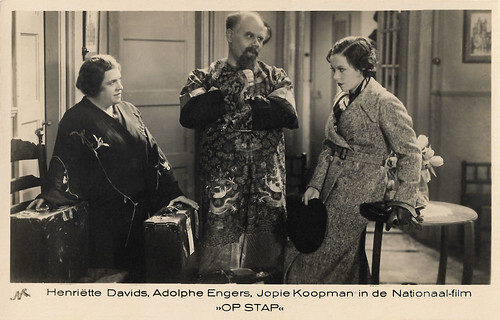
Dutch postcard by M.B. & Z. (M. Bonnist & Zonen, Amsterdam). Photo: Dick van Maarseveen, Den Haag / Nationaal Film. Henriëtte Davids , Adolphe Engers and Jopie Koopman in Op stap/On the Move (Ernst Winar, 1935).
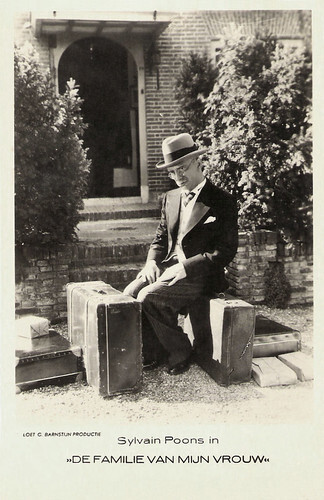
Dutch postcard by M. B.& Z. (M. Bonnist & Zonen, Amsterdam). Photo: Loet C. Barnstijn Productie. Sylvain Poons in De familie van mijn vrouw/My Wife's Family (1935).
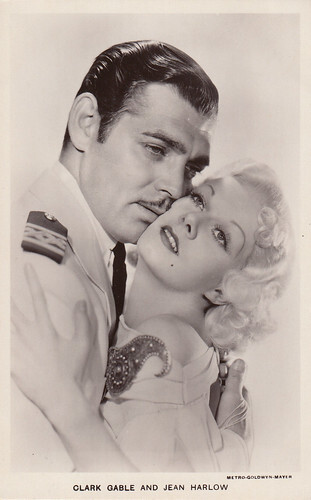
Dutch postcard by M. Bonnist & Zonen, Amsterdam, no. B 447. Photo: M.G.M. Jean Harlow and Clark Gable in China Seas (Tay Garnett, 1935). Collection: Marlene Pilaete.
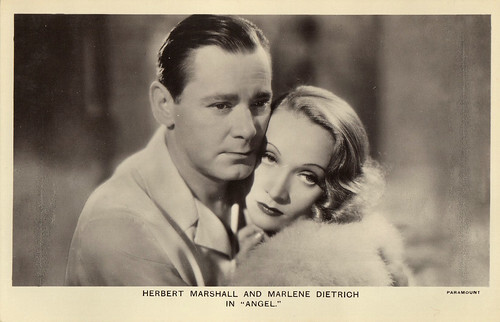
Dutch postcard by M. Bonnist & Zonen, Amsterdam, no. B 480. Photo: Paramount. Herbert Marshall and Marlene Dietrich in Angel (Ernst Lubitsch, 1937). Collection: Marlene Pilaete.
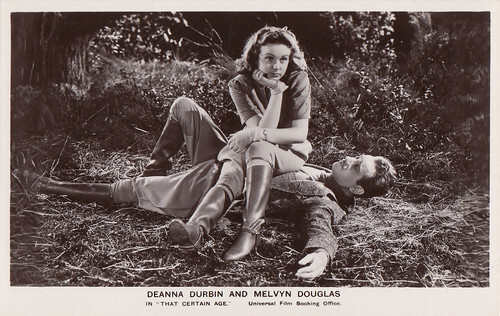
Dutch postcard by M. Bonnist & Zonen, no. 115. Photo: Universal. Deanna Durbin and Melvyn Douglas in That Certain Age (Edward Ludwig, 1938). Collection: Marlene Pilaete.
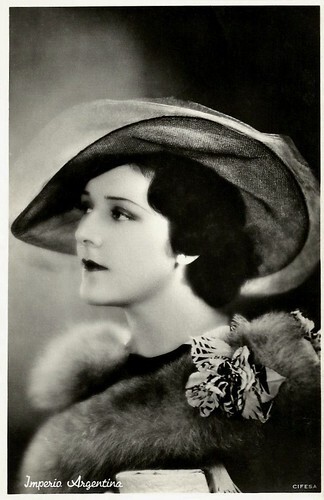
Dutch postcard. M.B.& Z. (M. Bonnist & Zonen, Amsterdam), no. 199. Photo: Cifesa. Imperio Argentina . Cifesa was a big Spanish distribution company between the mid-1930s and the early 1960s.
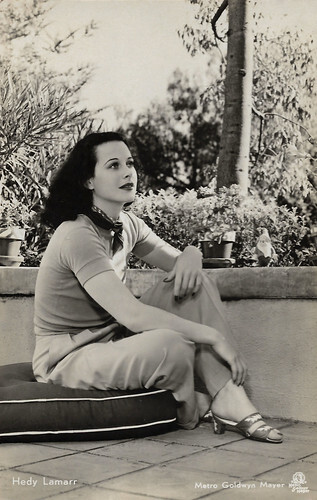
Dutch postcard by M. B. & Z. (M. Bonnist & Zonen, Amsterdam), no. 1059. Photo: Metro-Goldwyn-Mayer. Hedy Lamarr .
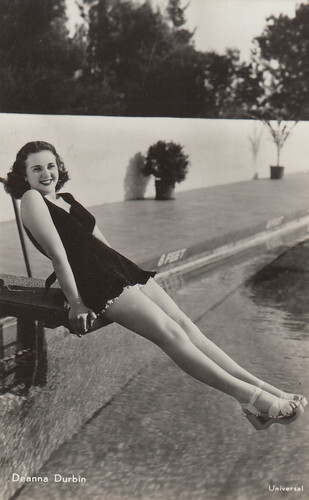
Dutch postcard by M. B. & Z. (M. Bonnist & Zonen, Amsterdam), no. 1076. Photo: Universal. Deanna Durbin . Collection: Marlene Pilaete.
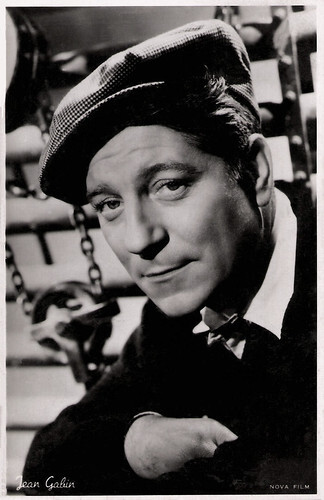
Dutch postcard by M. B. & Z. (M. Bonnist & Zonen, Amsterdam), no. 1206. Photo: Raymond Voinquel / Nova Film. Jean Gabin in Le jour se lève/Daybreak (Marcel Carne, 1939).
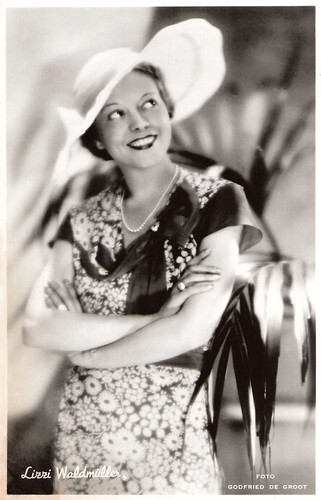
Dutch postcard by M. B. & Z. (M. Bonnist & Zonen, Amsterdam), no. 1215. Photo: Godfried de Groot. Lizzi Waldmüller .
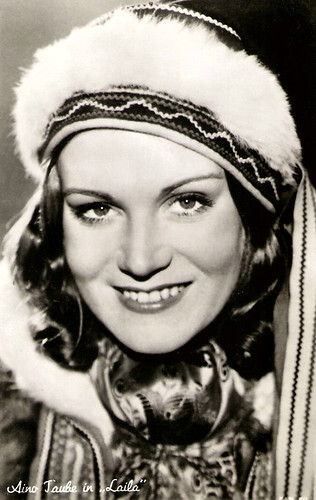
Dutch postcard by M. B. & Z. (M. Bonnist & Zonen, Amsterdam), no. 1224. Photo: Fan Film. Aino Taube in Laila (George Schnéevoigt, 1937).
Sources: Lodewijk van Duuren (VDP - Dutch), The Donald Art Company, and Garbo Forever.

Dutch postcard by M. Bonnist & Zonen, no. 115. Renée Adorée and John Gilbert in The Big Parade (King Vidor, 1925). Collection: Marlene Pilaete.

Dutch Postcard by M. Bonnist & Zonen, Amsterdam, Z., no. 104 e. Photo: Fim Film, Amsterdam. Dorothea Wieck and Hertha Thiele in Mädchen in Uniform/Girls in Uniform (Leontine Sagan, Carl Froelich, 1931).

Dutch postcard by M. Bonnist & Zonen Amsterdam. Photo: Warner Bros. Publicity still for Golddiggers of 1933 (Mervyn LeRoy, 1933). Collection: Amsterdam EYE Filmmuseum.

Dutch postcard by M.B.& Z. (M. Bonnist & Zonen). Photo: Muntfilm, Amsterdam. Madeleine Renaud and Paulette Élambert in La Maternelle (1933). The card bears the stamp of the Dutch National Board of Film Censors.

Dutch postcard by M. Bonnist & Zonen, no. B335. Photo: M.G.M. Jean Harlow and Wallace Beery in Dinner at Eight (George Cukor, 1933). Collection: Marlene Pilaete.

British-Dutch postcard by M. Bonnist & Zonen, Amsterdam, no. B 351. Photo: Paramount. Publicity still for The Scarlet Empress (Josef von Sternberg, 1934) with Marlene Dietrich as Catherine the Great, the notorious Empress of Russia.
The only importer of international film star photos
Maurits Bonnist (1871-1935) started out in Amsterdam as a diamond cutter but later set up a publishing company in advertising, photographs, and reproductions.
One of his sons, David (Donald) Maurits Bonnist, joined the company in 1924. In 1939, he and his bride Serine van Embden (an artist) went to America on their honeymoon. Unable to return to their homeland due to the war, Bonnist resigned from the parent company in Holland and the following year founded the Donald Art Company in America.
At the international exhibition 'Klank en Beeld' (Sound and Vision) in Amsterdam in 1932, M. Bonnist & Sons had a stand. In a newspaper article, the firm was described as follows: "The firm M. Bonnist & Sons in Amsterdam is the only importer of international film star photos. It has more than a thousand different ones!"
The Bonnist cards have the regular postcard size (14 x 9 cm). And there are not any colorised motifs in the collection. The motifs show excellent quality and most do have an edge around.
The individual card numbers can't be seen on the front sides, they are listed on the reverse sides. Besides unnumbered cards, two numbered series can be distinguished: Numbers 100 to 135 without a B in front of the number. Number B136 to B499. There are both cards of film stars and of film scenes.
Very popular stars in the Netherlands during the 1930s were Marlene Dietrich and Greta Garbo. Bonnist & Zonen paid tribute to Garbo with 100 postcards showing her unique beauty to the whole world.
Maurits Bonnist died in 1935. His wife, Elisabeth Bonnist-Vredenburg, was killed in the Nazi extermination camp Sobibor in 1943. Their children Jules and Willy died in 1941.
Donald survived the war in the US. In the following decades, his American firm Donald Art Company grew to be recognised as one of the leading picture publishing companies in the world. Donald Bonnist passed away in 1986.

British postcard, distributed in the Netherlands by M. Bonnist & Zonen, Amsterdam, no. 136e. Photo: Paramount. Marlene Dietrich and Dickie Moore in Blonde Venus (Josef von Sternberg, 1932).

Dutch postcard by M. Bonnist & Zonen, Amsterdam, no. 146. Photo: Filma, Amsterdam. Karin Hardt in Acht Mädels im Boot/Eight Girls in a Boat (Erich Waschneck, 1932).

Dutch postcard by M. Bonnist & Zonen, Amsterdam, Z., no. B 168. Photo: Filma, Amsterdam. Dolly Haas in So ein Mädel vergisst man nicht/A Girl You Don't Forget (Fritz Kortner, 1932).

Dutch postcard by M. Bonnist & Zonen, Amsterdam-Z., no. B 299. Photo: Paramount. Dorothea Wieck in Cradle Song (Mitchell Leisen, 1933).

Dutch postcard by M. Bonnist & Zonen, Amsterdam, no. B 422. Photo: MGM. Greta Garbo and Herbert Marshall in The Painted Veil (Richard Boleslawski, 1934).

Dutch postcard by M. B.& Z. (M. Bonnist & Zonen, Amsterdam). Photo: Hollandia Film Prod. / Loet C. Barnstijn. Johan Kaart jr. , Willy Costello and Jan van Ees in De Jantjes/The Tars (Jaap Speyer, 1934).

Dutch postcard by M. B.& Z. (M. Bonnist & Zonen, Amsterdam), no. 10. Photo: Loet C. Barnstijn Film. Enny Meunier and Roland Varno in Malle gevallen/Ludicrous Events (Jaap Speyer, 1934).

Dutch postcard by M. B. & Z. (M. Bonnist & Zonen, Amsterdam). Photo: Filma. Truus van Aalten in Het meisje met den blauwen hoed/The girl with the blue hat (Rudolf Meinert, 1934). Collection: Geoffrey Donaldson Institute.

Dutch postcard by M. B. & Z. (M. Bonnist & Zonen, Amsterdam). Photo: Filma. Lou Bandy in Het Meisje met de Blauwe Hoed/The girl with the blue hat (Rudolf Meinert, 1934).

Dutch postcard by M. B. & Z. (M. Bonnist & Zonen, Amsterdam). Photo: Dick van Maarseveen, Den Haag / Monopole Film. Fien de la Mar in Bleeke Bet/Pale Betty (Alex Benno, Richard Oswald, 1934). Collection: Geoffrey Donaldson Institute.

Dutch postcard by M.B. & Z. (M. Bonnist & Zonen, Amsterdam). Photo: Dick van Maarseveen, Den Haag / Monopole Film. Aaf Bouber in Bleeke Bet (Alex Benno, Richard Oswald, 1934). Collection: Geoffrey Donaldson Institute.

Dutch postcard by M.B. & Z. (M. Bonnist & Zonen, Amsterdam). Photo: Dick van Maarseveen, Den Haag / M.H.D. Film. Jan van Ees and Esther de Boer-van Rijk in Op Hoop van Zegen/The Good Hope (Alex Benno, Louis Saalborn, 1934).

Dutch postcard by M.B. & Z. (M. Bonnist & Zonen, Amsterdam). Photo: Dick van Maarseveen, Den Haag / Nationaal Film. Frits van Dongen and Fien de la Mar in Op stap/On the Move (Ernst Winar, 1935).

Dutch postcard by M.B. & Z. (M. Bonnist & Zonen, Amsterdam). Photo: Dick van Maarseveen, Den Haag / Nationaal Film. Henriëtte Davids , Adolphe Engers and Jopie Koopman in Op stap/On the Move (Ernst Winar, 1935).

Dutch postcard by M. B.& Z. (M. Bonnist & Zonen, Amsterdam). Photo: Loet C. Barnstijn Productie. Sylvain Poons in De familie van mijn vrouw/My Wife's Family (1935).

Dutch postcard by M. Bonnist & Zonen, Amsterdam, no. B 447. Photo: M.G.M. Jean Harlow and Clark Gable in China Seas (Tay Garnett, 1935). Collection: Marlene Pilaete.

Dutch postcard by M. Bonnist & Zonen, Amsterdam, no. B 480. Photo: Paramount. Herbert Marshall and Marlene Dietrich in Angel (Ernst Lubitsch, 1937). Collection: Marlene Pilaete.

Dutch postcard by M. Bonnist & Zonen, no. 115. Photo: Universal. Deanna Durbin and Melvyn Douglas in That Certain Age (Edward Ludwig, 1938). Collection: Marlene Pilaete.

Dutch postcard. M.B.& Z. (M. Bonnist & Zonen, Amsterdam), no. 199. Photo: Cifesa. Imperio Argentina . Cifesa was a big Spanish distribution company between the mid-1930s and the early 1960s.

Dutch postcard by M. B. & Z. (M. Bonnist & Zonen, Amsterdam), no. 1059. Photo: Metro-Goldwyn-Mayer. Hedy Lamarr .

Dutch postcard by M. B. & Z. (M. Bonnist & Zonen, Amsterdam), no. 1076. Photo: Universal. Deanna Durbin . Collection: Marlene Pilaete.

Dutch postcard by M. B. & Z. (M. Bonnist & Zonen, Amsterdam), no. 1206. Photo: Raymond Voinquel / Nova Film. Jean Gabin in Le jour se lève/Daybreak (Marcel Carne, 1939).

Dutch postcard by M. B. & Z. (M. Bonnist & Zonen, Amsterdam), no. 1215. Photo: Godfried de Groot. Lizzi Waldmüller .

Dutch postcard by M. B. & Z. (M. Bonnist & Zonen, Amsterdam), no. 1224. Photo: Fan Film. Aino Taube in Laila (George Schnéevoigt, 1937).
Sources: Lodewijk van Duuren (VDP - Dutch), The Donald Art Company, and Garbo Forever.
Published on April 09, 2022 22:00
April 8, 2022
The Flapper
In the 1920s, there was a new generation of self-confident women who cut their hair short in a bob, listened to jazz, and scorned what was considered acceptable and common behaviour at the time. Flappers wore heavy make-up, short skirts, drank heavily, smoked, drove cars, and had an easier time of it than the norm. There was something challenging, cheeky, and provocative about them. Social and sexual norms were generally flouted. Their attitude towards men was emancipated to an unprecedented degree for that time. They were also important for the coming-out and emancipation of lesbians. Well-known flappers included film stars Joan Crawford, Clara Bow, Louise Brooks, Colleen Moore, and Norma Talmadge.

German postcard by Ross-Verlag, no. 3980/3, 1928-1929. Photo: Paramount.
American actress Clara Bow (1905-1965) rose to stardom in silent film during the 1920s. It was her appearance as a plucky shopgirl in the film It (Clarence G. Badger, 1927) that brought her global fame and the nickname 'The It Girl'. Bow came to personify the Roaring Twenties and is described as its leading sex symbol.

German postcard by Ross Verlag, no. 3510/1, 1928-1929. Photo: Paramount.

Austrian postcard by Iris Verlag, no. 6575. Photo: Max Munn Autrey / Fox. Collection: Marlene Pilaete.
Stunning Olive Borden (1906-1947) was considered one of the most beautiful actresses of the silent era. At 15, she started as a Mack Sennett bathing beauty and reached the peak of her career in 1926 when she made 11 films for Fox Studios and was earning $1,500 a week. She was nicknamed "the Joy Girl", after playing the lead in the 1927 film of that same title, but soon her career waned.
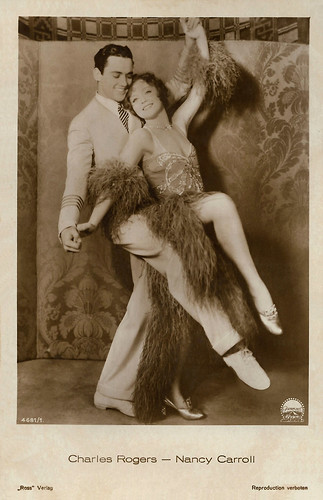
German postcard by Ross Verlag, no. 4681/1, 1929-1930. Photo: Paramount. Charles Rogers and Nancy Carroll in Close Harmony (John Cromwell, A. Edward Sutherland, 1929).
Red-haired, cupid-bow-mouthed Nancy Carroll (1903-1965) became a very popular Hollywood star upon the advent of sound film because of her singing and dancing abilities. She was reported to have received more fan mail than any of her Hollywood peers of the same era. As she expanded her acting range from flaming flapper to ditzy comedienne to sensitive heroine, she was nominated for an Oscar for The Devil's Holiday (1930).
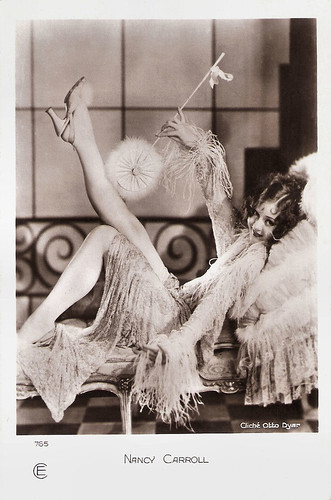
French postcard by Cinémagazine-Edition, no. 765. Photo: Otto Dyar.
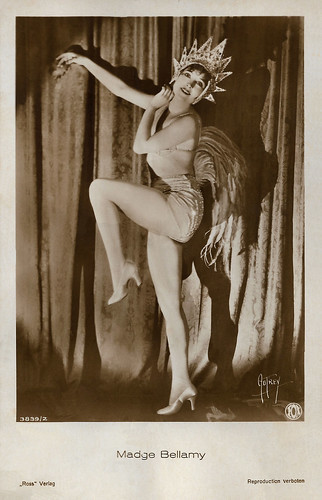
German postcard by Ross Verlag, no. 3839/2, 1928-1929. Photo: Max Munn Autrey / Fox Film.
Madge Bellamy (1899-1990) was a beautiful and temperamental leading lady of the silent era, known for such classics as John Ford's first Western The Iron Horse (1924). Because of her off-set temperament, she was nicknamed "Miss Firecracker". She appeared in about fifty silent films and also in a dozen sound films, including the cult favourite White Zombie (1932). By the late 1930s, her film career had virtually ended, but in 1943 she became again fodder for the press when she was arrested for shooting her former lover.
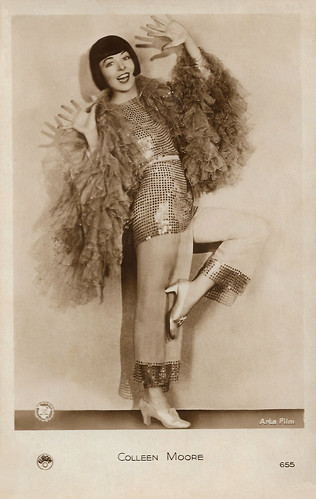
French postcard by Europe, no. 655. Photo: First National / Arta Film.
American actress Colleen Moore (1899-1988) was a star of the silent screen who appeared in about 100 films beginning in 1917. During the 1920s, she put her stamp on American social history, creating in dozens of films the image of the wide-eyed, insouciant flapper with her bobbed hair and short skirts.
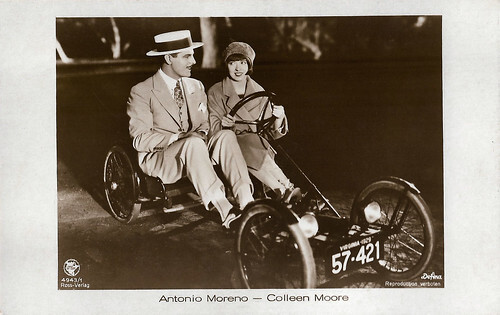
German postcard by Ross Verlag, no. 4943/1, 1929-1930. Photo: First National Pictures / Defina. Colleen Moore and Antonio Moreno in Synthetic Sin (William A. Seiter, 1929).
That's the bee's knees
The Flapper style originated in the 1920s in the United States during the period of Prohibition, in illegal bars (speakeasies), where religiously inspired abstinence and authority, in general, were scorned. The flapper lifestyle became especially popular in England and the United States.
The flapper was the model for an entirely new style of fashion that included the end of the corset and the rise of the pantyhose. Sarah Pruitt at History.com: "Flappers wore their skirts shorter so they could show off their legs and ankles—but also so they could dance. They particularly loved the Charleston, a 1920s dance craze involving waving arms and fast-moving feet that had been pioneered by African Americans, first in the South and later in Harlem. Dancing proved challenging in traditional women’s fashion, not only with long dresses, but also traditional corsets that tightly bound a woman’s midsection and accentuated her waist."
Around 1923, French designer Coco Chanel introduced what became known as the “garçonne look”, featuring not just high hemlines but dropped or nonexistent waistlines and straight, sleeveless tops. With lighter and more flexible undergarments that created a straight, slim silhouette, this new design allowed women to dance freely. Flappers wore heavy make-up, short skirts, drank heavily, smoked, and drove cars.
The first appearance of the flapper style in the United States came from the popular Frances Marion film, The Flapper (Alan Crosland, 1920), starring Olive Thomas. The flapper-girls also had their own slang, with words and phrases all their own, such as 'snugglepup' (a man who often goes to parties), 'barney-mugging' (sexy), or 'That's the bee's knees' (that's great) and 'That's so Jake'.
Famous flappers included actresses Joan Crawford , Clara Bow, Louise Brooks , Colleen Moore , Norma Talmadge , Carla Laemmle, and authoress Zelda Fitzgerald, whose husband F. Scott Fitzgerald paid much attention to the flapper style in his work. Cartoon characters such as Minnie Mouse and Betty Boop were also inspired by the flapper style.
In Europe, the French dancer Mistinguett was a well-known flapper, who introduced the bob hairstyle at the Moulin Rouge (cabaret) in 1921. In Berlin around 1930, the Swiss writer and photographer Annemarie Schwarzenbach and the German writer and actress Ruth Landshoff-Yorck were at the centre of a circle of free-spirited flapper girls. Flappers are icons of the Roaring Twenties, the social, political turbulence and increased transatlantic cultural exchange that followed the end of World War I, as well as the export of American jazz culture to Europe. With the Great Depression, the flapper style gradually disappeared.
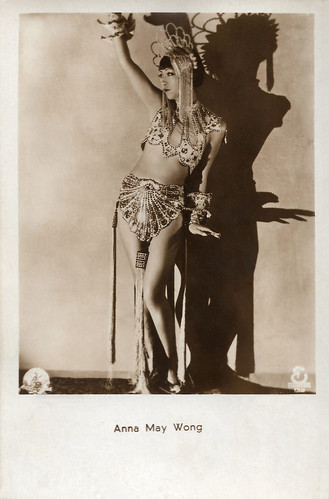
Austrian postcard by Iris-Verlag, no. 5853. Photo: British International Pictures (BIP). Anna May Wong in Piccadilly (Ewald André Dupont, 1929).
Anna May Wong (1905-1961) was the first Chinese American movie star, and the first Asian American actress to gain international recognition. Frustrated by the stereotypical supporting roles she reluctantly played in Hollywood, Wong left for Europe, where she starred in such classics as Piccadilly (1929). Richard Corliss in Time: “Wong is a luminous presence, fanning her arms in right-angle gestures that seem both Oriental and flapperish."
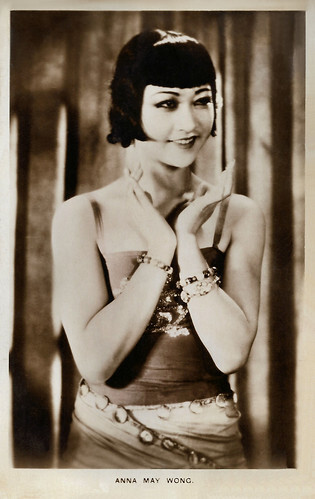
British postcard in the Colourgraph Series, London, no. C 7.
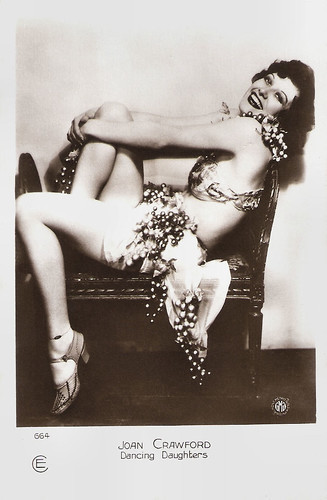
French postcard by Cinémagazine-Edition, no. 664. Photo: MGM. Joan Crawford in Our Dancing Daughters (Harry Beaumont, 1928).
American actress Joan Crawford (1905-1977) became nationally known as a flapper by the end of the 1920s. In the 1930s, her fame rivaled, and later outlasted, MGM colleagues Norma Shearer and Greta Garbo. Crawford often played hardworking young women who find romance and success.
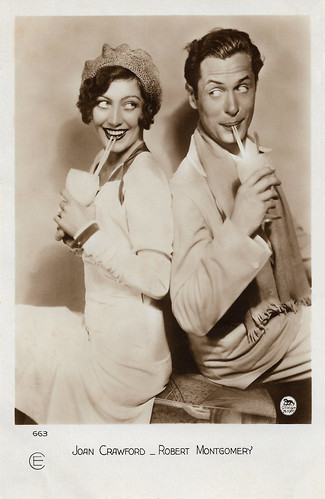
French postcard by Cinémagazine-Edition, Paris, no. 663. Photo: Metro-Goldwyn-Mayer. Joan Crawford and Robert Montgomery in Untamed (Jack Conway, 1929). Collection: Geoffrey Donaldson Institute.
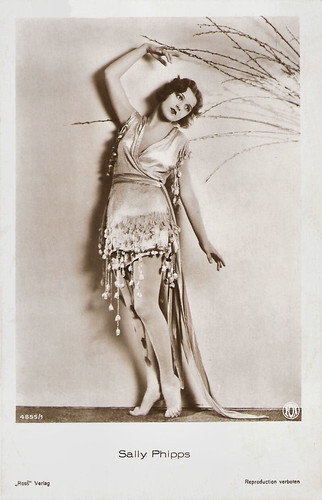
German postcard by Ross Verlag, no. 4855/1, 1929-1930. Photo: Fox Film.
American actress Sally Phipps (1911-1978) had just completed high school when she was selected as a Wampas Baby Star in 1927. As a little kid, she already had made three short films with the legendary film cowboy Broncho Billy, like Broncho Billy and the Baby (Gilbert M. 'Broncho Billy' Anderson, 1915). Her first role as Sally Phipps was in Bertha, the Sewing Machine Girl (Irving Cummings, 1926). Soon she completed appearances in Girls (Eugene Forde, 1927), Love Makes 'Em Wild (Albert Ray, 1927), and Gentlemen Prefer Scotch (George Marshall, 1927). In August 1927 she signed a five-year contract with Fox Film. The sound film probably finished the brief screen career of Sally Phipps.
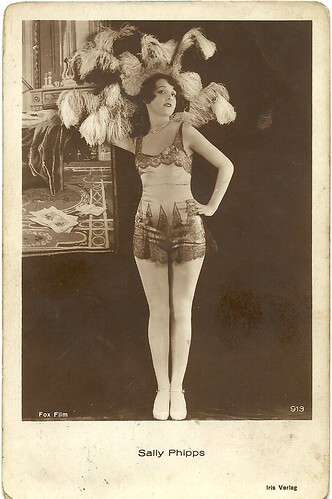
Austrian postcard by Iris Verlag, no. 813. Photo: Fox Film. Collection: Didier Hanson.
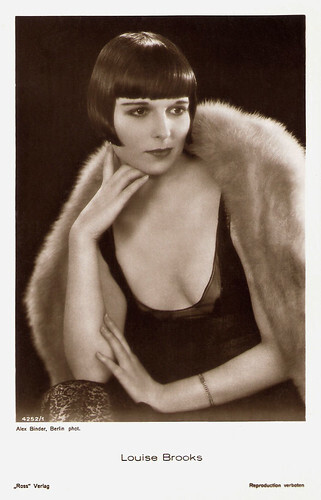
German postcard by Ross Verlag, no. 4252/1, 1929-1930. Photo: Alex Binder, Berlin.
Legendary American dancer and actress Louise Brooks (1906-1985) set the trend of the bobbed haircut and personified the flapper, the rebellious young woman of the 1920s. She played the lead in three European silent film classics: Die Büchse der Pandora/Pandora's Box (1929), Tagebuch einer Verlorenen/Diary of a Lost Girl (1929), and Prix de Beauté/Miss Europe (1930).
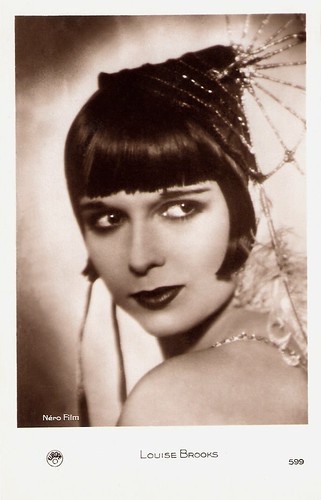
French postcard by Europe, no. 599. Photo: Néro Film.
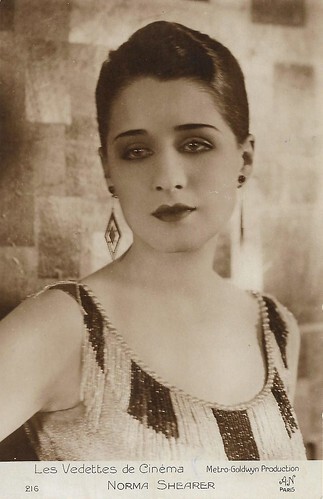
French postcard in the Les Vedettes de Cinéma Series by A.N., Paris, no. 216. Photo: Metro-Goldwyn Production. Norma Shearer in the - lost - silent film A Slave of Fashion (Hobart Henley, 1925).
American actress Norma Shearer (1902-1983) was the 'First Lady of MGM'. She often played spunky, sexually liberated ingenues, and was the first person to be nominated five times for an Academy Award for acting. Shearer won the Best Actress Oscar for The Divorcee (1930).
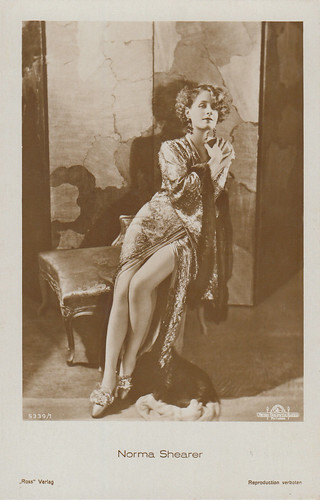
German postcard by Ross Verlag, no. 5339/1, 1930-1931. Photo: George Hurrell / Metro-Goldwyn-Mayer. Publicity still for Let Us Be Gay (Robert Z. Leonard, 1930). Collection: Marlene Pilaete.
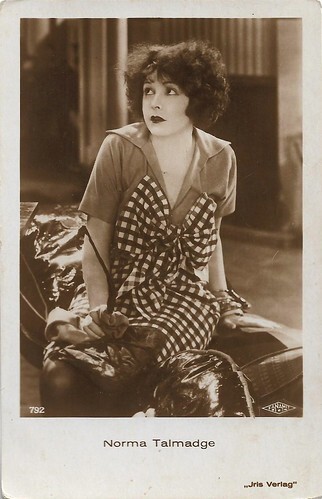
Austrian postcard by Iris Verlag, no. 792. Photo: Fanamet.
Norma Talmadge (1894-1957) was an American actress and film producer of the silent era. A major box-office draw for more than a decade, her career reached a peak in the early 1920s, when she ranked among the most popular idols of the American screen.
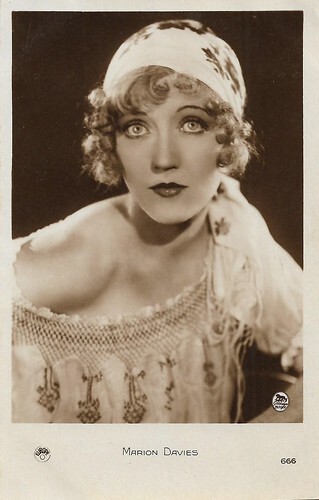
French postcard by Europe, no. 666. Photo: Metro-Goldwyn-Mayer.
Marion Davies (1897-1961) was one of the great comedic actresses of the silent era. She starred in nearly four dozen films between 1917 and 1937.
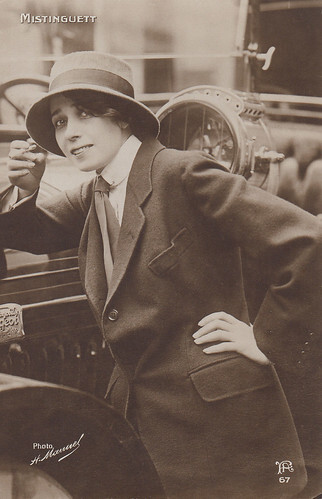
French postcard, no. 67. Photo: H. Manuel. Collection: Marlene Pilaete.
French actress and singer Mistinguett (1875-1956) captivated Paris with her risqué routines. She went on to become the most popular French entertainer of her time and the highest-paid female entertainer in the world. She appeared more than 60 times in the cinema. During a tour of the United States, she was asked by Time magazine to explain her popularity. Her answer was: "It is a kind of magnetism. I say 'Come closer' and draw them to me."
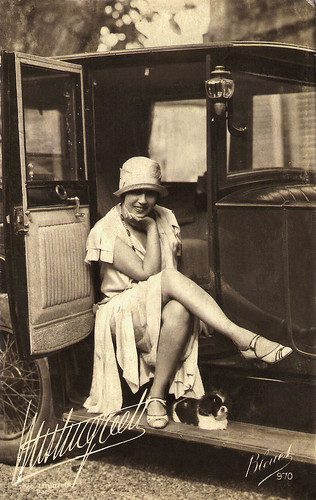
French postcard by Bleuet, no. 970. Photo: Unibsein (?), Paris.
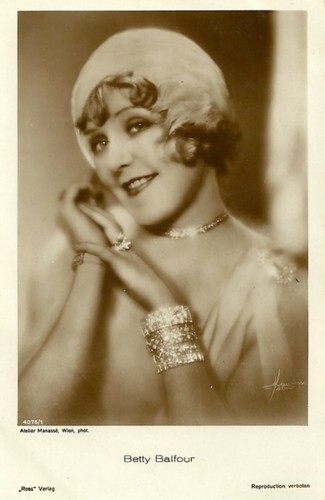
German postcard by Ross Verlag, no. 4076/1, 1929-1930. Photo: Atelier Manassé, Vienna.
Gamine-like silent screen star Betty Balfour (1903-1977) was the ‘British Mary Pickford’. She was a great mimic who started in Music Hall and became known as ‘Britain's Queen of Happiness’. During the 1920s, Balfour was Britain’s most popular actress.
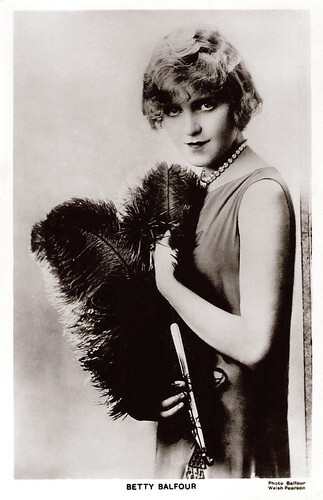
British postcard in the Picturegoer Series, London, no. 226. Sent by mail in Great Britain in 1928. Photo: Balfour Welsh Pearson.
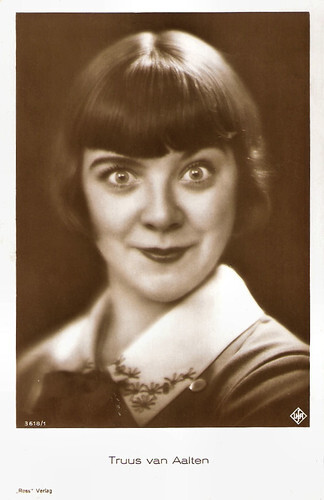
German postcard by Ross Verlag, no. 3618/1, 1928-1929. Photo: Ufa. Collection: Geoffrey Donaldson Institute.
Dutch film star Truus van Aalten (1910-1999) made 29 films in the 1920s and 1930s, and only one of them she made in the Netherlands.
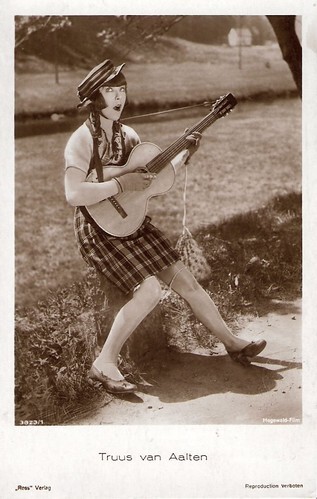
German postcard by Ross Verlag, no. 3823/1, 1928-1929. Photo: Hegewald Film. Truus van Aalten in Die lustigen Vagabunden/The funny vagabonds (Jacob and Luise Fleck, 1928). Collection: Geoffrey Donaldson Institute.
Sources: Sarah Pruitt (History.com), Wikipedia (Dutch and English).

German postcard by Ross-Verlag, no. 3980/3, 1928-1929. Photo: Paramount.
American actress Clara Bow (1905-1965) rose to stardom in silent film during the 1920s. It was her appearance as a plucky shopgirl in the film It (Clarence G. Badger, 1927) that brought her global fame and the nickname 'The It Girl'. Bow came to personify the Roaring Twenties and is described as its leading sex symbol.

German postcard by Ross Verlag, no. 3510/1, 1928-1929. Photo: Paramount.

Austrian postcard by Iris Verlag, no. 6575. Photo: Max Munn Autrey / Fox. Collection: Marlene Pilaete.
Stunning Olive Borden (1906-1947) was considered one of the most beautiful actresses of the silent era. At 15, she started as a Mack Sennett bathing beauty and reached the peak of her career in 1926 when she made 11 films for Fox Studios and was earning $1,500 a week. She was nicknamed "the Joy Girl", after playing the lead in the 1927 film of that same title, but soon her career waned.

German postcard by Ross Verlag, no. 4681/1, 1929-1930. Photo: Paramount. Charles Rogers and Nancy Carroll in Close Harmony (John Cromwell, A. Edward Sutherland, 1929).
Red-haired, cupid-bow-mouthed Nancy Carroll (1903-1965) became a very popular Hollywood star upon the advent of sound film because of her singing and dancing abilities. She was reported to have received more fan mail than any of her Hollywood peers of the same era. As she expanded her acting range from flaming flapper to ditzy comedienne to sensitive heroine, she was nominated for an Oscar for The Devil's Holiday (1930).

French postcard by Cinémagazine-Edition, no. 765. Photo: Otto Dyar.

German postcard by Ross Verlag, no. 3839/2, 1928-1929. Photo: Max Munn Autrey / Fox Film.
Madge Bellamy (1899-1990) was a beautiful and temperamental leading lady of the silent era, known for such classics as John Ford's first Western The Iron Horse (1924). Because of her off-set temperament, she was nicknamed "Miss Firecracker". She appeared in about fifty silent films and also in a dozen sound films, including the cult favourite White Zombie (1932). By the late 1930s, her film career had virtually ended, but in 1943 she became again fodder for the press when she was arrested for shooting her former lover.

French postcard by Europe, no. 655. Photo: First National / Arta Film.
American actress Colleen Moore (1899-1988) was a star of the silent screen who appeared in about 100 films beginning in 1917. During the 1920s, she put her stamp on American social history, creating in dozens of films the image of the wide-eyed, insouciant flapper with her bobbed hair and short skirts.

German postcard by Ross Verlag, no. 4943/1, 1929-1930. Photo: First National Pictures / Defina. Colleen Moore and Antonio Moreno in Synthetic Sin (William A. Seiter, 1929).
That's the bee's knees
The Flapper style originated in the 1920s in the United States during the period of Prohibition, in illegal bars (speakeasies), where religiously inspired abstinence and authority, in general, were scorned. The flapper lifestyle became especially popular in England and the United States.
The flapper was the model for an entirely new style of fashion that included the end of the corset and the rise of the pantyhose. Sarah Pruitt at History.com: "Flappers wore their skirts shorter so they could show off their legs and ankles—but also so they could dance. They particularly loved the Charleston, a 1920s dance craze involving waving arms and fast-moving feet that had been pioneered by African Americans, first in the South and later in Harlem. Dancing proved challenging in traditional women’s fashion, not only with long dresses, but also traditional corsets that tightly bound a woman’s midsection and accentuated her waist."
Around 1923, French designer Coco Chanel introduced what became known as the “garçonne look”, featuring not just high hemlines but dropped or nonexistent waistlines and straight, sleeveless tops. With lighter and more flexible undergarments that created a straight, slim silhouette, this new design allowed women to dance freely. Flappers wore heavy make-up, short skirts, drank heavily, smoked, and drove cars.
The first appearance of the flapper style in the United States came from the popular Frances Marion film, The Flapper (Alan Crosland, 1920), starring Olive Thomas. The flapper-girls also had their own slang, with words and phrases all their own, such as 'snugglepup' (a man who often goes to parties), 'barney-mugging' (sexy), or 'That's the bee's knees' (that's great) and 'That's so Jake'.
Famous flappers included actresses Joan Crawford , Clara Bow, Louise Brooks , Colleen Moore , Norma Talmadge , Carla Laemmle, and authoress Zelda Fitzgerald, whose husband F. Scott Fitzgerald paid much attention to the flapper style in his work. Cartoon characters such as Minnie Mouse and Betty Boop were also inspired by the flapper style.
In Europe, the French dancer Mistinguett was a well-known flapper, who introduced the bob hairstyle at the Moulin Rouge (cabaret) in 1921. In Berlin around 1930, the Swiss writer and photographer Annemarie Schwarzenbach and the German writer and actress Ruth Landshoff-Yorck were at the centre of a circle of free-spirited flapper girls. Flappers are icons of the Roaring Twenties, the social, political turbulence and increased transatlantic cultural exchange that followed the end of World War I, as well as the export of American jazz culture to Europe. With the Great Depression, the flapper style gradually disappeared.

Austrian postcard by Iris-Verlag, no. 5853. Photo: British International Pictures (BIP). Anna May Wong in Piccadilly (Ewald André Dupont, 1929).
Anna May Wong (1905-1961) was the first Chinese American movie star, and the first Asian American actress to gain international recognition. Frustrated by the stereotypical supporting roles she reluctantly played in Hollywood, Wong left for Europe, where she starred in such classics as Piccadilly (1929). Richard Corliss in Time: “Wong is a luminous presence, fanning her arms in right-angle gestures that seem both Oriental and flapperish."

British postcard in the Colourgraph Series, London, no. C 7.

French postcard by Cinémagazine-Edition, no. 664. Photo: MGM. Joan Crawford in Our Dancing Daughters (Harry Beaumont, 1928).
American actress Joan Crawford (1905-1977) became nationally known as a flapper by the end of the 1920s. In the 1930s, her fame rivaled, and later outlasted, MGM colleagues Norma Shearer and Greta Garbo. Crawford often played hardworking young women who find romance and success.

French postcard by Cinémagazine-Edition, Paris, no. 663. Photo: Metro-Goldwyn-Mayer. Joan Crawford and Robert Montgomery in Untamed (Jack Conway, 1929). Collection: Geoffrey Donaldson Institute.

German postcard by Ross Verlag, no. 4855/1, 1929-1930. Photo: Fox Film.
American actress Sally Phipps (1911-1978) had just completed high school when she was selected as a Wampas Baby Star in 1927. As a little kid, she already had made three short films with the legendary film cowboy Broncho Billy, like Broncho Billy and the Baby (Gilbert M. 'Broncho Billy' Anderson, 1915). Her first role as Sally Phipps was in Bertha, the Sewing Machine Girl (Irving Cummings, 1926). Soon she completed appearances in Girls (Eugene Forde, 1927), Love Makes 'Em Wild (Albert Ray, 1927), and Gentlemen Prefer Scotch (George Marshall, 1927). In August 1927 she signed a five-year contract with Fox Film. The sound film probably finished the brief screen career of Sally Phipps.

Austrian postcard by Iris Verlag, no. 813. Photo: Fox Film. Collection: Didier Hanson.

German postcard by Ross Verlag, no. 4252/1, 1929-1930. Photo: Alex Binder, Berlin.
Legendary American dancer and actress Louise Brooks (1906-1985) set the trend of the bobbed haircut and personified the flapper, the rebellious young woman of the 1920s. She played the lead in three European silent film classics: Die Büchse der Pandora/Pandora's Box (1929), Tagebuch einer Verlorenen/Diary of a Lost Girl (1929), and Prix de Beauté/Miss Europe (1930).

French postcard by Europe, no. 599. Photo: Néro Film.

French postcard in the Les Vedettes de Cinéma Series by A.N., Paris, no. 216. Photo: Metro-Goldwyn Production. Norma Shearer in the - lost - silent film A Slave of Fashion (Hobart Henley, 1925).
American actress Norma Shearer (1902-1983) was the 'First Lady of MGM'. She often played spunky, sexually liberated ingenues, and was the first person to be nominated five times for an Academy Award for acting. Shearer won the Best Actress Oscar for The Divorcee (1930).

German postcard by Ross Verlag, no. 5339/1, 1930-1931. Photo: George Hurrell / Metro-Goldwyn-Mayer. Publicity still for Let Us Be Gay (Robert Z. Leonard, 1930). Collection: Marlene Pilaete.

Austrian postcard by Iris Verlag, no. 792. Photo: Fanamet.
Norma Talmadge (1894-1957) was an American actress and film producer of the silent era. A major box-office draw for more than a decade, her career reached a peak in the early 1920s, when she ranked among the most popular idols of the American screen.

French postcard by Europe, no. 666. Photo: Metro-Goldwyn-Mayer.
Marion Davies (1897-1961) was one of the great comedic actresses of the silent era. She starred in nearly four dozen films between 1917 and 1937.

French postcard, no. 67. Photo: H. Manuel. Collection: Marlene Pilaete.
French actress and singer Mistinguett (1875-1956) captivated Paris with her risqué routines. She went on to become the most popular French entertainer of her time and the highest-paid female entertainer in the world. She appeared more than 60 times in the cinema. During a tour of the United States, she was asked by Time magazine to explain her popularity. Her answer was: "It is a kind of magnetism. I say 'Come closer' and draw them to me."

French postcard by Bleuet, no. 970. Photo: Unibsein (?), Paris.

German postcard by Ross Verlag, no. 4076/1, 1929-1930. Photo: Atelier Manassé, Vienna.
Gamine-like silent screen star Betty Balfour (1903-1977) was the ‘British Mary Pickford’. She was a great mimic who started in Music Hall and became known as ‘Britain's Queen of Happiness’. During the 1920s, Balfour was Britain’s most popular actress.

British postcard in the Picturegoer Series, London, no. 226. Sent by mail in Great Britain in 1928. Photo: Balfour Welsh Pearson.

German postcard by Ross Verlag, no. 3618/1, 1928-1929. Photo: Ufa. Collection: Geoffrey Donaldson Institute.
Dutch film star Truus van Aalten (1910-1999) made 29 films in the 1920s and 1930s, and only one of them she made in the Netherlands.

German postcard by Ross Verlag, no. 3823/1, 1928-1929. Photo: Hegewald Film. Truus van Aalten in Die lustigen Vagabunden/The funny vagabonds (Jacob and Luise Fleck, 1928). Collection: Geoffrey Donaldson Institute.
Sources: Sarah Pruitt (History.com), Wikipedia (Dutch and English).
Published on April 08, 2022 22:00
April 7, 2022
Gregory Peck
American actor Gregory Peck (1916-2003) was one of the most popular film stars from the 1940s to the 1960s. Peck received five nominations for Academy Award for Best Actor and won once – for his performance as Atticus Finch in To Kill a Mockingbird (1962). He almost always played courageous, nobly heroic good guys who saw injustice and fought it. Among his best-known films are Spellbound (1945), The Yearling (1946), Gentleman's Agreement (1947), Roman Holiday (1953), The Guns of Navarone (1961), and Cape Fear (1962).
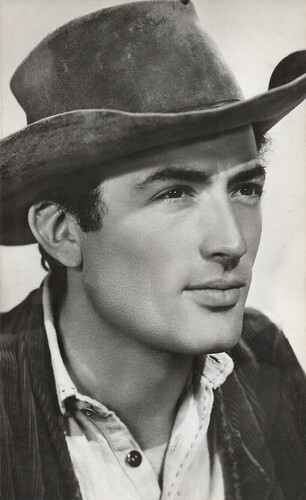
Spanish postcard by Archivo Bermejo, Barcelona, no. 4046. Photo: M.G.M. Gregory Peck in The Yearling (Clarence Brown, 1946).
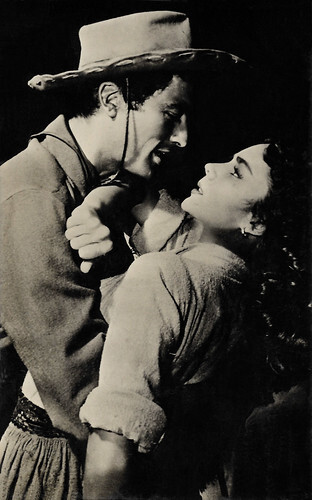
Spanish postcard, 1953. Photo: Procines S.A. Gregory Peck and Jennifer Jones in Duel in the Sun (King Vidor, 1946).
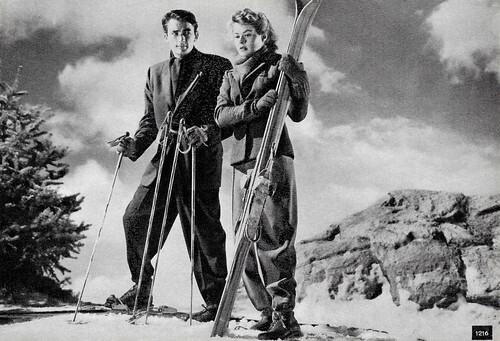
Italian postcard, no. 1216. Photo: United Artists. Gregory Peck and Ingrid Bergman in Spellbound (Alfred Hitchcock, 1945).
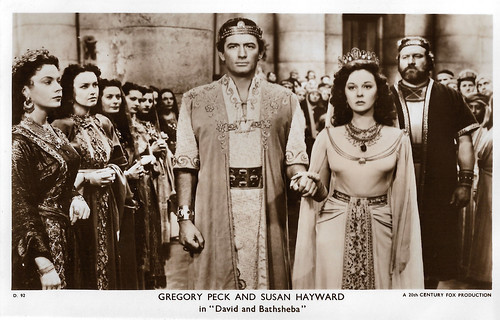
British postcard by The Picturegoer Series, London, no. D 92. Photo: 20th Century Fox. Gregory Peck and Susan Hayward in David and Bathsheba (Henry King, 1951).
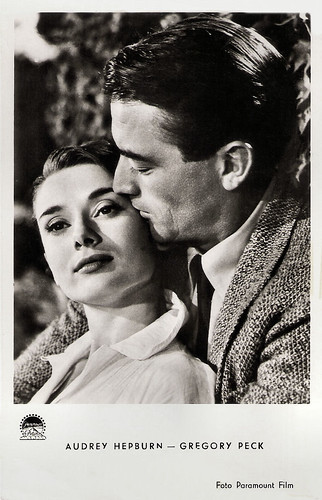
German postcard by Kunst und Bild, Berlin, no. A 1079. Photo: Paramount. Audrey Hepburn and Gregory Peck in Roman Holiday (William Wyler, 1952).
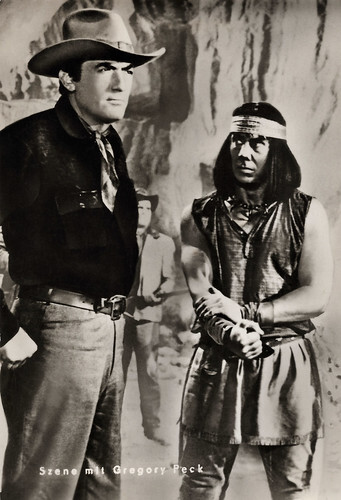
East-German postcard by VEB Progress Film-Vertrieb, Berlin, no. 229/70. Gregory Peck in Mackenna's Gold (J. Lee Thompson, 1969).
Tall, rugged, and heroic, with a basic decency
Eldred Gregory Peck was born in 1916 in La Jolla, California (now in San Diego). His parents were Bernice Mary (Ayres) and Gregory Pearl Peck, a chemist, and druggist in San Diego. His parents divorced when he was five years old. An only child, he was sent to live with his grandmother.
He never felt he had a stable childhood. His fondest memories are of his grandmother taking him to the cinema every week and of his dog, which followed him everywhere. Peck's father encouraged him to take up medicine. He studied pre-med at UC-Berkeley and, while there, got bitten by the acting bug and decided to change the focus of his studies.
He enrolled in the Neighborhood Playhouse in New York and debuted on Broadway after graduation. His debut was in Emlyn Williams ' play 'The Morning Star' (1942). By 1943, he was in Hollywood, where he debuted in the RKO film Days of Glory (Jacques Tourneur, 1944).
Stardom came with his next film, The Keys of the Kingdom (John M. Stahl, 1944), for which he was nominated for an Oscar. Tony Fontana at IMDb : "Peck's screen presence displayed the qualities for which he became well known. He was tall, rugged and heroic, with a basic decency that transcended his roles."
He appeared opposite Ingrid Bergman in Alfred Hitchcock 's Spellbound (1945) as an amnesia victim accused of murder. In The Yearling (Clarence Brown, 1946), he was again nominated for an Oscar and won the Golden Globe. He was especially effective in Westerns and appeared in such varied fare as David O. Selznick's critically blasted Duel in the Sun (King Vidor, 1946), the somewhat better received Yellow Sky (William A. Wellman, 1948), and the acclaimed The Gunfighter (Henry King, 1950).
He was nominated again for the Academy Award for his roles in Gentleman's Agreement (Elia Kazan, 1947), which dealt with anti-Semitism, and Twelve O'Clock High (Henry King, 1949), a story of high-level stress in an Air Force bomber unit in World War II. In 1947, Peck, along with Dorothy McGuire, David O'Selznick, and Mel Ferrer, founded the La Jolla Playhouse, located in his hometown, and produced many of the classics there. Due to film commitments, he could not return to Broadway but whet his appetite for live theatre on occasion at the Playhouse, keeping it firmly established with a strong, reputable name over the years.
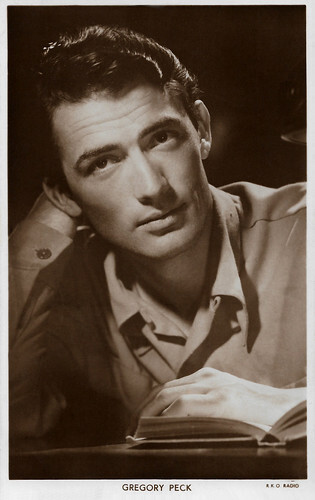
British postcard in the Picturegoer Series, London, no. W. 187. Photo: R.K.O. Radio.
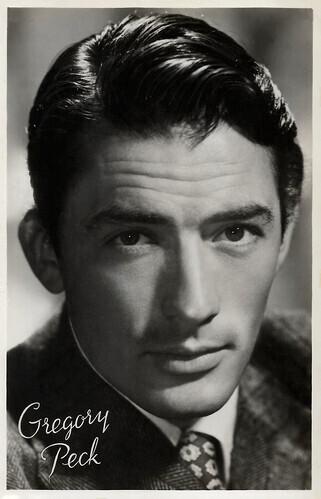
Dutch postcard. Photo: M.G.M. This card is a gift from Loek Coenraad from his mother's legacy. Many thanks, Loek!
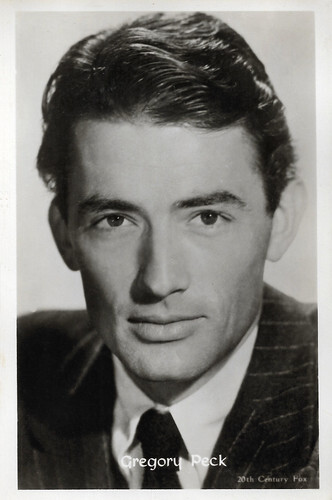
Vintage card. Photo: 20th Century Fox.
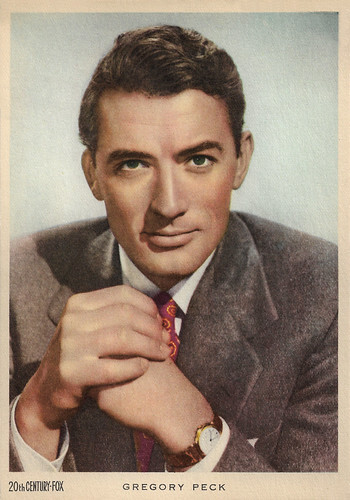
Uruguayan postcard by CF. Photo: 20th Century Fox.
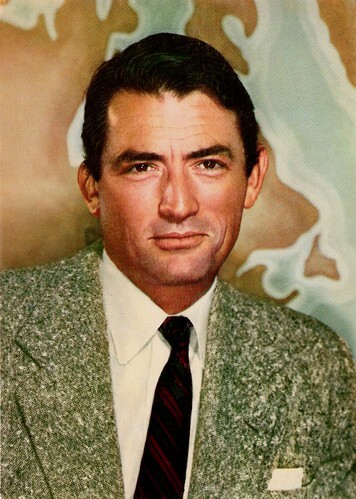
South-African postcard by East-West Publishers, Cape Town, no. 19.
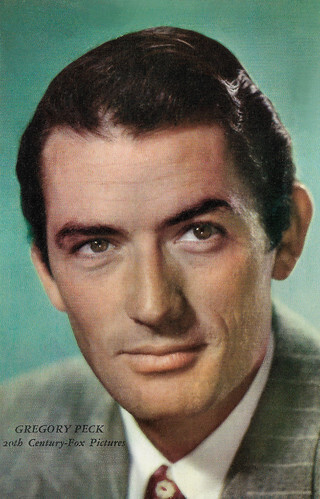
American card by Movie Candid Color Card, Beverly Hills, Calif., no. A32. Photo: Frank Powolny / 20th Century Fox. Caption: Gregory Peck began his professional career in 1939 as a barker. After a few appearances on Broadway, screenwriter Casey Robinson brought him to Hollywood where he rapidly became one of the screen's most sought-after stars.
The greatest film hero of the past 100 years
With a string of hits to his credit, Gregory Peck made the decision to only work in films that interested him. He continued to appear as the heroic, larger-than-life figures in such films as Captain Horatio Hornblower (Raoul Walsh, 1951) with Virginia Mayo , and Moby Dick (John Huston, 1956) with Richard Basehart .
He worked with Audrey Hepburn in her Hollywood debut film, Roman Holiday (William Wyler, 1953). While filming The Bravados (Henry King, 1958), he decided to become a cowboy in real life, so he purchased a vast working ranch near Santa Barbara, California - already stocked with 600 head of prize cattle.
In the early 1960s, he gave a powerful performance as Captain Keith Mallory in The Guns of Navarone (J. Lee Thompson, 1961) opposite David Niven and Anthony Quinn . The film was one of the biggest box-office hits of that year. Peck finally won the Oscar, after four nominations, for his performance as lawyer Atticus Finch in To Kill a Mockingbird (Robert Mulligan, 1962).
He also appeared in two darker films than he usually made, Cape Fear (J. Lee Thompson, 1962) opposite Robert Mitchum , and Captain Newman, M.D. (David Miller, 1963) with Tony Curtis , which dealt with the way people live. The financial failure of Cape Fear (1962) ended his company, Melville Productions.
After making Arabesque (Stanley Donen, 1966) with Sophia Loren , Peck withdrew from acting for three years in order to concentrate on various humanitarian causes, including the American Cancer Society. In the early 1970s, he produced two films, The Trial of the Catonsville Nine (Gordon Davidson, 1972) and The Dove (Charles Jarrott, 1974), when his film career stalled.
He made a comeback playing, somewhat woodenly, Ambassador Robert Thorn in the horror film The Omen (Richard Donner, 1976) with Lee Remick. After that, he returned to the bigger-than-life roles he was best known for, such as MacArthur (Joseph Sargent, 1977) and the infamous Nazi war criminal Dr. Josef Mengele in the huge hit The Boys from Brazil (Franklin J. Schaffner, 1978) with Laurence Olivier and James Mason .
In the 1980s, he moved into television with the miniseries The Blue and the Gray (Andrew V. McLaglen, 1982) in which he played Abraham Lincoln, and The Scarlet and the Black (Jerry London, 1983) with Christopher Plummer and John Gielgud . In 1991, he appeared in the remake of his 1962 film, playing a different role, in Martin Scorsese's Cape Fear (1991). He was also cast as the progressive-thinking owner of a wire and cable business in Other People's Money (Norman Jewison, 1991), starring Danny DeVito.
In 1967, Peck received the Academy's Jean Hersholt Humanitarian Award. He was also been awarded the US Presidential Medal of Freedom. Always politically progressive, he was active in such causes as anti-war protests, workers' rights, and civil rights. In 2003, Peck's portrayal of Atticus Finch was named the greatest film hero of the past 100 years by the American Film Institute, only two weeks before his death. Atticus beat out Indiana Jones, who was placed second, and James Bond who came third.
Gregory Peck died in 2003 in Los Angeles, California. He was 87. Peck was married twice. From 1942 till 1955, he was married to Greta Kukkonen. They had three children: Jonathan Peck (1944-1975), Stephen Peck (1946), and Carey Paul Peck (1949). His second wife was Veronique Passani, whom he met at the set of Roman Holliday. They married in 1955 and had two children: Tony Peck (1956) and Cecilia Peck (1958). The couple remained together till his death.
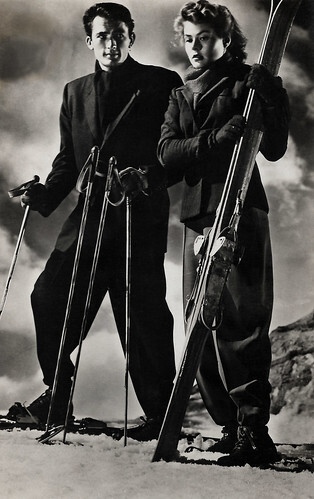
Spanish postcard by JDP, Valencia, no. 1092. Gregory Peck and Ingrid Bergman in Spellbound (Alfred Hitchcock, 1945).
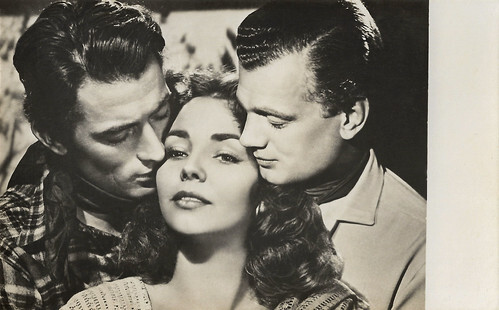
Spanish postcard, no. 5292, 1953. Photo: Procines S.A. Gregory Peck, Jennifer Jones, and Joseph Cotten in Duel in the Sun (King Vidor, 1946).
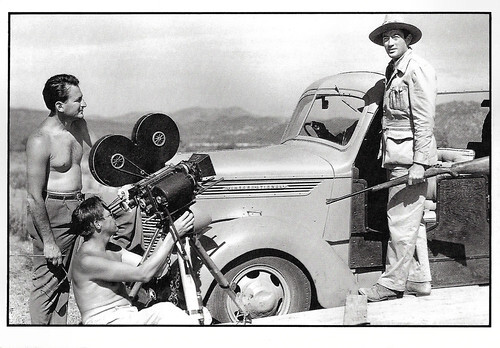
French postcard in the Entr'acte series by Éditions Asphodèle. Mâcon, no. 001/03. Gregory Peck and Karl Struss on the set of The Macomber Affair/Without Honor (Zoltan Korda, 1947). Caption: Low angle on Gregory Peck, on camera Karl Struss (middle).
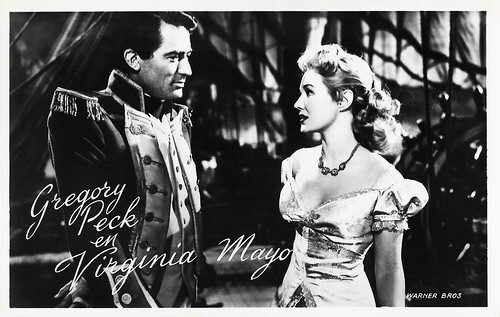
Dutch postcard by Takken, Utrecht, no. 610. Photo: Warner Bros. Gregory Peck and Virginia Mayo in Captain Horatio Hornblower (Raoul Walsh, 1951).
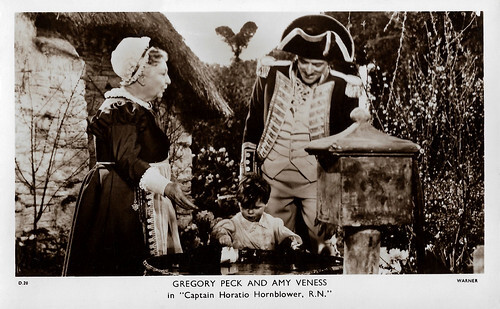
British postcard in the Picturegoer Series, no. D. 20. Photo: Warner Bros. Gregory Peck and Amy Veness in Captain Horatio Hornblower (Raoul Walsh, 1951).
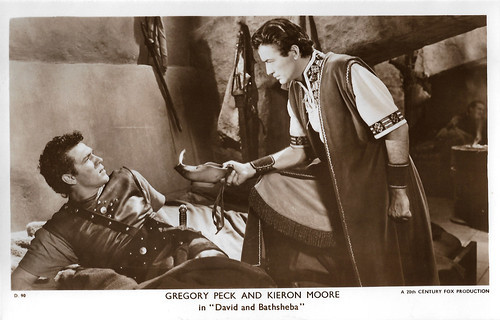
British postcard by The Picturegoer Series, London, no. D 90. Photo: 20th Century Fox. Gregory Peck and Kieron Moore in David and Bathsheba (Henry King, 1951).
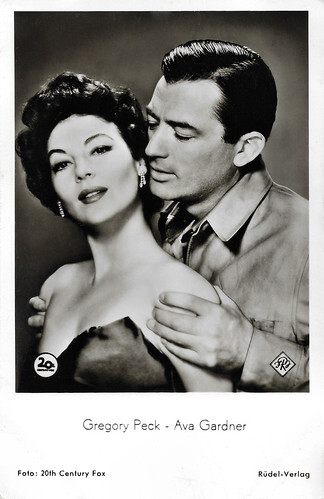
West-German postcard by Rüdel-Verlag, Hamburg-Bergedorf, no. 507. Photo: 20th Century Fox. Ava Gardner and Gregory Peck in The Snows of Kilimanjaro (Henry King, 1952).
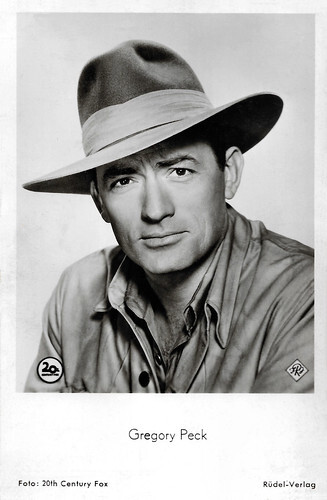
West-German postcard by Rüdel-Verlag, Hamburg-Bergedorf, no. 513. Photo: 20th Century Fox. Gregory Peck in The Snows of Kilimanjaro (Henry King, 1952).
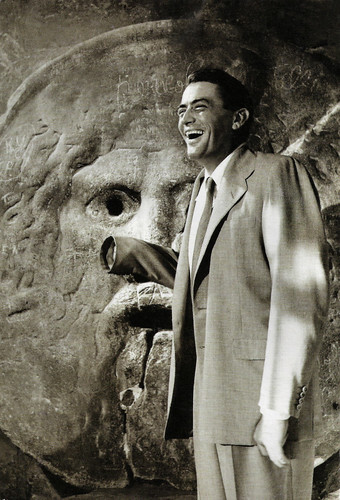
Italian postcard by W. Di Giovanni. Photo: Augusto Di Giovanni. Gregory Peck in Roman Holiday (William Wyler, 1953).
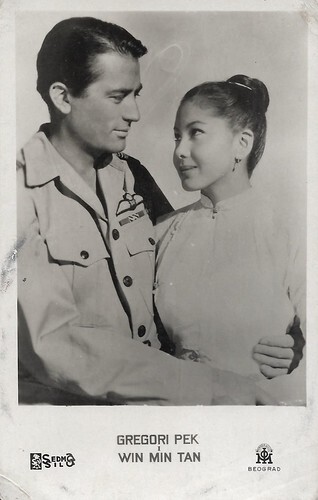
Yugoslavian postcard by Sedma Sila. Photo: Morava Film, Beograd (Belgrade). Gregory Peck and Win Min Tanh in the British film The Purple Plain (Robert Parrish, 1954).
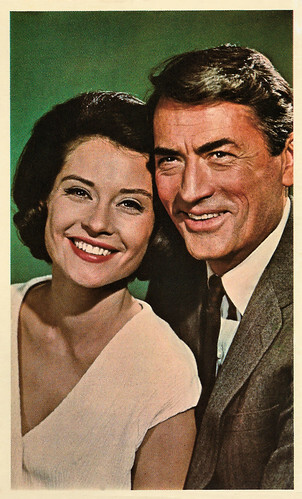
American collectors card by Universal Pictures Company, Inc., 1965. Photo: Universal. Gregory Peck and Diane Baker in Mirage (Edward Dmytryk, 1965).
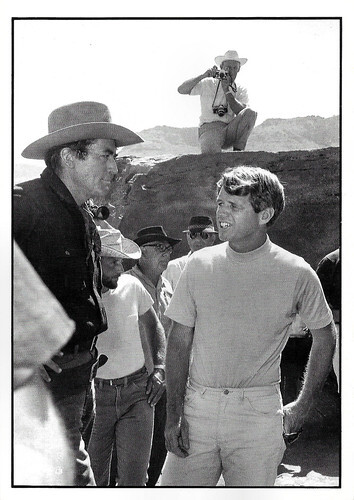
French postcard in the Entr'acte series by Éditions Asphodèle, Mâcon, no. 003/10. Collection: B. Courtel /D.R. Gregory Peck and Bob Kennedy on the set of Mackenna's Gold (J. Lee Thompson, 1969). Caption: Senator Bob Kennedy visits the film crew shooting in Arizona, starring Gregory Peck.
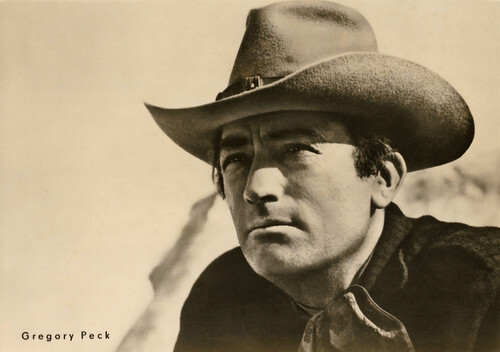
East-German postcard by VEB Progress Film-Vertrieb, Berlin, no. 184/70. Gregory Peck in Mackenna's Gold (J. Lee Thompson, 1969).
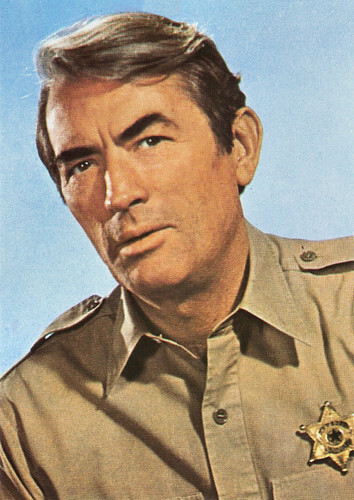
Romanian postcard by Casa Filmului Acin. Photo: 20th Century Fox. Gregory Peck in I Walk the Line (John Frankenheimer, 1970).
Sources: (IMDb), and .

Spanish postcard by Archivo Bermejo, Barcelona, no. 4046. Photo: M.G.M. Gregory Peck in The Yearling (Clarence Brown, 1946).

Spanish postcard, 1953. Photo: Procines S.A. Gregory Peck and Jennifer Jones in Duel in the Sun (King Vidor, 1946).

Italian postcard, no. 1216. Photo: United Artists. Gregory Peck and Ingrid Bergman in Spellbound (Alfred Hitchcock, 1945).

British postcard by The Picturegoer Series, London, no. D 92. Photo: 20th Century Fox. Gregory Peck and Susan Hayward in David and Bathsheba (Henry King, 1951).

German postcard by Kunst und Bild, Berlin, no. A 1079. Photo: Paramount. Audrey Hepburn and Gregory Peck in Roman Holiday (William Wyler, 1952).

East-German postcard by VEB Progress Film-Vertrieb, Berlin, no. 229/70. Gregory Peck in Mackenna's Gold (J. Lee Thompson, 1969).
Tall, rugged, and heroic, with a basic decency
Eldred Gregory Peck was born in 1916 in La Jolla, California (now in San Diego). His parents were Bernice Mary (Ayres) and Gregory Pearl Peck, a chemist, and druggist in San Diego. His parents divorced when he was five years old. An only child, he was sent to live with his grandmother.
He never felt he had a stable childhood. His fondest memories are of his grandmother taking him to the cinema every week and of his dog, which followed him everywhere. Peck's father encouraged him to take up medicine. He studied pre-med at UC-Berkeley and, while there, got bitten by the acting bug and decided to change the focus of his studies.
He enrolled in the Neighborhood Playhouse in New York and debuted on Broadway after graduation. His debut was in Emlyn Williams ' play 'The Morning Star' (1942). By 1943, he was in Hollywood, where he debuted in the RKO film Days of Glory (Jacques Tourneur, 1944).
Stardom came with his next film, The Keys of the Kingdom (John M. Stahl, 1944), for which he was nominated for an Oscar. Tony Fontana at IMDb : "Peck's screen presence displayed the qualities for which he became well known. He was tall, rugged and heroic, with a basic decency that transcended his roles."
He appeared opposite Ingrid Bergman in Alfred Hitchcock 's Spellbound (1945) as an amnesia victim accused of murder. In The Yearling (Clarence Brown, 1946), he was again nominated for an Oscar and won the Golden Globe. He was especially effective in Westerns and appeared in such varied fare as David O. Selznick's critically blasted Duel in the Sun (King Vidor, 1946), the somewhat better received Yellow Sky (William A. Wellman, 1948), and the acclaimed The Gunfighter (Henry King, 1950).
He was nominated again for the Academy Award for his roles in Gentleman's Agreement (Elia Kazan, 1947), which dealt with anti-Semitism, and Twelve O'Clock High (Henry King, 1949), a story of high-level stress in an Air Force bomber unit in World War II. In 1947, Peck, along with Dorothy McGuire, David O'Selznick, and Mel Ferrer, founded the La Jolla Playhouse, located in his hometown, and produced many of the classics there. Due to film commitments, he could not return to Broadway but whet his appetite for live theatre on occasion at the Playhouse, keeping it firmly established with a strong, reputable name over the years.

British postcard in the Picturegoer Series, London, no. W. 187. Photo: R.K.O. Radio.

Dutch postcard. Photo: M.G.M. This card is a gift from Loek Coenraad from his mother's legacy. Many thanks, Loek!

Vintage card. Photo: 20th Century Fox.

Uruguayan postcard by CF. Photo: 20th Century Fox.

South-African postcard by East-West Publishers, Cape Town, no. 19.

American card by Movie Candid Color Card, Beverly Hills, Calif., no. A32. Photo: Frank Powolny / 20th Century Fox. Caption: Gregory Peck began his professional career in 1939 as a barker. After a few appearances on Broadway, screenwriter Casey Robinson brought him to Hollywood where he rapidly became one of the screen's most sought-after stars.
The greatest film hero of the past 100 years
With a string of hits to his credit, Gregory Peck made the decision to only work in films that interested him. He continued to appear as the heroic, larger-than-life figures in such films as Captain Horatio Hornblower (Raoul Walsh, 1951) with Virginia Mayo , and Moby Dick (John Huston, 1956) with Richard Basehart .
He worked with Audrey Hepburn in her Hollywood debut film, Roman Holiday (William Wyler, 1953). While filming The Bravados (Henry King, 1958), he decided to become a cowboy in real life, so he purchased a vast working ranch near Santa Barbara, California - already stocked with 600 head of prize cattle.
In the early 1960s, he gave a powerful performance as Captain Keith Mallory in The Guns of Navarone (J. Lee Thompson, 1961) opposite David Niven and Anthony Quinn . The film was one of the biggest box-office hits of that year. Peck finally won the Oscar, after four nominations, for his performance as lawyer Atticus Finch in To Kill a Mockingbird (Robert Mulligan, 1962).
He also appeared in two darker films than he usually made, Cape Fear (J. Lee Thompson, 1962) opposite Robert Mitchum , and Captain Newman, M.D. (David Miller, 1963) with Tony Curtis , which dealt with the way people live. The financial failure of Cape Fear (1962) ended his company, Melville Productions.
After making Arabesque (Stanley Donen, 1966) with Sophia Loren , Peck withdrew from acting for three years in order to concentrate on various humanitarian causes, including the American Cancer Society. In the early 1970s, he produced two films, The Trial of the Catonsville Nine (Gordon Davidson, 1972) and The Dove (Charles Jarrott, 1974), when his film career stalled.
He made a comeback playing, somewhat woodenly, Ambassador Robert Thorn in the horror film The Omen (Richard Donner, 1976) with Lee Remick. After that, he returned to the bigger-than-life roles he was best known for, such as MacArthur (Joseph Sargent, 1977) and the infamous Nazi war criminal Dr. Josef Mengele in the huge hit The Boys from Brazil (Franklin J. Schaffner, 1978) with Laurence Olivier and James Mason .
In the 1980s, he moved into television with the miniseries The Blue and the Gray (Andrew V. McLaglen, 1982) in which he played Abraham Lincoln, and The Scarlet and the Black (Jerry London, 1983) with Christopher Plummer and John Gielgud . In 1991, he appeared in the remake of his 1962 film, playing a different role, in Martin Scorsese's Cape Fear (1991). He was also cast as the progressive-thinking owner of a wire and cable business in Other People's Money (Norman Jewison, 1991), starring Danny DeVito.
In 1967, Peck received the Academy's Jean Hersholt Humanitarian Award. He was also been awarded the US Presidential Medal of Freedom. Always politically progressive, he was active in such causes as anti-war protests, workers' rights, and civil rights. In 2003, Peck's portrayal of Atticus Finch was named the greatest film hero of the past 100 years by the American Film Institute, only two weeks before his death. Atticus beat out Indiana Jones, who was placed second, and James Bond who came third.
Gregory Peck died in 2003 in Los Angeles, California. He was 87. Peck was married twice. From 1942 till 1955, he was married to Greta Kukkonen. They had three children: Jonathan Peck (1944-1975), Stephen Peck (1946), and Carey Paul Peck (1949). His second wife was Veronique Passani, whom he met at the set of Roman Holliday. They married in 1955 and had two children: Tony Peck (1956) and Cecilia Peck (1958). The couple remained together till his death.

Spanish postcard by JDP, Valencia, no. 1092. Gregory Peck and Ingrid Bergman in Spellbound (Alfred Hitchcock, 1945).

Spanish postcard, no. 5292, 1953. Photo: Procines S.A. Gregory Peck, Jennifer Jones, and Joseph Cotten in Duel in the Sun (King Vidor, 1946).

French postcard in the Entr'acte series by Éditions Asphodèle. Mâcon, no. 001/03. Gregory Peck and Karl Struss on the set of The Macomber Affair/Without Honor (Zoltan Korda, 1947). Caption: Low angle on Gregory Peck, on camera Karl Struss (middle).

Dutch postcard by Takken, Utrecht, no. 610. Photo: Warner Bros. Gregory Peck and Virginia Mayo in Captain Horatio Hornblower (Raoul Walsh, 1951).

British postcard in the Picturegoer Series, no. D. 20. Photo: Warner Bros. Gregory Peck and Amy Veness in Captain Horatio Hornblower (Raoul Walsh, 1951).

British postcard by The Picturegoer Series, London, no. D 90. Photo: 20th Century Fox. Gregory Peck and Kieron Moore in David and Bathsheba (Henry King, 1951).

West-German postcard by Rüdel-Verlag, Hamburg-Bergedorf, no. 507. Photo: 20th Century Fox. Ava Gardner and Gregory Peck in The Snows of Kilimanjaro (Henry King, 1952).

West-German postcard by Rüdel-Verlag, Hamburg-Bergedorf, no. 513. Photo: 20th Century Fox. Gregory Peck in The Snows of Kilimanjaro (Henry King, 1952).

Italian postcard by W. Di Giovanni. Photo: Augusto Di Giovanni. Gregory Peck in Roman Holiday (William Wyler, 1953).

Yugoslavian postcard by Sedma Sila. Photo: Morava Film, Beograd (Belgrade). Gregory Peck and Win Min Tanh in the British film The Purple Plain (Robert Parrish, 1954).

American collectors card by Universal Pictures Company, Inc., 1965. Photo: Universal. Gregory Peck and Diane Baker in Mirage (Edward Dmytryk, 1965).

French postcard in the Entr'acte series by Éditions Asphodèle, Mâcon, no. 003/10. Collection: B. Courtel /D.R. Gregory Peck and Bob Kennedy on the set of Mackenna's Gold (J. Lee Thompson, 1969). Caption: Senator Bob Kennedy visits the film crew shooting in Arizona, starring Gregory Peck.

East-German postcard by VEB Progress Film-Vertrieb, Berlin, no. 184/70. Gregory Peck in Mackenna's Gold (J. Lee Thompson, 1969).

Romanian postcard by Casa Filmului Acin. Photo: 20th Century Fox. Gregory Peck in I Walk the Line (John Frankenheimer, 1970).
Sources: (IMDb), and .
Published on April 07, 2022 22:00
April 6, 2022
Gustav Knuth
Gustav Knuth (1901-1987) was a German actor who played folksy, good-natured characters in numerous films and TV series. After the Second World War, he took Swiss citizenship. He was a successful stage actor and starred in more than 120 films between 1935 and 1982. During the 1960s and 1970s, he was one of the most distinguished German TV actors.
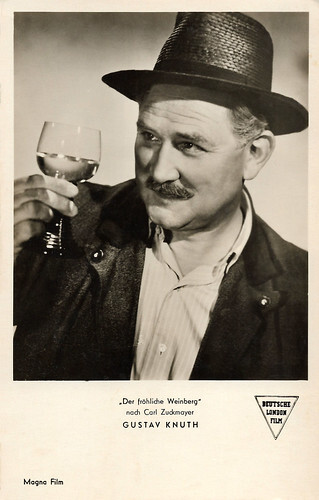
West-German postcard by Kunst und Bild, Berlin, no. A 670. Photo: Deutsche London Film / Magna Film. Gustav Knuth in Der fröhliche Weinberg/The Grapes Are Ripe (Erich Engel, 1952).
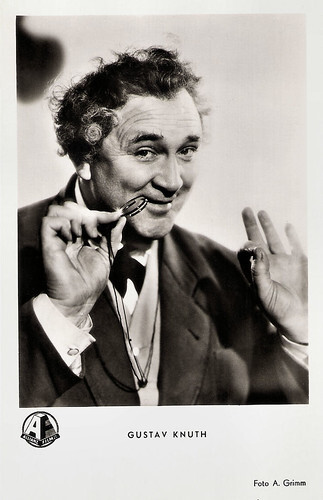
West-German postcard by Kunst und Bild, Berlin, no. A 1051. Photo: Allianz Film / A. Grimm. Gustav Knuth in Die Raub der Sabinerinnen/Theft of the Sabines (Kurt Hoffmann, 1954).
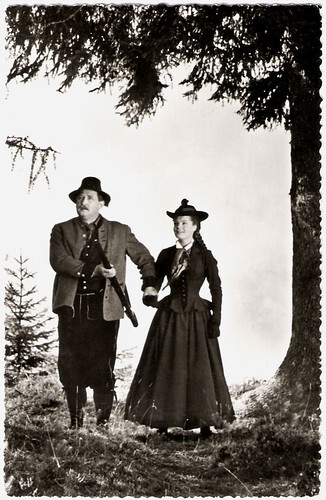
Dutch postcard by Drukkerij Uitgeverij Int. Filmpers (I.F.P.), Amsterdam, no. 1245. Photo: publicity still for Sissi (Ernst Marischka, 1955). Romy Schneider as Sissi and Gustav Knuth as her father Duke Max in Bavaria at their own hunting ground.
The 'new morals' in Nazi Germany
Gustav Adolf Karl Friedrich Knuth was born in Braunschweig, in 1901. His parents the Reichsbahn conductor Christoph Karl Gustav Knuth, and Johanna Friederike Luise Hermine Knuth, née Jürges. Pushed by his father into a locksmith apprenticeship after primary school, he broke off this training and, financed by his sister Else, took acting lessons with the actor Casimir Paris in Braunschweig.
Through his mediation, he received his first engagement at the Stadttheater Hildesheim in 1918. This was followed by the Stadttheater Harburg from 1919 to 1922. Between 1922 and 1925 he played at the Stadttheater Basel, from 1925 to 1933 at the Stadttheater Altona. From 1933 to 1936 he worked at the Deutsches Schauspielhaus in Hamburg. Gustav Knuth was appointed state actor in 1935. A year later, he was contracted by the "Preußische Staatstheater" in Berlin, where he stayed until 1945.
Since 1935 Knuth also appeared in front of the film camera. He made his film debut as a virile village blacksmith in Der Ammenkönig/The King of the Blackbirds (Hans Steinhoff, 1935). The film became a surprise success and was accompanied by a debate about the 'new morals' in Nazi Germany.
In the following years, he played mostly quite inconspicuous, plain, and somewhat awkward lovers. These films included Schatten über St. Pauli/Shadows Over St. Pauli (Fritz Kirchhoff, 1938) with Marieluise Claudius, the Krimi Der Vorhang fällt/The Curtain Falls (Georg Jacoby, 1939) starring Anneliese Uhlig , and the drama Zwischen Hamburg und Haiti/Between Hamburg and Haiti (Erich Waschneck, 1940).
Knuth also appeared as a shy seaman in Helmut Käutner 's Große Freiheit Nr. 7/Great Freedom No. 7 (1943). He considered his best film to be the melancholic Unter den Brücken/Under the bridges, also directed by Helmut Käutner , which was shot in 1944 but not shown until 1946.
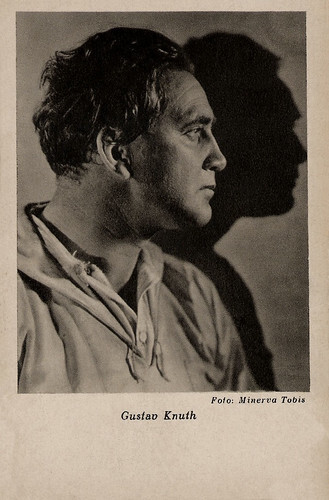
German postcard by Das Programm von Heute, Berlin. Photo: Minerva / Tobis. Gustav Knuth in Heimweh/Homesick (Jürgen von Alten, 1937).
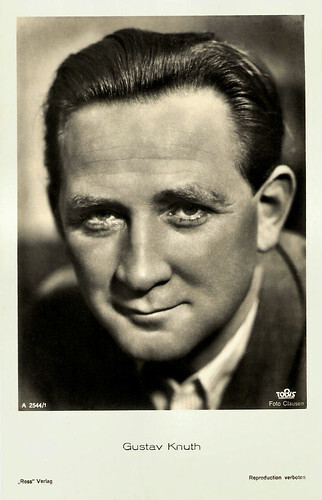
German postcard by Ross Verlag, no. A 2544/1, 1939-1940. Photo: Tobis / Clausen.
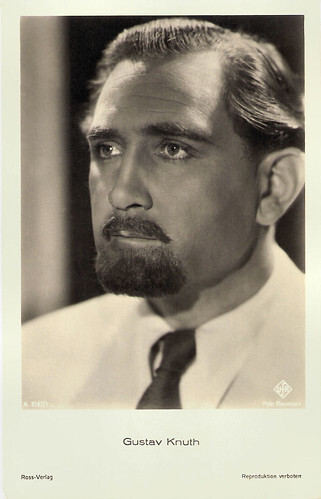
German postcard by Ross Verlag, no. A 3167/1, 1941-1944. Photo: Ufa / Baumann. Gustav Knuth in Zwischen Hamburg und Haiti/Between Hamburg and Haiti (Erich Waschneck, 1940).
The grumpy but cheerful Duke Max in Bayern
Between 1945 and 1949 Knuth worked again at the Deutsches Schauspielhaus Hamburg, among other places. In 1946, the British occupying power appointed him as a representative of the cultural workers in the appointed citizenship of Hamburg. In the first elections to the Bürgerschaft in the same year, he stood as the leading candidate of the 'Freien Kulturpolitischen Bundes' party (Free Cultural-Political Alliance), but was unsuccessful and did not enter parliament.
From 1949 he belonged to the ensemble of the Schauspielhaus Zurich. There he played together with Therese Giehse, among others. Friedrich Dürrenmatt wrote the role of the scientist Beutler for Knuth in his play 'Die Physiker'. This play was staged for television in 1964 by Fritz Umgelter with Knuth and Giehse in the roles written for them.
In the cinema, he made his comedic signature performances in the comedy Der fröhliche Weinberg/The Grapes Are Ripe (Erich Engel, 1952) and as bribery director Striese in Der Raub der Sabinerinnen/Theft of the Sabines (Kurt Hoffmann, 1954). He also starred in the Sissi trilogy as the grumpy but cheerful Duke Max in Bayern (Sissi's father), alongside Romy and Magda Schneider.
Exceptional was his negative role as an arms smuggler in the drama Die Mücke/The Mosquito (Walter Reisch, 1954) starring Hilde Krahl . Furthermore, Knuth played the Puszta stationmaster in Ich denke oft an Piroschka/I Often Think of Piroschka (Kurt Hoffmann, 1955), motor carrier Karl John in Die Ratten/The Rats (Robert Siodmak, 1955) with Maria Schell , and the intrusive debaucher in Das kunstseidene Mädchen/The High Life (Julien Duvivier, 1959), starring Giulietta Masina .
He transcended his roles with a witty lack of emotional commitment. He was also active from time to time as a radio play narrator. In 1953, for example, he played one of the leading roles as Philip Droste in the third Paul Temple multi-part 'Paul Temple und der Fall Vandyke' (Paul Temple and the Vandyke Case) by crime author Francis Durbridge, directed by Eduard Hermann.
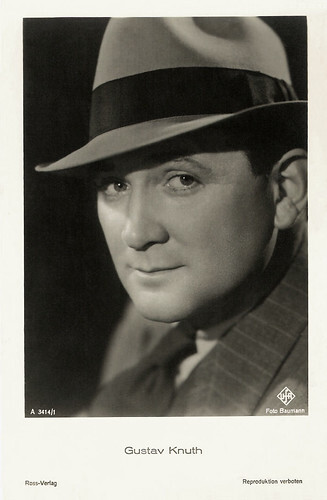
German postcard by Ross Verlag, Berlin, no. A 3414/1, 1941-1944. Photo: Baumann / Ufa.
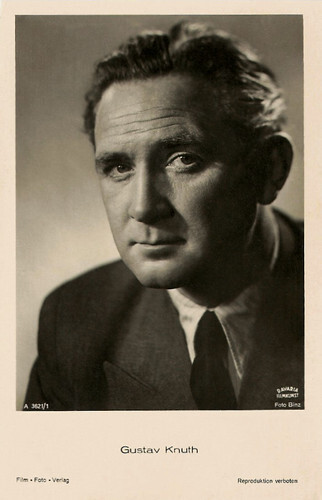
German postcard by Film-Foto-Verlag, Berlin, no. A 3621/1, 1941-1944. Photo: Binz / Bavaria Filmkunst.
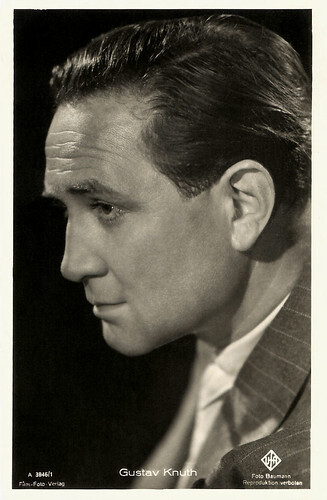
German postcard by Film-Foto-Verlag, Berlin, no. A 3846/1, 1941-1944. Photo: Baumann / Ufa.
The last cab driver with a horse-drawn carriage in Berlin
With the breakthrough of television in the 1960s, Gustav Knuth became better known among the general public. As the veterinarian Dr. Hofer in the series Alle meine Tiere/All my animals (Otto Meyer, 1962-1963), he quickly became a public favourite. During the 1960s and 1970s, he was one of the most outstanding German TV actors, playing popular, good-natured characters in numerous films and series.
He had further success with the family series Großer Mann, was nun?/Big man, what now? (Eugen York, 1967-1968). In the popular circus series Salto Mortale (Michael Braun, 1969-1972), he played the veteran trapeze performer Carlo Doria, the leader of a family of artists. The 26-part family series Drüben bei Lehmanns (Herbert Ballmann, 1970-1973) with Walter Gross and Brigitte Mira, was also very popular.
In 1979 Knuth appeared as Gustav, the last cab driver with a horse-drawn carriage in Berlin in the late 1920s in the TV Mini-series Der eiserne Gustav/Iron Gustav (Wolfgang Staudte, 1979). He played his last role in the cinema in Der Bockerer (Franz Antel, 1981).
Gustav Knuth was married to Gustl Busch. Their son Klaus (1935-2012) also became an actor. The marriage was dissolved in the 1930s. Then Gustav married his colleague Elisabeth Lennartz. The actress Nicole Knuth is his granddaughter. In 1974, Knuth published his memoirs 'Mit einem Lächeln im Knopfloch'. In 1977, he died from the effects of a heart attack in Küsnacht, near Zurich, Switzerland. Gustav Knuth was 85. His last resting place is in the cemetery of Hinterriet in Küsnacht.
He was awarded the Ernst Lubitsch Prize for his artistic performance in Der Lügner (1962). In 1967, 1968, and 1980, he received a Golden Bambi in each case, in 1970 a Silver Bambi. In 1976, he received the Goldene Kamera for his hosting of the celebrity talk show Künstlerstammtisch. For his long-standing and outstanding work in German film, he was awarded the "Goldene Filmband" in 1974.
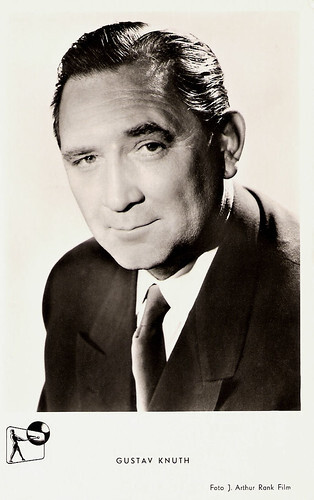
German postcard by Kunst und Bild, Berlin, no. A 977. Photo: J. Arthur Rank Film. Gustav Knuth in Die Nacht ohne Moral/The night without morals (Ferdinand Dörfler, 1953).
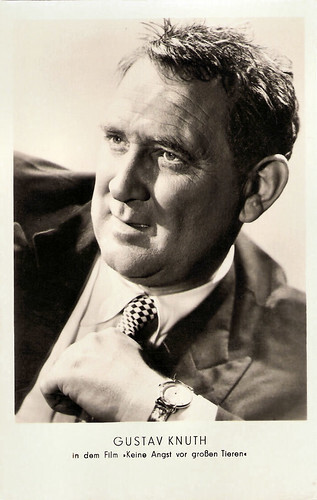
East-German postcard by VEB Volkskunstverlag Reichenbach i.V., no. G 7C6. Photo: Real v. Mindszenty, 1956. Gustav Knuth in Keine Angst für grossen Tieren/Not Afraid of Big Animals (Ulrich Erfurth, 1953).
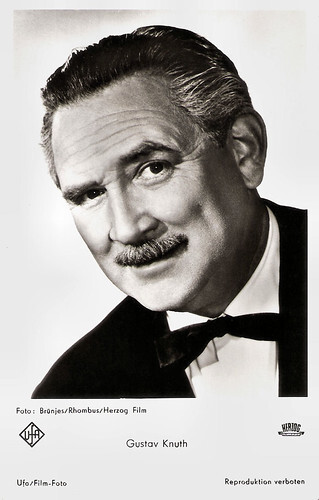
West-German postcard by Ufa/Film-Foto, Berlin-Tempelhof, no. FK 3822. Photo: Brünjes / Rhombus / Herzog Film. Gustav Knuth in Das Schloss in Tirol/Castle in Tyrol (Géza von Radványi, 1957).
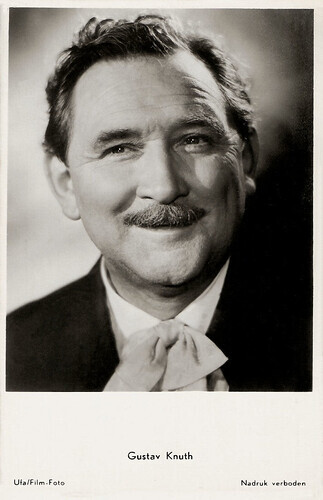
Dutch postcard by Gebr. Spanjersberg N.V., Rotterdam, no. 1049. Photo: Ufa/Film-Foto.
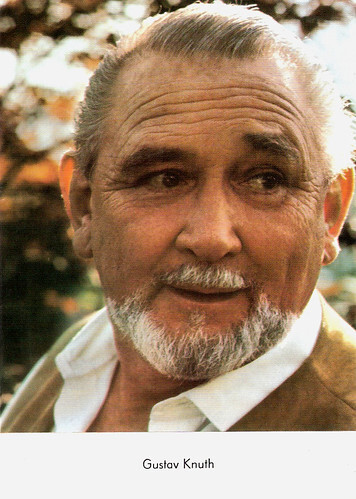
German postcard by Rüdel-Verlag, Hamburg.
Sources: Filmportal.de, Wikipedia (Dutch, German and English), and .

West-German postcard by Kunst und Bild, Berlin, no. A 670. Photo: Deutsche London Film / Magna Film. Gustav Knuth in Der fröhliche Weinberg/The Grapes Are Ripe (Erich Engel, 1952).

West-German postcard by Kunst und Bild, Berlin, no. A 1051. Photo: Allianz Film / A. Grimm. Gustav Knuth in Die Raub der Sabinerinnen/Theft of the Sabines (Kurt Hoffmann, 1954).

Dutch postcard by Drukkerij Uitgeverij Int. Filmpers (I.F.P.), Amsterdam, no. 1245. Photo: publicity still for Sissi (Ernst Marischka, 1955). Romy Schneider as Sissi and Gustav Knuth as her father Duke Max in Bavaria at their own hunting ground.
The 'new morals' in Nazi Germany
Gustav Adolf Karl Friedrich Knuth was born in Braunschweig, in 1901. His parents the Reichsbahn conductor Christoph Karl Gustav Knuth, and Johanna Friederike Luise Hermine Knuth, née Jürges. Pushed by his father into a locksmith apprenticeship after primary school, he broke off this training and, financed by his sister Else, took acting lessons with the actor Casimir Paris in Braunschweig.
Through his mediation, he received his first engagement at the Stadttheater Hildesheim in 1918. This was followed by the Stadttheater Harburg from 1919 to 1922. Between 1922 and 1925 he played at the Stadttheater Basel, from 1925 to 1933 at the Stadttheater Altona. From 1933 to 1936 he worked at the Deutsches Schauspielhaus in Hamburg. Gustav Knuth was appointed state actor in 1935. A year later, he was contracted by the "Preußische Staatstheater" in Berlin, where he stayed until 1945.
Since 1935 Knuth also appeared in front of the film camera. He made his film debut as a virile village blacksmith in Der Ammenkönig/The King of the Blackbirds (Hans Steinhoff, 1935). The film became a surprise success and was accompanied by a debate about the 'new morals' in Nazi Germany.
In the following years, he played mostly quite inconspicuous, plain, and somewhat awkward lovers. These films included Schatten über St. Pauli/Shadows Over St. Pauli (Fritz Kirchhoff, 1938) with Marieluise Claudius, the Krimi Der Vorhang fällt/The Curtain Falls (Georg Jacoby, 1939) starring Anneliese Uhlig , and the drama Zwischen Hamburg und Haiti/Between Hamburg and Haiti (Erich Waschneck, 1940).
Knuth also appeared as a shy seaman in Helmut Käutner 's Große Freiheit Nr. 7/Great Freedom No. 7 (1943). He considered his best film to be the melancholic Unter den Brücken/Under the bridges, also directed by Helmut Käutner , which was shot in 1944 but not shown until 1946.

German postcard by Das Programm von Heute, Berlin. Photo: Minerva / Tobis. Gustav Knuth in Heimweh/Homesick (Jürgen von Alten, 1937).

German postcard by Ross Verlag, no. A 2544/1, 1939-1940. Photo: Tobis / Clausen.

German postcard by Ross Verlag, no. A 3167/1, 1941-1944. Photo: Ufa / Baumann. Gustav Knuth in Zwischen Hamburg und Haiti/Between Hamburg and Haiti (Erich Waschneck, 1940).
The grumpy but cheerful Duke Max in Bayern
Between 1945 and 1949 Knuth worked again at the Deutsches Schauspielhaus Hamburg, among other places. In 1946, the British occupying power appointed him as a representative of the cultural workers in the appointed citizenship of Hamburg. In the first elections to the Bürgerschaft in the same year, he stood as the leading candidate of the 'Freien Kulturpolitischen Bundes' party (Free Cultural-Political Alliance), but was unsuccessful and did not enter parliament.
From 1949 he belonged to the ensemble of the Schauspielhaus Zurich. There he played together with Therese Giehse, among others. Friedrich Dürrenmatt wrote the role of the scientist Beutler for Knuth in his play 'Die Physiker'. This play was staged for television in 1964 by Fritz Umgelter with Knuth and Giehse in the roles written for them.
In the cinema, he made his comedic signature performances in the comedy Der fröhliche Weinberg/The Grapes Are Ripe (Erich Engel, 1952) and as bribery director Striese in Der Raub der Sabinerinnen/Theft of the Sabines (Kurt Hoffmann, 1954). He also starred in the Sissi trilogy as the grumpy but cheerful Duke Max in Bayern (Sissi's father), alongside Romy and Magda Schneider.
Exceptional was his negative role as an arms smuggler in the drama Die Mücke/The Mosquito (Walter Reisch, 1954) starring Hilde Krahl . Furthermore, Knuth played the Puszta stationmaster in Ich denke oft an Piroschka/I Often Think of Piroschka (Kurt Hoffmann, 1955), motor carrier Karl John in Die Ratten/The Rats (Robert Siodmak, 1955) with Maria Schell , and the intrusive debaucher in Das kunstseidene Mädchen/The High Life (Julien Duvivier, 1959), starring Giulietta Masina .
He transcended his roles with a witty lack of emotional commitment. He was also active from time to time as a radio play narrator. In 1953, for example, he played one of the leading roles as Philip Droste in the third Paul Temple multi-part 'Paul Temple und der Fall Vandyke' (Paul Temple and the Vandyke Case) by crime author Francis Durbridge, directed by Eduard Hermann.

German postcard by Ross Verlag, Berlin, no. A 3414/1, 1941-1944. Photo: Baumann / Ufa.

German postcard by Film-Foto-Verlag, Berlin, no. A 3621/1, 1941-1944. Photo: Binz / Bavaria Filmkunst.

German postcard by Film-Foto-Verlag, Berlin, no. A 3846/1, 1941-1944. Photo: Baumann / Ufa.
The last cab driver with a horse-drawn carriage in Berlin
With the breakthrough of television in the 1960s, Gustav Knuth became better known among the general public. As the veterinarian Dr. Hofer in the series Alle meine Tiere/All my animals (Otto Meyer, 1962-1963), he quickly became a public favourite. During the 1960s and 1970s, he was one of the most outstanding German TV actors, playing popular, good-natured characters in numerous films and series.
He had further success with the family series Großer Mann, was nun?/Big man, what now? (Eugen York, 1967-1968). In the popular circus series Salto Mortale (Michael Braun, 1969-1972), he played the veteran trapeze performer Carlo Doria, the leader of a family of artists. The 26-part family series Drüben bei Lehmanns (Herbert Ballmann, 1970-1973) with Walter Gross and Brigitte Mira, was also very popular.
In 1979 Knuth appeared as Gustav, the last cab driver with a horse-drawn carriage in Berlin in the late 1920s in the TV Mini-series Der eiserne Gustav/Iron Gustav (Wolfgang Staudte, 1979). He played his last role in the cinema in Der Bockerer (Franz Antel, 1981).
Gustav Knuth was married to Gustl Busch. Their son Klaus (1935-2012) also became an actor. The marriage was dissolved in the 1930s. Then Gustav married his colleague Elisabeth Lennartz. The actress Nicole Knuth is his granddaughter. In 1974, Knuth published his memoirs 'Mit einem Lächeln im Knopfloch'. In 1977, he died from the effects of a heart attack in Küsnacht, near Zurich, Switzerland. Gustav Knuth was 85. His last resting place is in the cemetery of Hinterriet in Küsnacht.
He was awarded the Ernst Lubitsch Prize for his artistic performance in Der Lügner (1962). In 1967, 1968, and 1980, he received a Golden Bambi in each case, in 1970 a Silver Bambi. In 1976, he received the Goldene Kamera for his hosting of the celebrity talk show Künstlerstammtisch. For his long-standing and outstanding work in German film, he was awarded the "Goldene Filmband" in 1974.

German postcard by Kunst und Bild, Berlin, no. A 977. Photo: J. Arthur Rank Film. Gustav Knuth in Die Nacht ohne Moral/The night without morals (Ferdinand Dörfler, 1953).

East-German postcard by VEB Volkskunstverlag Reichenbach i.V., no. G 7C6. Photo: Real v. Mindszenty, 1956. Gustav Knuth in Keine Angst für grossen Tieren/Not Afraid of Big Animals (Ulrich Erfurth, 1953).

West-German postcard by Ufa/Film-Foto, Berlin-Tempelhof, no. FK 3822. Photo: Brünjes / Rhombus / Herzog Film. Gustav Knuth in Das Schloss in Tirol/Castle in Tyrol (Géza von Radványi, 1957).

Dutch postcard by Gebr. Spanjersberg N.V., Rotterdam, no. 1049. Photo: Ufa/Film-Foto.

German postcard by Rüdel-Verlag, Hamburg.
Sources: Filmportal.de, Wikipedia (Dutch, German and English), and .
Published on April 06, 2022 22:00
April 5, 2022
Weisse Wölfe (1969)
Weisse Wölfe/White Wolves (Bosko Boskovic, Konrad Petzold, 1969) is an East German-Yugoslav 'Ostern' (Red Western or Eastern) about the time after the last Indian wars. Weiße Wölfe is a sequel of Spur des Falken/Trail of the Falcon (1968). The DEFA production stars Gojko Mitic and when released in 1969, sold 4,601,516 tickets.
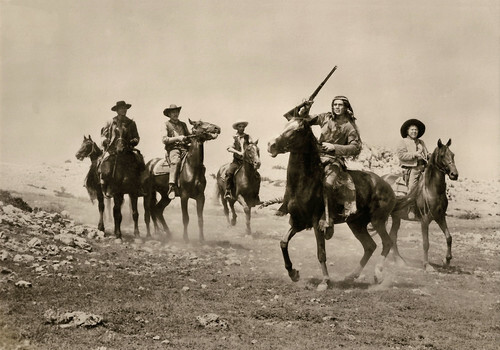
East-German postcard by VEB Progress Film-Verleih, Berlin, no. 89/69. Photo: DEFA / Rambo. Gojko Mitic in Weisse Wölfe/White Wolves (Konrad Petzold, Bosko Boskovic, 1969).
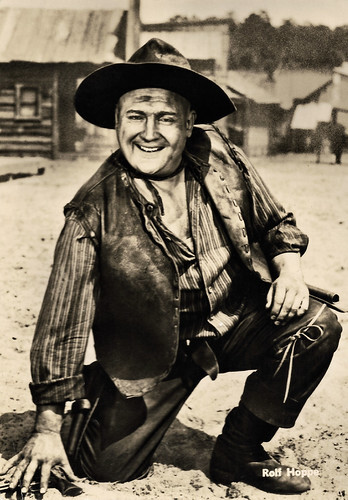
East-German postcard by VEB Progress Film-Vertrieb, Berlin, no. 29/70. Photo: DEFA. Rolf Hoppe in Weisse Wölfe/White Wolves (Konrad Petzold, Bosko Boskovic, 1969).
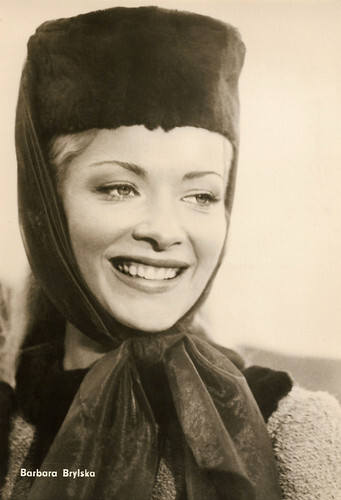
East-German card by VEB Progress Film-Vertrieb, Berlin, no. 53/69, 1969. Retail price: 0,20 MDN. Photo: DEFA / Rambo. Barbara Brylska in Weisse Wölfe/White Wolves (Bosko Boskovic, Konrad Petzold, 1969).
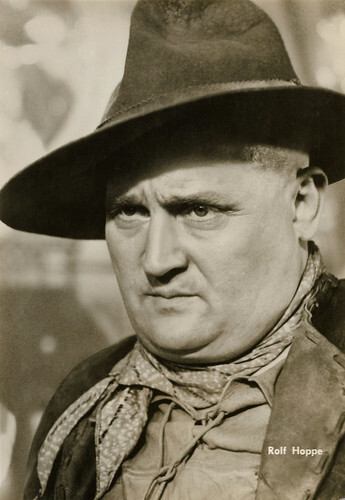
East-German postcard by VEB Progress Film-Vertrieb, Berlin, no. 56/69. Photo: DEFA / Rambo. Rolf Hoppe in Weisse Wölfe/White Wolves (Konrad Petzold, Bosko Boskovic, 1969).
The Shooting of Chief Farseeing Hawk
A group of four Dakota Indians led by Chief Farseeing Hawk ( Gojko Mitic ), travels through the Black Hills in winter. They want to join the Cheyenne tribal group under Chief Little Wolf who has fled their Indian reservation.
At the same time, the transport of trader Sam Blake (Helmut Schreiber) arrives at Fort Robinson. Blake has the gold trade in the Black Hills in his hands, which prevents Harrington (Horst Schulze), a mining boss travelling with them, from expanding his business. Blake also transports the money for the mining company GMI.
In order to get Blake into payment difficulties, Bashan's gang robs the cash transports several times. Bashan (Rolf Hoppe) is the head of the gold mine's guard and acts on Harrington's behalf. On his way back from a robbery, he shoots Blue Hair (Lali Meschi), the chief's wife. Falcon unsuccessfully tries to kill Bashan at the mine.
Due to these events, Harrington enforces the appointment of his employee Sleek (Karl Zugowski) as the deputy sheriff. The sheriff is the former prospector Pat Patterson (Holger Mahlich). Together with Peter Hille (Fred Delmare), he wants to keep law and order in Tanglewood. When Patterson himself runs a money transport, Bashan takes control of Tanglewood with Sleek's help.
Now Harrington can easily put pressure on Blake and demand payment of the looted funds. Meanwhile, Hille finds out that Harrington himself is behind the robberies. When Bashan also wants to rob Patterson of the money, Falcon comes to his aid and the robbery fails. Together they ride to Tanglewood and barricade themselves in the sheriff's office.
Patterson, however, is no longer able to take action against Harrington because Blake has defected to Harrington and the justice of the peace is being held by Harrington's men. Farseeing Hawk is able to leave the office and kill his wife's murderer but is shot himself in the process.
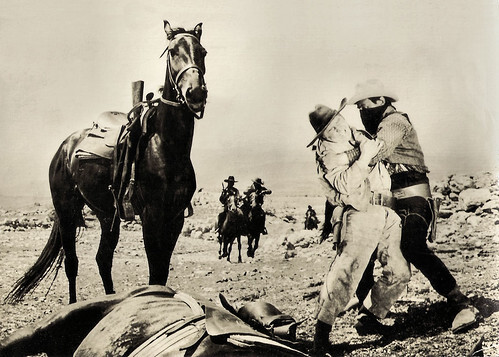
East-German card by VEB Progress Film-Vertrieb, Berlin, no. 89/69, 1969. Retail price: 0,20 MDN. Photo: DEFA / Rambo. Scene from Weisse Wölfe/White Wolves (Bosko Boskovic, Konrad Petzold, 1969).
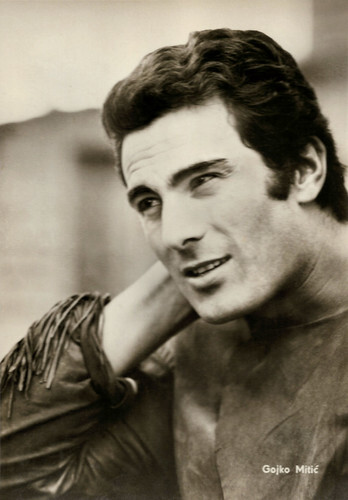
East-German postcard by VEB Progress Film-Vertrieb, Berlin, no. 118/69, 1969. Retail price: 0,20 MDN. Photo: Bläsig. Gojko Mitic in Weisse Wölfe/White Wolves (Bosko Boskovic, Konrad Petzold, 1969).
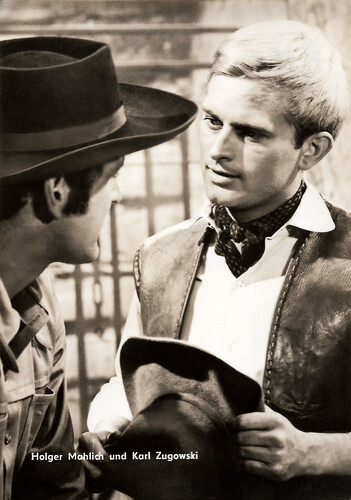
East-German card by VEB Progress Film-Vertrieb, Berlin, no. 130/69, 1969. Retail price: 0,20 MDN. Photo: DEFA. Holger Mahlich and Karl Zugowksi in Weisse Wölfe/White Wolves (Bosko Boskovic, Konrad Petzold, 1969).
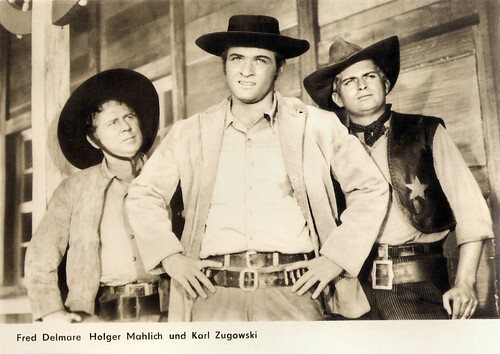
East-German postcard by VEB Progress Film-Vertrieb, Berlin, no. 132/69, 1969. Retail price: 0,20 MDN. Photo: DEFA / Rambo. Fred Delmare, Holger Mahlich and Karl Zugowksi in Weisse Wölfe/White Wolves (Bosko Boskovic, Konrad Petzold, 1969).
The breakout of the Cheyenne from their reservation
Weisse Wölfe/White Wolves (1969) is the sequel to Spur des Falken/Trail of the Falcon (Gottfried Kolditz, 1968). The 'Ostern', an Eastern-German sub-genre of Western, depicts the situation in the USA after 1879. Power struggles between newly founded companies are characteristic of this period.
Historically documented is the breakout of the Cheyenne from their reservation. Weisse Wölfe tells its story in a much darker mood than contemporary Karl-May films of the West German cinema, showing at the beginning how the natives are forced to go into reservations and struggle for survival, an attempt which seems doomed.
The dramatic music of the film, often led by powerful brass instruments, does well to enhance its effect. Filming took place in the High Tatras in former Yugoslavia, in the Dinaric Mountains, in a limestone quarry near Halle and near Langerwisch.
The majority of the 'Easterns' by DEFA studio, was filmed in Yugoslavia, where nature is very similar to North America with Mountains, prairies, rivers, waterfalls, and typical towns of the Wild West. The buildings of the film town of Tanglewood near Langerwisch had to be guarded because the mahogany wood used could also be used to build dachas.
In addition to the Serbian Gojko Mitić , Polish Barbara Brylska , Czech Milan Jablonský, Serbian Slobodan Dimitrijević and Serbian Slobodan Velimirović, the cast includes such DEFA stars as Horst Schulze, Holger Mahlich, Fred Delmare, Rolf Hoppe and Karl Zugowski from East-Germany.
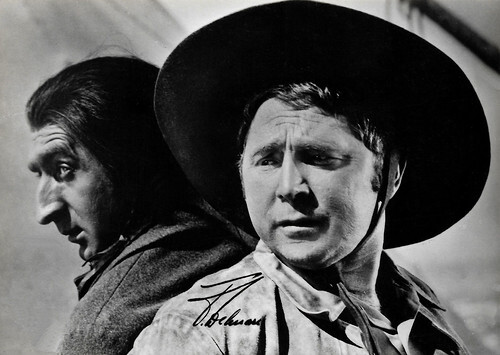
East-German postcard by VEB Progress Film-Vertrieb, Berlin, no. 152/69, 1969. Retail price: 0,20 MDN. Photo: DEFA / Rambo. Fred Delmare in Weisse Wölfe/White Wolves (Bosko Boskovic, Konrad Petzold, 1969).
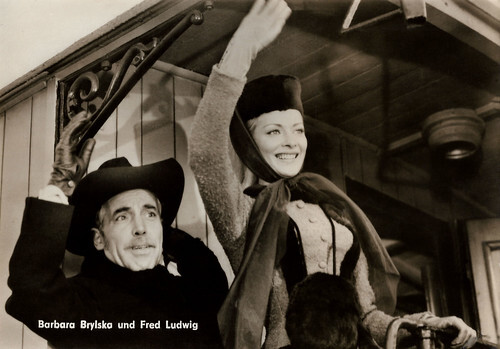
East-German card by VEB Progress Film-Vertrieb, Berlin, no. 188/69, 1969. Retail price: 0,20 MDN. Photo: DEFA / Rambo. Barbara Brylska and Fred Ludwig in Weisse Wölfe/White Wolves (Bosko Boskovic, Konrad Petzold, 1969).
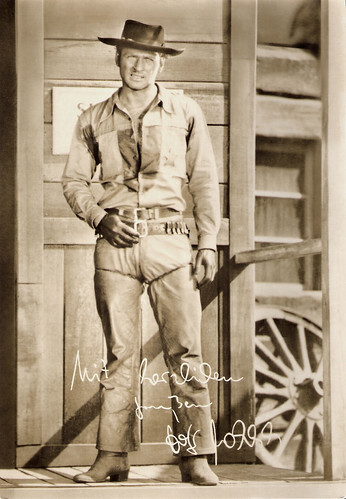
Large East-German card by VEB Progress Film-Vertrieb, Berlin, no. 209/69, 1969. Retail price: 0,40 MDN. Photo: DEFA. Holger Mahlich in Weisse Wölfe/White Wolves (Bosko Boskovic, Konrad Petzold, 1969).
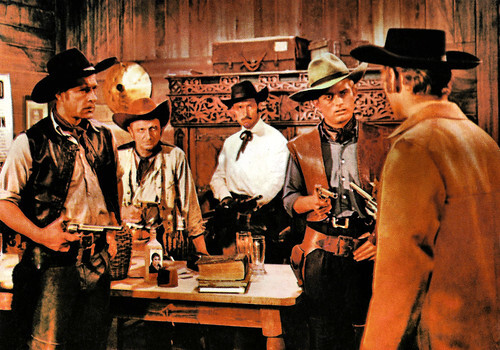
East-German postcard by VEB Progress Film-Verleih, Berlin, no. 8/76. Photo: DEFA / Rambo(w). Milan Jablonsky, Karl Zugowski and Holger Mahlich in Weisse Wölfe/White Wolves (Konrad Petzold, Bosko Boskovic, 1969). Caption: Blauhaar, Hawk's wife, has been shot by the Mining Corporation's bandit chief. Together with the incorruptible Sheriff Patterson, the chief comes to Tanglewood to atone for the crime. In the meantime, the white man's economic power struggle in the town has clearly gone in favour of the mining boss Harrington. There is no way back for Hawk.
Sources: Wikipedia (English and German), and IMDb.

East-German postcard by VEB Progress Film-Verleih, Berlin, no. 89/69. Photo: DEFA / Rambo. Gojko Mitic in Weisse Wölfe/White Wolves (Konrad Petzold, Bosko Boskovic, 1969).

East-German postcard by VEB Progress Film-Vertrieb, Berlin, no. 29/70. Photo: DEFA. Rolf Hoppe in Weisse Wölfe/White Wolves (Konrad Petzold, Bosko Boskovic, 1969).

East-German card by VEB Progress Film-Vertrieb, Berlin, no. 53/69, 1969. Retail price: 0,20 MDN. Photo: DEFA / Rambo. Barbara Brylska in Weisse Wölfe/White Wolves (Bosko Boskovic, Konrad Petzold, 1969).

East-German postcard by VEB Progress Film-Vertrieb, Berlin, no. 56/69. Photo: DEFA / Rambo. Rolf Hoppe in Weisse Wölfe/White Wolves (Konrad Petzold, Bosko Boskovic, 1969).
The Shooting of Chief Farseeing Hawk
A group of four Dakota Indians led by Chief Farseeing Hawk ( Gojko Mitic ), travels through the Black Hills in winter. They want to join the Cheyenne tribal group under Chief Little Wolf who has fled their Indian reservation.
At the same time, the transport of trader Sam Blake (Helmut Schreiber) arrives at Fort Robinson. Blake has the gold trade in the Black Hills in his hands, which prevents Harrington (Horst Schulze), a mining boss travelling with them, from expanding his business. Blake also transports the money for the mining company GMI.
In order to get Blake into payment difficulties, Bashan's gang robs the cash transports several times. Bashan (Rolf Hoppe) is the head of the gold mine's guard and acts on Harrington's behalf. On his way back from a robbery, he shoots Blue Hair (Lali Meschi), the chief's wife. Falcon unsuccessfully tries to kill Bashan at the mine.
Due to these events, Harrington enforces the appointment of his employee Sleek (Karl Zugowski) as the deputy sheriff. The sheriff is the former prospector Pat Patterson (Holger Mahlich). Together with Peter Hille (Fred Delmare), he wants to keep law and order in Tanglewood. When Patterson himself runs a money transport, Bashan takes control of Tanglewood with Sleek's help.
Now Harrington can easily put pressure on Blake and demand payment of the looted funds. Meanwhile, Hille finds out that Harrington himself is behind the robberies. When Bashan also wants to rob Patterson of the money, Falcon comes to his aid and the robbery fails. Together they ride to Tanglewood and barricade themselves in the sheriff's office.
Patterson, however, is no longer able to take action against Harrington because Blake has defected to Harrington and the justice of the peace is being held by Harrington's men. Farseeing Hawk is able to leave the office and kill his wife's murderer but is shot himself in the process.

East-German card by VEB Progress Film-Vertrieb, Berlin, no. 89/69, 1969. Retail price: 0,20 MDN. Photo: DEFA / Rambo. Scene from Weisse Wölfe/White Wolves (Bosko Boskovic, Konrad Petzold, 1969).

East-German postcard by VEB Progress Film-Vertrieb, Berlin, no. 118/69, 1969. Retail price: 0,20 MDN. Photo: Bläsig. Gojko Mitic in Weisse Wölfe/White Wolves (Bosko Boskovic, Konrad Petzold, 1969).

East-German card by VEB Progress Film-Vertrieb, Berlin, no. 130/69, 1969. Retail price: 0,20 MDN. Photo: DEFA. Holger Mahlich and Karl Zugowksi in Weisse Wölfe/White Wolves (Bosko Boskovic, Konrad Petzold, 1969).

East-German postcard by VEB Progress Film-Vertrieb, Berlin, no. 132/69, 1969. Retail price: 0,20 MDN. Photo: DEFA / Rambo. Fred Delmare, Holger Mahlich and Karl Zugowksi in Weisse Wölfe/White Wolves (Bosko Boskovic, Konrad Petzold, 1969).
The breakout of the Cheyenne from their reservation
Weisse Wölfe/White Wolves (1969) is the sequel to Spur des Falken/Trail of the Falcon (Gottfried Kolditz, 1968). The 'Ostern', an Eastern-German sub-genre of Western, depicts the situation in the USA after 1879. Power struggles between newly founded companies are characteristic of this period.
Historically documented is the breakout of the Cheyenne from their reservation. Weisse Wölfe tells its story in a much darker mood than contemporary Karl-May films of the West German cinema, showing at the beginning how the natives are forced to go into reservations and struggle for survival, an attempt which seems doomed.
The dramatic music of the film, often led by powerful brass instruments, does well to enhance its effect. Filming took place in the High Tatras in former Yugoslavia, in the Dinaric Mountains, in a limestone quarry near Halle and near Langerwisch.
The majority of the 'Easterns' by DEFA studio, was filmed in Yugoslavia, where nature is very similar to North America with Mountains, prairies, rivers, waterfalls, and typical towns of the Wild West. The buildings of the film town of Tanglewood near Langerwisch had to be guarded because the mahogany wood used could also be used to build dachas.
In addition to the Serbian Gojko Mitić , Polish Barbara Brylska , Czech Milan Jablonský, Serbian Slobodan Dimitrijević and Serbian Slobodan Velimirović, the cast includes such DEFA stars as Horst Schulze, Holger Mahlich, Fred Delmare, Rolf Hoppe and Karl Zugowski from East-Germany.

East-German postcard by VEB Progress Film-Vertrieb, Berlin, no. 152/69, 1969. Retail price: 0,20 MDN. Photo: DEFA / Rambo. Fred Delmare in Weisse Wölfe/White Wolves (Bosko Boskovic, Konrad Petzold, 1969).

East-German card by VEB Progress Film-Vertrieb, Berlin, no. 188/69, 1969. Retail price: 0,20 MDN. Photo: DEFA / Rambo. Barbara Brylska and Fred Ludwig in Weisse Wölfe/White Wolves (Bosko Boskovic, Konrad Petzold, 1969).

Large East-German card by VEB Progress Film-Vertrieb, Berlin, no. 209/69, 1969. Retail price: 0,40 MDN. Photo: DEFA. Holger Mahlich in Weisse Wölfe/White Wolves (Bosko Boskovic, Konrad Petzold, 1969).

East-German postcard by VEB Progress Film-Verleih, Berlin, no. 8/76. Photo: DEFA / Rambo(w). Milan Jablonsky, Karl Zugowski and Holger Mahlich in Weisse Wölfe/White Wolves (Konrad Petzold, Bosko Boskovic, 1969). Caption: Blauhaar, Hawk's wife, has been shot by the Mining Corporation's bandit chief. Together with the incorruptible Sheriff Patterson, the chief comes to Tanglewood to atone for the crime. In the meantime, the white man's economic power struggle in the town has clearly gone in favour of the mining boss Harrington. There is no way back for Hawk.
Sources: Wikipedia (English and German), and IMDb.
Published on April 05, 2022 22:00
April 4, 2022
Three early films with Lyda Borelli: Ma l'amor mio non muore (1913), La memoria dell'altro (1914), and La donna nuda (1914)
Lyda Borelli (1887-1959) was the first Italian film diva. La Borelli was already an acclaimed stage actress before she became a star of the Italian silent cinema. The fascinating diva caused a craze among female fans, which was called 'Borellismo. This post by Ivo Blom is dedicated to her first three films, Ma l'amor mio non muore/Love Everlasting (1913), La memoria dell'altro/Memory of the other (1914), and La donna nuda/The Naked Woman (1914), with sets of Spanish minicards. Next week, EFSP presents a post for which Ivo selected three of Borelli's later films.
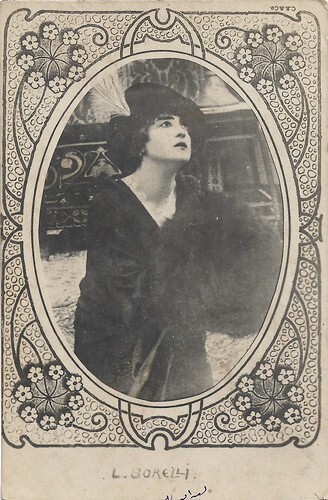
Italian postcard by C.E. & Co. Photo: Cines. Lyda Borelli in La donna nuda (Carmine Gallone, 1914).
Ma l'amor mio non muore (1914)
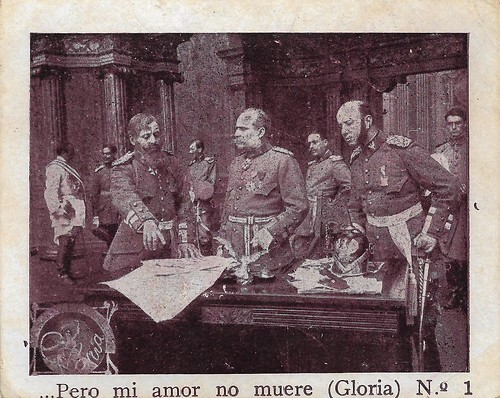
Spanish minicard by Reclam Films, Mallorca, no. 1. Photo: Gloria Film. Vittorio Rossi Pianelli as Colonel Julius Holbein, Antonio Monti as The General, and Emilio Petacci as Colonel Theubner in Ma l'amor mio non muore (Mario Caserini, 1913). The Spanish title was ...Pero mi amor no muere.

Spanish minicard by Reclam Films, Mallorca, no. 2. Photo: Gloria Film. Lyda Borelli , Vittorio Rossi Pianelli, and Emilio Petacci in Ma l'amor mio non muore (Mario Caserini, 1913).
She dies on stage in Maximilian's arms
Ma l'amor mio non muore/Love Everlasting (Mario Caserini, 1913) was Lyda Borelli 's screen debut. She plays the beautiful Elsa Holbein, who lived in the Grand Duchy of Wallenstein. Elsa is the daughter of Colonel Julius Holbein (Vittorio Rossi Pianelli), who kills himself because he is falsely accused of treason. His missing military plans have been stolen by a foreign spy, Moise Stahr (Gian Paolo Rosmino).
Elsa, although innocent, is exiled and finds refuge on the Riviera. Here she begins to perform on the stage as an opera singer under the pseudonym Diana Cadouleur. Thanks to an engagement by the impresario Schaudard ( Camillo De Riso ), she achieves great success, but privately, she remains unhappy.
At the height of her success, Elsa meets Prince Maximilian ( Mario Bonnard ), heir to the Grand Duke, but both don't know each other's true identity. The two fall in love, and Elsa finds happiness, but during a boat trip on the Lago Maggiore, they meet Stahr. Having recognised the woman and been rejected by her, Stahr takes revenge by spreading the news of the Prince's affair, who is called back home.
Elsa, realising Maximilian is the son of the man who expelled her, is devastated. Broken, she returns to Schaudard. Maximilian, contravening the orders of his father, returns to Elsa, but seeing no future for the two of them, Elsa poisons herself and while performing the death scene from 'La Traviata', she collapses and dies on stage in Maximilian's arms.
In addition, Dante Cappelli played the Grand Duke, Maria Caserini the Grandduchess, and Emilio Petacci Colonel Theubner, who is first the close friend of Holbein and Elsa, but then becomes their enemy, acting on behalf of the Grandduke and the General Staff. Angelo Scalenghe was responsible for the cinematography, while the film is remarkable for its deep staging indoor cinematography, especially in the first scene of the film, its outdoor location shooting (around the Italian lakes), the elaborate costumes of Borelli, and its ingenious use of a triple mirror in the dressing room in the second part of the film.
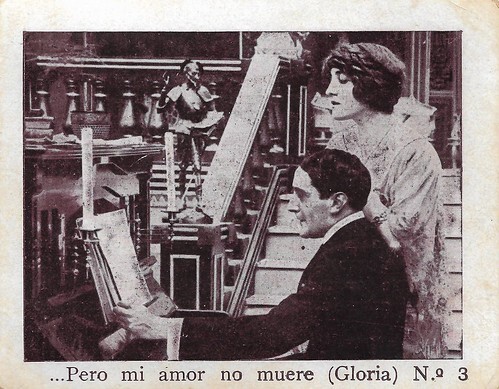
Spanish minicard by Reclam Films, Mallorca, no. 3. Photo: Gloria Film. Lyda Borelli and Mario Bonnard in Ma l'amor mio non muore (Mario Caserini, 1913).
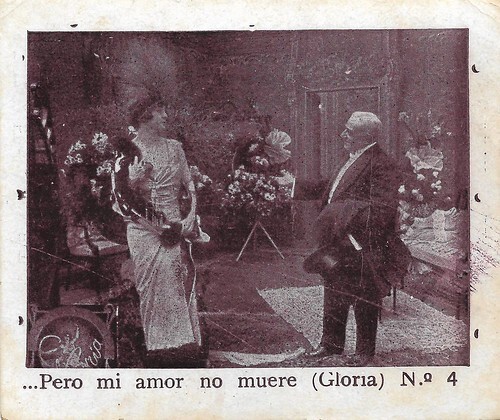
Spanish minicard by Reclam Films, Mallorca, no. 4. Photo: Gloria Film. Lyda Borelli and Camillo de Riso in Ma l'amor mio non muore (Mario Caserini, 1913).
One of the first "noble couples" of Italian cinema
In 1911, one of the most successful Italian silent film directors, Mario Caserini, left Cines for the Turin-based Ambrosio Film. A year later, he broke the contract with the latter as well and participated with the exhibitor Domenico Cazzulino and other partners in the establishment of a new film production company, the Film artistica Gloria.
In the new company Caserini brought with him his wife, the actress Maria Caserini, and a number of actors and actresses he had already directed at Cines and Ambrosio. After making the first two films Il treno degli spettri and Florette e Patapon, Gloria's prospects took off when it managed to recruit one of the most popular theatre actresses of the time, Lyda Borelli , who had never worked in the cinema before.
Caserini then set out to find a suitable subject for Borelli and found it in the writings of two Genoese non-professional authors, Emiliano Bonetti, a doctor, but also a lover of show business and music, and Giovanni Monleone, a teacher and journalist. The two friends had published a few minor works and now had decided to start writing for the cinema, insisting on sentimental and romantic themes. On this occasion, they created a story to which they gave a title taken from the last verse of Puccini's 'Manon Lescaut'.
Ma l'amor mio non muore/Love Everlasting was made in the middle of 1913 in the Turin factory of Gloria in Via Quittengo, where the newcomer Borelli was joined by an already experienced film actor, Mario Bonnard. They formed with one of the first "noble couples" of Italian cinema. Bonnard, however, found himself surpassed in notoriety and public passion, bordering on fanaticism, by the actress, who, according to a repetitive cliché of the "divas", also represents, in this case, a woman destined to die by suicide or to be the cause of death. Some scenes of passionate kissing between the two performers were nevertheless eliminated by the censors.
From the moment it appeared, Ma l'amor mio non muore was a triumphant success, contributing to the creation of the divine myth of Borelli. The periodicals of the time praised it as "the first film which, for the luxury of its staging, the vastness of its scenery and the impeccability of its interpretation, makes one forget the cinema and gives the impression of a work of dramatic art". Praise was lavished. Ma l'amor mio non muore was described as "harmonious, soft: from the small scenes with the faintest effect to the marvelous salons, the luxuriant exteriors, the mysterious landscapes, and the poetic, evocative close-ups", while Borelli was described as "a soft, elegant creature, ardent and painful, cloaked in nobility and voluptuousness, passing like a spring dress through a wood of flowering almond trees".
The writer Matilde Serao was also enthusiastic: "Never as in this film - she wrote - so tender and dramatic, so sumptuous and elegant, has Borelli achieved such a truth of physiognomy, all so differently beautiful". The film was also a commercial success as it was exported all over the world and the authors had news of successful performances for a long time, even from places as far away as Melbourne or La Paz. In later decades, critics and audiences were less enthusiastic, but when in 2013, exactly one century after its release, the film was restored by the Cineteca di Bologna in collaboration with the Museo Nazionale del Cinema di Torino, and shown at the Cinema Ritrovato film festival, the film was praised all over again. This restored edition has been available on DVD since 2013 as part of the Cineteca's series called Cinemalibero.
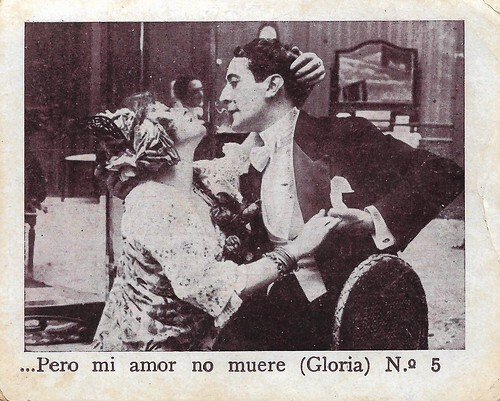
Spanish minicard by Reclam Films, Mallorca, no. 5. Photo: Gloria Film. Lyda Borelli and Mario Bonnard in Ma l'amor mio non muore (Mario Caserini, 1913).
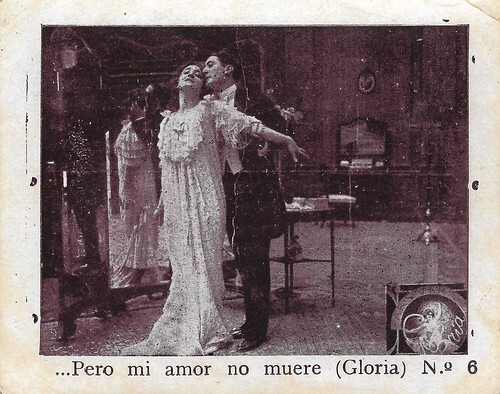
Spanish minicard by Reclam Films, Mallorca, no. 6. Photo: Gloria Film. Lyda Borelli and Mario Bonnard in Ma l'amor mio non muore (Mario Caserini, 1913).
La memoria dell'altro (1914)
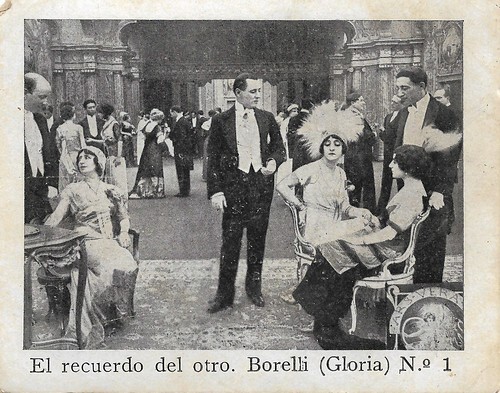
Spanish minicard (collectors card) by Reclam Films, Mallorca, no. 1 of 6 cards. Photo: Gloria Film. Lyda Borelli and Vittorio Rossi Pianelli in La memoria dell'altro (Alberto Degli Abbati, 1914). The Spanish release title was El recuerdo del otro.
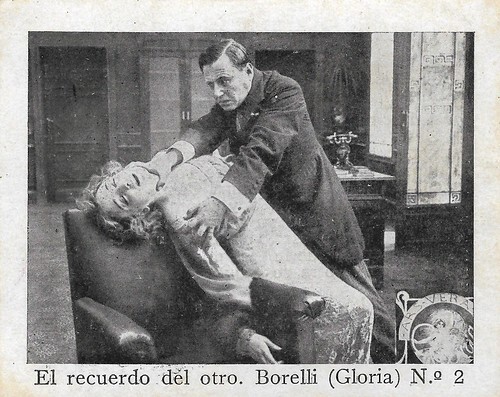
Spanish minicard (collectors card) by Reclam Films, Mallorca, no. 2 of 6 cards. Photo: Gloria Film. Lyda Borelli and Vittorio Rossi Pianelli in La memoria dell'altro (Alberto Degli Abbati, 1914).
Her memory of Mario as her final vision
Just a few months after the release of Ma l’amor mio non muore! (Mario Caserini, 1913) followed Alberto Degli Abbati’s La memoria dell’altro/Memory of the other (1914), in which Lyda Borelli starred again with Mario Bonnard . La memoria dell’altro was made in the wake of the enormous success of its predecessor.
The two Gloria productions, both shot in Turin, became categorised as the first of “the Lyda Borelli series”, although immediately after La memoria dell’altro was finished Borelli left Gloria. She would hence continue her career at the Roman Cines company.
Lyda Borelli plays the young aviatrix Lyda, who spurns the advances of the Prince of Sèvre (Vittorio Rossi Pianelli). She falls in love with the journalist Mario ( Mario Bonnard ), who, although engaged to Cesarina (Letizia Quaranta), goes to Lyda’s home for an assignation. Cesarina sees them and manages to persuade Mario to leave Lyda.
Now alone, Lyda accepts the Prince’s advances even if she cannot forget Mario. Sometime later in Venice, the star-crossed lovers meet by chance in a theatre, re-igniting their memoria and their old love in a succession of romantic scenes.
The Prince goes berserk when he finds out. Yet, when Mario and Lyda have fled to Paris, Mario becomes ill and money runs out. Lyda first sells all of her belongings. Finally, she has to dance for money in a tavern, in order to get money for her beloved. But the medicine, alas, arrives too late. She becomes ill herself, dying in a hospital with her memory of Mario as her final vision.
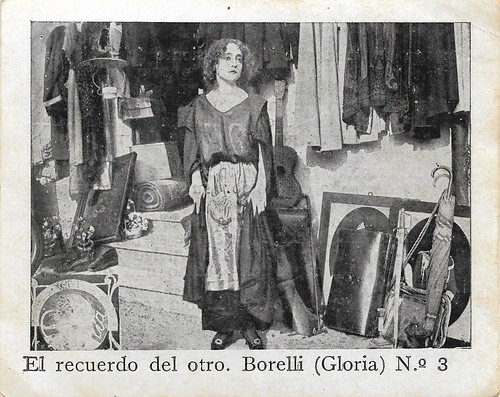
Spanish minicard (collectors card) by Reclam Films, Mallorca, no. 3 of 6 cards. Photo: Gloria Film. Lyda Borelli in La memoria dell'altro (Alberto Degli Abbati, 1914).
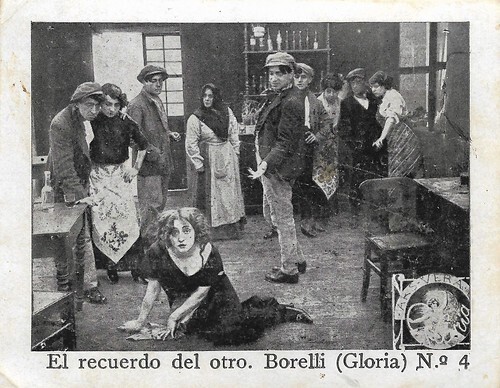
Spanish minicard (collectors card) by Reclam Films, Mallorca, no. 4 of 6 cards. Photo: Gloria Film. Lyda Borelli in La memoria dell'altro (Alberto Degli Abbati, 1914).
A complex, articulate picture of the human heart
La memoria dell'altro/Memory of the other (Alberto Degli Abbati, 1914) was written by Gloria company author Baroness Vittorina De Rege. Marcello Seregni in the festival catalogue of Giornate del Cinema Muto 2018: "The story has the sure ability to create a complex, articulate picture of the human heart.
Lyda’s character glows with sensuality, and the story gives more than a nod to women’s emancipation, with the magnificent opening scene of an airplane in flight, a metaphor for modernity, just as the power and abandon of the apache dance in the second part of the film confirm the independence of the female character."
Mario Bonnard partners Borelli elegantly, providing a perfect counterbalance for the actress’s exuberance, and giving the performance of a “highly effective actor, at the same time sober, measured, and honest”.
Bonnard is there, in the scene, but we could almost say that he isn’t; his most obvious trademark is the extreme flexibility – one critic called it camouflage – with which he enters the shot and performs his role without excess, but with distinction. This second appearance confirmed Bonnard’s skill in evoking the cliché of the tragic male; yet despite its success, he had the wisdom to part company with such type-casting later in his career.
Adding to the film’s success were the Venice locations, among them vaporetto trips and wonderful shots of the Piazza San Marco. The direction was in the capable hands of the versatile Alberto Degli Abbati.
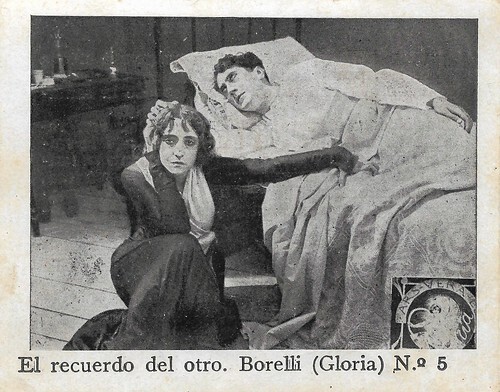
Spanish minicard (collectors card) by Reclam Films, Mallorca, no. 5 of 6 cards. Photo: Gloria Film. Lyda Borelli and Mario Bonnard in La memoria dell'altro (Alberto Degli Abbati, 1914).
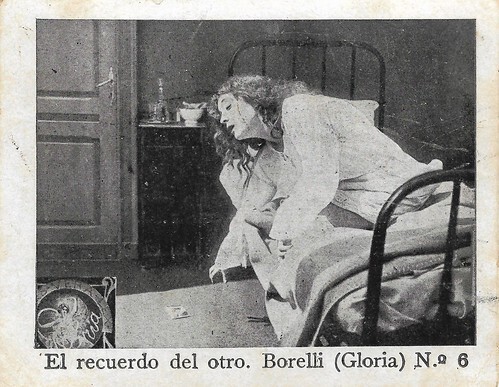
Spanish minicard (collectors card) by Reclam Films, Mallorca, no. 6 of 6 cards. Photo: Gloria Film. Lyda Borelli in La memoria dell'altro (Alberto Degli Abbati, 1914).
La donna nuda (1914)
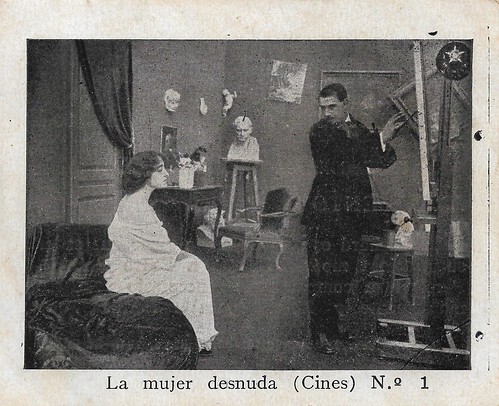
Spanish minicard (collectors card) by Reclam Films, Mallorca, no. 1 of 6 cards. Photo: Cines. Lyda Borelli and Lamberto Picasso in La donna nuda (Carmine Gallone, 1914).
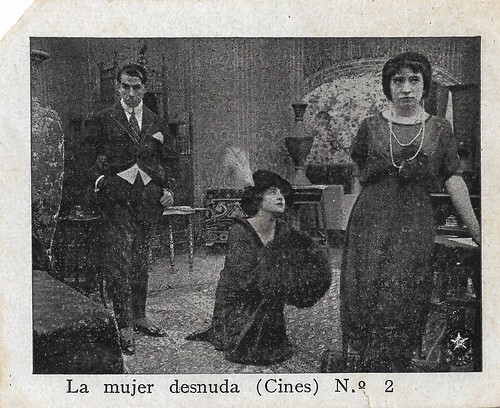
Spanish minicard (collectors card) by Reclam Films, Mallorca, no. 2 of 6 cards. Photo: Cines. Lamberto Picasso, Lyda Borelli , and Wanda Capodaglio in La donna nuda (Carmine Gallone, 1914).
Walking through an autumnal forest with leaves falling down
La donna nuda (Carmine Gallone, 1914) was one of the many film adaptations of Henry Bataille's stage play 'La femme nue'. The painter Pierre Bernier (Lamberto Picasso) becomes rich and famous thanks to the portrait 'The Naked Woman'.
The portrait represents his model, the seductive Lolette ( Lyda Borelli ), whom he has 'stolen' from his old master Rouchard ( Ugo Piperno ). The very evening of his triumph at the Salon des Expositions, he decides to marry her.
But, having become rich and famous, Pierre Bernier soon falls in love with the frivolous Princess of Chaban ( Wanda Capodaglio ), an amateur painter herself, and abandons the woman to whom he owes his success.
Lolette first implores the princess to give him up, but when she sees her embracing Pierre during a party at her own home, she goes hysterical, throws away her ring, and collapses.
She ends up in hospital where Pierre visits her, but she cannot forgive him. Deluded, she returns to Rouchard walking through an autumnal forest, with leaves falling down around her. When Pierre understands the princess is not in love with him, he asks Lolette to forgive him. Poor Rouchard, hopelessly in love with Lolette, will remain alone.
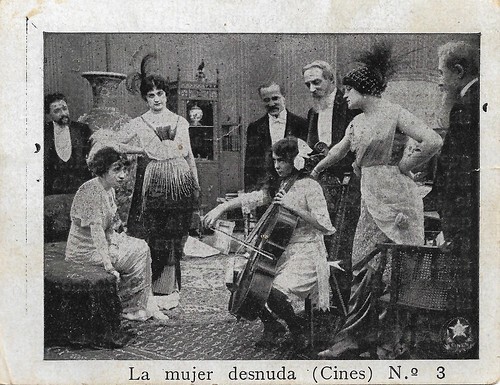
Spanish minicard (collectors card) by Reclam Films, Mallorca, no. 3 of 6 cards. Photo: Cines. Lyda Borelli in La donna nuda (Carmine Gallone, 1914).
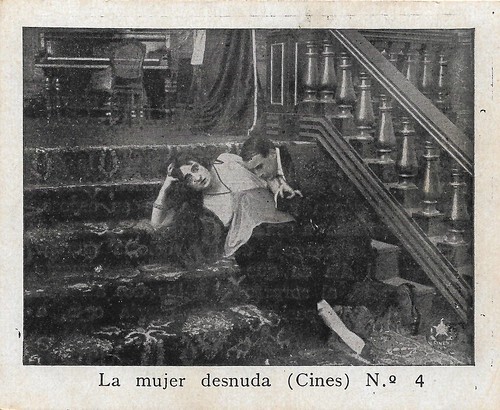
Spanish minicard (collectors card) by Reclam Films, Mallorca, no. 4 of 6 cards. Photo: Cines. Lyda Borelli , and Lamberto Picasso, in La donna nuda (Carmine Gallone, 1914).
One of Borelli's most outstanding performances
La donna nuda (1914)was Lyda Borelli's first production for the Roman company Cines, after her first two films at the Turinese company Gloria. Yet, the exteriors of the film were shot at the Valentino park in Turin.
The film had its Italian premiere in April 1914 and became a worldwide success. Even if some critics thought her earlier film Ma l'amor mio non muore a better film, the film critic Max wrote from Turin a raving review for the Neapolitan journal Film, considering it one of Cines' best films and one of Borelli's most outstanding performances, even if her comic moments were not really appreciated.
Even if a little astray boy risks ruining it, the shot in the autumnal forest is worthy of its sound equivalent at the end of The Third Man (Carol Reed, 1949) with Alida Valli .
Also, the shot through the half opaque glass during the ball, when Lolette witnesses the adultery, is masterfully done. Otherwise, the cinematography is static and it is rather the mise-en-scene that draws the attention, such as the deep staging interior scenes, or a back-lit shot on a bridge at the Valentino.
Lamberto Picasso is not very convincing as Pierre Bernier and while helping Lolette after her big scene of hysteria, he remarkable often holds his hands at her bosom. More touching is Ugo Piperno as the old painter who in the end loses Lolette, while being the more honest, loyal, and sincerely loving man.
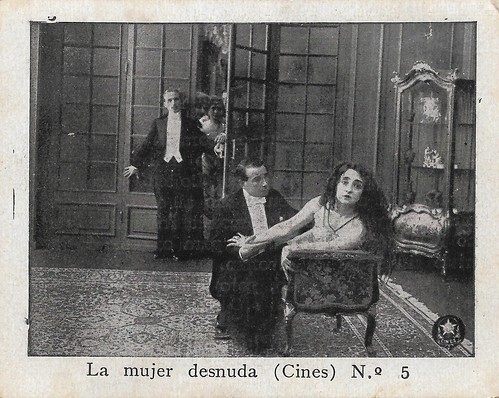
Spanish minicard (collectors card) by Reclam Films, Mallorca, no. 5 of 6 cards. Photo: Cines. Lyda Borelli , and Lamberto Picasso, in La donna nuda (Carmine Gallone, 1914).
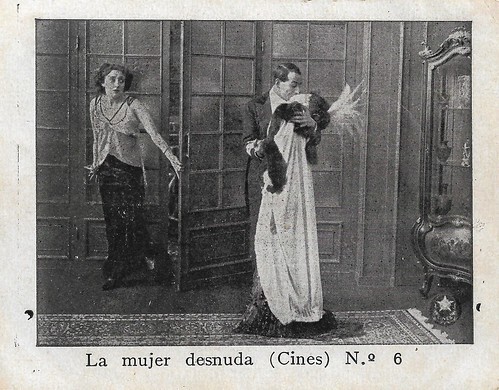
Spanish minicard (collectors card) by Reclam Films, Mallorca, no. 6 of 6 cards. Photo: Cines. Lyda Borelli , Lamberto Picasso, and Wanda Capodaglio in La donna nuda (Carmine Gallone, 1914).
Sources: Marcello Seregni (Catalogue Giornate del Cinema Muto, 2018), Wikipedia (Italian), IMDb, and viewing of the films.

Italian postcard by C.E. & Co. Photo: Cines. Lyda Borelli in La donna nuda (Carmine Gallone, 1914).
Ma l'amor mio non muore (1914)

Spanish minicard by Reclam Films, Mallorca, no. 1. Photo: Gloria Film. Vittorio Rossi Pianelli as Colonel Julius Holbein, Antonio Monti as The General, and Emilio Petacci as Colonel Theubner in Ma l'amor mio non muore (Mario Caserini, 1913). The Spanish title was ...Pero mi amor no muere.

Spanish minicard by Reclam Films, Mallorca, no. 2. Photo: Gloria Film. Lyda Borelli , Vittorio Rossi Pianelli, and Emilio Petacci in Ma l'amor mio non muore (Mario Caserini, 1913).
She dies on stage in Maximilian's arms
Ma l'amor mio non muore/Love Everlasting (Mario Caserini, 1913) was Lyda Borelli 's screen debut. She plays the beautiful Elsa Holbein, who lived in the Grand Duchy of Wallenstein. Elsa is the daughter of Colonel Julius Holbein (Vittorio Rossi Pianelli), who kills himself because he is falsely accused of treason. His missing military plans have been stolen by a foreign spy, Moise Stahr (Gian Paolo Rosmino).
Elsa, although innocent, is exiled and finds refuge on the Riviera. Here she begins to perform on the stage as an opera singer under the pseudonym Diana Cadouleur. Thanks to an engagement by the impresario Schaudard ( Camillo De Riso ), she achieves great success, but privately, she remains unhappy.
At the height of her success, Elsa meets Prince Maximilian ( Mario Bonnard ), heir to the Grand Duke, but both don't know each other's true identity. The two fall in love, and Elsa finds happiness, but during a boat trip on the Lago Maggiore, they meet Stahr. Having recognised the woman and been rejected by her, Stahr takes revenge by spreading the news of the Prince's affair, who is called back home.
Elsa, realising Maximilian is the son of the man who expelled her, is devastated. Broken, she returns to Schaudard. Maximilian, contravening the orders of his father, returns to Elsa, but seeing no future for the two of them, Elsa poisons herself and while performing the death scene from 'La Traviata', she collapses and dies on stage in Maximilian's arms.
In addition, Dante Cappelli played the Grand Duke, Maria Caserini the Grandduchess, and Emilio Petacci Colonel Theubner, who is first the close friend of Holbein and Elsa, but then becomes their enemy, acting on behalf of the Grandduke and the General Staff. Angelo Scalenghe was responsible for the cinematography, while the film is remarkable for its deep staging indoor cinematography, especially in the first scene of the film, its outdoor location shooting (around the Italian lakes), the elaborate costumes of Borelli, and its ingenious use of a triple mirror in the dressing room in the second part of the film.

Spanish minicard by Reclam Films, Mallorca, no. 3. Photo: Gloria Film. Lyda Borelli and Mario Bonnard in Ma l'amor mio non muore (Mario Caserini, 1913).

Spanish minicard by Reclam Films, Mallorca, no. 4. Photo: Gloria Film. Lyda Borelli and Camillo de Riso in Ma l'amor mio non muore (Mario Caserini, 1913).
One of the first "noble couples" of Italian cinema
In 1911, one of the most successful Italian silent film directors, Mario Caserini, left Cines for the Turin-based Ambrosio Film. A year later, he broke the contract with the latter as well and participated with the exhibitor Domenico Cazzulino and other partners in the establishment of a new film production company, the Film artistica Gloria.
In the new company Caserini brought with him his wife, the actress Maria Caserini, and a number of actors and actresses he had already directed at Cines and Ambrosio. After making the first two films Il treno degli spettri and Florette e Patapon, Gloria's prospects took off when it managed to recruit one of the most popular theatre actresses of the time, Lyda Borelli , who had never worked in the cinema before.
Caserini then set out to find a suitable subject for Borelli and found it in the writings of two Genoese non-professional authors, Emiliano Bonetti, a doctor, but also a lover of show business and music, and Giovanni Monleone, a teacher and journalist. The two friends had published a few minor works and now had decided to start writing for the cinema, insisting on sentimental and romantic themes. On this occasion, they created a story to which they gave a title taken from the last verse of Puccini's 'Manon Lescaut'.
Ma l'amor mio non muore/Love Everlasting was made in the middle of 1913 in the Turin factory of Gloria in Via Quittengo, where the newcomer Borelli was joined by an already experienced film actor, Mario Bonnard. They formed with one of the first "noble couples" of Italian cinema. Bonnard, however, found himself surpassed in notoriety and public passion, bordering on fanaticism, by the actress, who, according to a repetitive cliché of the "divas", also represents, in this case, a woman destined to die by suicide or to be the cause of death. Some scenes of passionate kissing between the two performers were nevertheless eliminated by the censors.
From the moment it appeared, Ma l'amor mio non muore was a triumphant success, contributing to the creation of the divine myth of Borelli. The periodicals of the time praised it as "the first film which, for the luxury of its staging, the vastness of its scenery and the impeccability of its interpretation, makes one forget the cinema and gives the impression of a work of dramatic art". Praise was lavished. Ma l'amor mio non muore was described as "harmonious, soft: from the small scenes with the faintest effect to the marvelous salons, the luxuriant exteriors, the mysterious landscapes, and the poetic, evocative close-ups", while Borelli was described as "a soft, elegant creature, ardent and painful, cloaked in nobility and voluptuousness, passing like a spring dress through a wood of flowering almond trees".
The writer Matilde Serao was also enthusiastic: "Never as in this film - she wrote - so tender and dramatic, so sumptuous and elegant, has Borelli achieved such a truth of physiognomy, all so differently beautiful". The film was also a commercial success as it was exported all over the world and the authors had news of successful performances for a long time, even from places as far away as Melbourne or La Paz. In later decades, critics and audiences were less enthusiastic, but when in 2013, exactly one century after its release, the film was restored by the Cineteca di Bologna in collaboration with the Museo Nazionale del Cinema di Torino, and shown at the Cinema Ritrovato film festival, the film was praised all over again. This restored edition has been available on DVD since 2013 as part of the Cineteca's series called Cinemalibero.

Spanish minicard by Reclam Films, Mallorca, no. 5. Photo: Gloria Film. Lyda Borelli and Mario Bonnard in Ma l'amor mio non muore (Mario Caserini, 1913).

Spanish minicard by Reclam Films, Mallorca, no. 6. Photo: Gloria Film. Lyda Borelli and Mario Bonnard in Ma l'amor mio non muore (Mario Caserini, 1913).
La memoria dell'altro (1914)

Spanish minicard (collectors card) by Reclam Films, Mallorca, no. 1 of 6 cards. Photo: Gloria Film. Lyda Borelli and Vittorio Rossi Pianelli in La memoria dell'altro (Alberto Degli Abbati, 1914). The Spanish release title was El recuerdo del otro.

Spanish minicard (collectors card) by Reclam Films, Mallorca, no. 2 of 6 cards. Photo: Gloria Film. Lyda Borelli and Vittorio Rossi Pianelli in La memoria dell'altro (Alberto Degli Abbati, 1914).
Her memory of Mario as her final vision
Just a few months after the release of Ma l’amor mio non muore! (Mario Caserini, 1913) followed Alberto Degli Abbati’s La memoria dell’altro/Memory of the other (1914), in which Lyda Borelli starred again with Mario Bonnard . La memoria dell’altro was made in the wake of the enormous success of its predecessor.
The two Gloria productions, both shot in Turin, became categorised as the first of “the Lyda Borelli series”, although immediately after La memoria dell’altro was finished Borelli left Gloria. She would hence continue her career at the Roman Cines company.
Lyda Borelli plays the young aviatrix Lyda, who spurns the advances of the Prince of Sèvre (Vittorio Rossi Pianelli). She falls in love with the journalist Mario ( Mario Bonnard ), who, although engaged to Cesarina (Letizia Quaranta), goes to Lyda’s home for an assignation. Cesarina sees them and manages to persuade Mario to leave Lyda.
Now alone, Lyda accepts the Prince’s advances even if she cannot forget Mario. Sometime later in Venice, the star-crossed lovers meet by chance in a theatre, re-igniting their memoria and their old love in a succession of romantic scenes.
The Prince goes berserk when he finds out. Yet, when Mario and Lyda have fled to Paris, Mario becomes ill and money runs out. Lyda first sells all of her belongings. Finally, she has to dance for money in a tavern, in order to get money for her beloved. But the medicine, alas, arrives too late. She becomes ill herself, dying in a hospital with her memory of Mario as her final vision.

Spanish minicard (collectors card) by Reclam Films, Mallorca, no. 3 of 6 cards. Photo: Gloria Film. Lyda Borelli in La memoria dell'altro (Alberto Degli Abbati, 1914).

Spanish minicard (collectors card) by Reclam Films, Mallorca, no. 4 of 6 cards. Photo: Gloria Film. Lyda Borelli in La memoria dell'altro (Alberto Degli Abbati, 1914).
A complex, articulate picture of the human heart
La memoria dell'altro/Memory of the other (Alberto Degli Abbati, 1914) was written by Gloria company author Baroness Vittorina De Rege. Marcello Seregni in the festival catalogue of Giornate del Cinema Muto 2018: "The story has the sure ability to create a complex, articulate picture of the human heart.
Lyda’s character glows with sensuality, and the story gives more than a nod to women’s emancipation, with the magnificent opening scene of an airplane in flight, a metaphor for modernity, just as the power and abandon of the apache dance in the second part of the film confirm the independence of the female character."
Mario Bonnard partners Borelli elegantly, providing a perfect counterbalance for the actress’s exuberance, and giving the performance of a “highly effective actor, at the same time sober, measured, and honest”.
Bonnard is there, in the scene, but we could almost say that he isn’t; his most obvious trademark is the extreme flexibility – one critic called it camouflage – with which he enters the shot and performs his role without excess, but with distinction. This second appearance confirmed Bonnard’s skill in evoking the cliché of the tragic male; yet despite its success, he had the wisdom to part company with such type-casting later in his career.
Adding to the film’s success were the Venice locations, among them vaporetto trips and wonderful shots of the Piazza San Marco. The direction was in the capable hands of the versatile Alberto Degli Abbati.

Spanish minicard (collectors card) by Reclam Films, Mallorca, no. 5 of 6 cards. Photo: Gloria Film. Lyda Borelli and Mario Bonnard in La memoria dell'altro (Alberto Degli Abbati, 1914).

Spanish minicard (collectors card) by Reclam Films, Mallorca, no. 6 of 6 cards. Photo: Gloria Film. Lyda Borelli in La memoria dell'altro (Alberto Degli Abbati, 1914).
La donna nuda (1914)

Spanish minicard (collectors card) by Reclam Films, Mallorca, no. 1 of 6 cards. Photo: Cines. Lyda Borelli and Lamberto Picasso in La donna nuda (Carmine Gallone, 1914).

Spanish minicard (collectors card) by Reclam Films, Mallorca, no. 2 of 6 cards. Photo: Cines. Lamberto Picasso, Lyda Borelli , and Wanda Capodaglio in La donna nuda (Carmine Gallone, 1914).
Walking through an autumnal forest with leaves falling down
La donna nuda (Carmine Gallone, 1914) was one of the many film adaptations of Henry Bataille's stage play 'La femme nue'. The painter Pierre Bernier (Lamberto Picasso) becomes rich and famous thanks to the portrait 'The Naked Woman'.
The portrait represents his model, the seductive Lolette ( Lyda Borelli ), whom he has 'stolen' from his old master Rouchard ( Ugo Piperno ). The very evening of his triumph at the Salon des Expositions, he decides to marry her.
But, having become rich and famous, Pierre Bernier soon falls in love with the frivolous Princess of Chaban ( Wanda Capodaglio ), an amateur painter herself, and abandons the woman to whom he owes his success.
Lolette first implores the princess to give him up, but when she sees her embracing Pierre during a party at her own home, she goes hysterical, throws away her ring, and collapses.
She ends up in hospital where Pierre visits her, but she cannot forgive him. Deluded, she returns to Rouchard walking through an autumnal forest, with leaves falling down around her. When Pierre understands the princess is not in love with him, he asks Lolette to forgive him. Poor Rouchard, hopelessly in love with Lolette, will remain alone.

Spanish minicard (collectors card) by Reclam Films, Mallorca, no. 3 of 6 cards. Photo: Cines. Lyda Borelli in La donna nuda (Carmine Gallone, 1914).

Spanish minicard (collectors card) by Reclam Films, Mallorca, no. 4 of 6 cards. Photo: Cines. Lyda Borelli , and Lamberto Picasso, in La donna nuda (Carmine Gallone, 1914).
One of Borelli's most outstanding performances
La donna nuda (1914)was Lyda Borelli's first production for the Roman company Cines, after her first two films at the Turinese company Gloria. Yet, the exteriors of the film were shot at the Valentino park in Turin.
The film had its Italian premiere in April 1914 and became a worldwide success. Even if some critics thought her earlier film Ma l'amor mio non muore a better film, the film critic Max wrote from Turin a raving review for the Neapolitan journal Film, considering it one of Cines' best films and one of Borelli's most outstanding performances, even if her comic moments were not really appreciated.
Even if a little astray boy risks ruining it, the shot in the autumnal forest is worthy of its sound equivalent at the end of The Third Man (Carol Reed, 1949) with Alida Valli .
Also, the shot through the half opaque glass during the ball, when Lolette witnesses the adultery, is masterfully done. Otherwise, the cinematography is static and it is rather the mise-en-scene that draws the attention, such as the deep staging interior scenes, or a back-lit shot on a bridge at the Valentino.
Lamberto Picasso is not very convincing as Pierre Bernier and while helping Lolette after her big scene of hysteria, he remarkable often holds his hands at her bosom. More touching is Ugo Piperno as the old painter who in the end loses Lolette, while being the more honest, loyal, and sincerely loving man.

Spanish minicard (collectors card) by Reclam Films, Mallorca, no. 5 of 6 cards. Photo: Cines. Lyda Borelli , and Lamberto Picasso, in La donna nuda (Carmine Gallone, 1914).

Spanish minicard (collectors card) by Reclam Films, Mallorca, no. 6 of 6 cards. Photo: Cines. Lyda Borelli , Lamberto Picasso, and Wanda Capodaglio in La donna nuda (Carmine Gallone, 1914).
Sources: Marcello Seregni (Catalogue Giornate del Cinema Muto, 2018), Wikipedia (Italian), IMDb, and viewing of the films.
Published on April 04, 2022 22:00
April 3, 2022
Pat Boone
Pat Boone (1934) is an American singer and actor who was the second-biggest charting artist of the late 1950s, behind only Elvis Presley. Initially, he performed Rock and Roll, but later in his career, he switched to gospel music. Over the years he has had many hit songs including 'Moody River', 'Speedy Gonzales', and 'Bernardine. He sold more than 45 million records, had 38 Top 40 hits, and appeared in more than 12 Hollywood films.
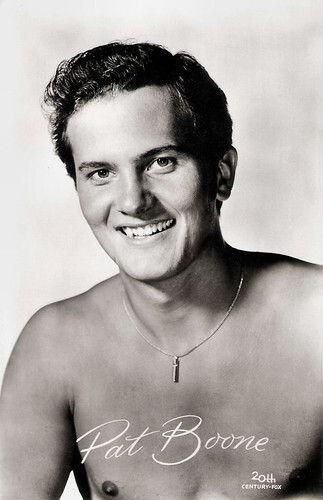
Dutch postcard by Uitgeverij Takken, Utrecht, no. AX 4211. Photo: 20th Century Fox.
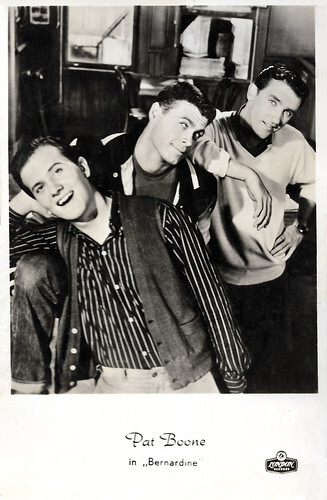
Dutch postcard by Gebr. Spanjersberg N.V., no. 5008. Photo: London. Pat Boone, Val Benedict, and Ronnie Burns in Bernardine (Henry Levin, 1957).
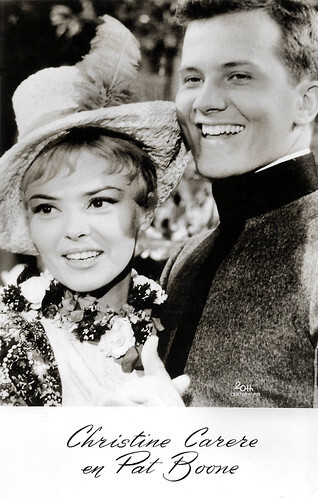
Dutch postcard by Uitgeverij Takken, Utrecht, no. AX 3845. Photo: 20th Century Fox. Christine Carère and Pat Boone in Mardi Gras (Edmund Goulding, 1958).
Polishing rhythm-and-blues hits into more accessible versions
Charles Eugene Patrick (Pat) Boone was born in Jacksonville, Florida, in 1934. His father, Archie Altman Boone, was a building contractor and his mother, Margaret Virginia (née Pritchard), was a nurse. His younger brother, Nick Boone, also had a popular music career under the name Nick Todd.
Pat grew up in Nashville, Tennessee, and attended David Lipscombe College, North Texas State College, and Columbia University from which he received a Bachelor of Science degree in 1958. Boone began his career by performing in Nashville's Centennial Park and started recording for Republic Records in 1954.
In 1955 he released a cover of the single 'Ain't That a Shame' by Fats Domino, and significantly broke the sales records of the original version. A number-one single in 1956 by Boone was a second cover and a revival of a then seven-year-old song 'I Almost Lost My Mind', by Ivory Joe Hunter, which was originally covered by another black star, Nat King Cole .
It is representative of the early period of Boone's career, which mainly focused on polishing rhythm-and-blues hits into more accessible versions, allowing the Rock and Roll tunes to reach a much wider audience. Boone was also criticised for his homogenised, sanitized versions. He succeeded in removing all of the more suggestive lyrics from his cover of Little Richard 's 'Long Tall Sally'. He changed the original's, "I saw Uncle John with Long Tall Sally, He saw Aunt Mary comin' and he ducked back in the alley" to, "Long Tall Sally's got a lot on the ball,/And nobody cares if she's long and tall." However, Little Richard himself once said: "It was Pat Boone who made me a millionaire".
Boone had the image of a fresh-faced smooth guy, who appealed to both teenagers and their parents. His singing style, a full baritone, followed in the footsteps of his idol Bing Crosby. Soon he switched more and more to singing ballads. At the end of the 1950s, Pat Boone was only surpassed in popularity by Elvis Presley. And just like Elvis, he made an attempt at some acting.
Although he made considerably fewer films than Elvis, it is said that his films were of considerably higher quality. Several film studios pursued him and he decided to go with 20th Century Fox, which had made Elvis Presley's first film. Fox reworked the play 'Bernardine' into a vehicle for Boone. The resulting film, Bernardine (Henry Levin, 1957), with Terry Moore and Janet Gaynor , was a solid hit, earning $3.75 million in the US.
His recording for the title song of his second film, April Love (Henry Levin, 1957), in which he co-starred with Shirley Jones, was nominated for an Oscar. At the age of 23, he began hosting a half-hour ABC variety television series, The Pat Boone Chevy Showroom, which aired for 115 episodes (1957–1960).
His recording of 'A Wonderful Time Up There' in 1958 became the first million-selling record with religious lyrics. Seeing himself as a devout born-again Christian, he refused music and film roles that went against his moral standards, including roles with the then-sex symbol Marilyn Monroe . In each of his film contracts, there was a term specifying that kissing his partner could not be forced on him by the director due to his religious convictions.
Less popular was the musical comedy Mardi Gras (Edmund Goulding, 1958) with Christine Carère . However, the Science-Fiction adventure, Journey to the Center of the Earth (Henri Levin, 1959), with James Mason and Arlene Dahl , was a huge hit.
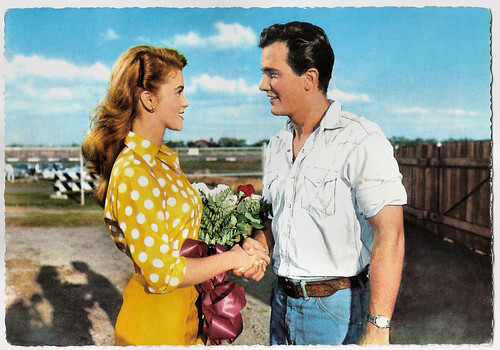
German postcard by Krüger, no. 902/262. Photo: Ann-Margret and Pat Boone in State Fair (José Ferrer, 1962).
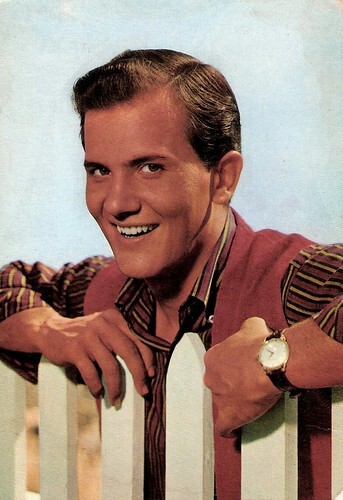
Spanish postcard by Postal Oscarcolor, no. 100, 1964.
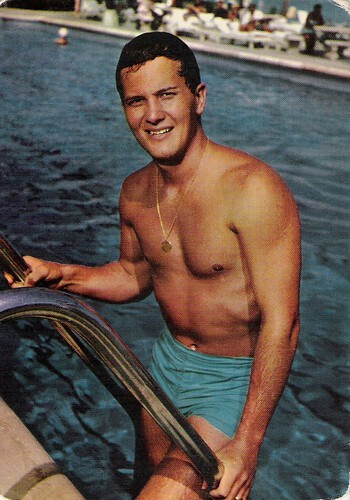
German postcard by Krüger, no. 902/64.
The end of Boone's career as a hit machine
Pat Boone wrote the lyrics for the title song for the film Exodus (Otto Preminger, 1960), which he titled 'This Land Is Mine'. He produced and starred in a documentary, Salute to the Teenagers (1960), but did not make a film for a while, studying acting with Sanford Meisner.
He returned with a military comedy, All Hands on Deck (Norman Taurog, 1961), a mild hit. He starred opposite Bobby Darin and Ann-Margret in another remake, State Fair (José Ferrer, 1962), but it was another box office disappointment. Musicals were becoming less fashionable in Hollywood.
An invasion of British pop groups such as The Rolling Stones , The Beatles , and The Kinks ended Pat Boone's career as a hit machine, although he continued to make records in the 1960s. During the early 1960s, Boone starred in a handful of British films, produced by his own Cooga Mooga productions. In one of these, The Yellow Canary (Buzz Kulik, 1963), he attempted to shake up his established image by portraying a nasty, ill-tempered rock star.
In the 1960s, he also began writing self-help books for adolescents, including the best-seller 'Twixt Twelve and Twenty'. In the 1970s, he switched to gospel music and country and continued to perform in other media, especially radio. Later, he was a disc jockey for a popular American old-time radio station and ran his own record company, which re-releases records from the 1950s that no longer have a place on major record labels.
Boone married Shirley Lee Foley in 1953 and they had four daughters: Cherry, Lindy, Debby, and Laury. In the 1960s and 1970s, the family toured as gospel artists and made gospel albums such as 'The Pat Boone Family' and 'The Family Who Prays'.
In 1997, Boone released an album entitled 'No More Mr. Nice Guy', which featured a collection of heavy metal covers polished to fit the Pat Boone style. To advertise the album, he appeared at the American Music Awards ceremony in black leather. He lost his respectable image in one fell swoop, at least among large sections of his following among conservative Christians. Because of this action, he was fired from Gospel America, a television programme of the Trinity Broadcasting Network.
However, the music from this CD was often used during the intermission of hard rock and heavy metal concerts, and the CD was appreciated by the somewhat older guard of hard rockers who saw the humour in it and could appreciate the performance of the songs, which included a choir and a full orchestra. In 2003, his gospel recordings were recognised by Nashville's Gospel Music Association and added to the Gospel Music Hall of Fame.
Boone lived in Los Angeles for many years with his wife Shirley Foley. They were influential members of the 'Church on the Road', the Inglewood Church of Christ in San Fernando Valley. Shirley (84) passed away in January 2019, when they had been married for 65 years.
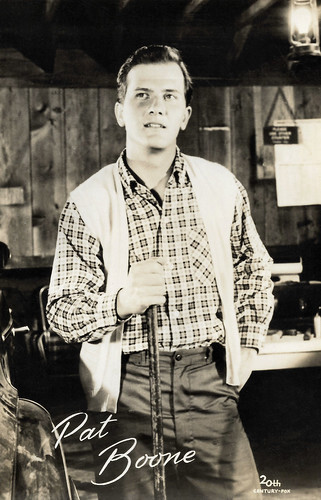
Dutch postcard by Uitgeverij Takken, Utrecht, no. AX 3313. Photo: 20th Century Fox. Pat Boone in Bernardine (Henry Levin, 1957).
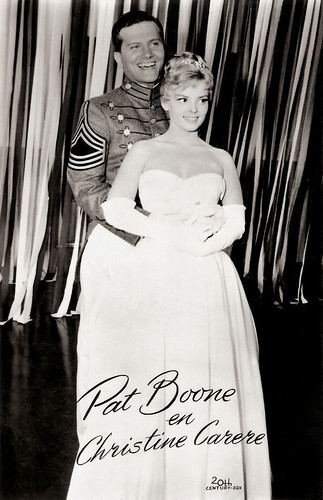
Dutch postcard by Uitgeverij Takken, Utrecht, no. AX 3843. Photo: 20th Century Fox. Christine Carère and Pat Boone in Mardi Gras (Edmund Goulding, 1958).
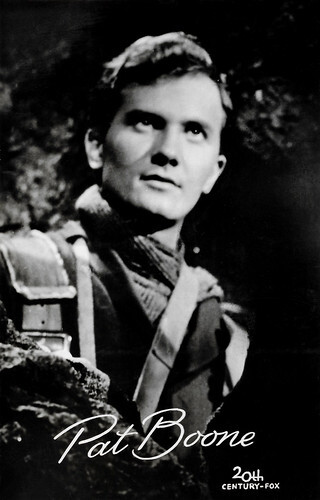
Dutch postcard by Uitgeverij Takken, Utrecht, no. AX 4213. Photo: 20th Century Fox. Pat Boone in Journey to the Center of the Earth (Henri Levin, 1959).
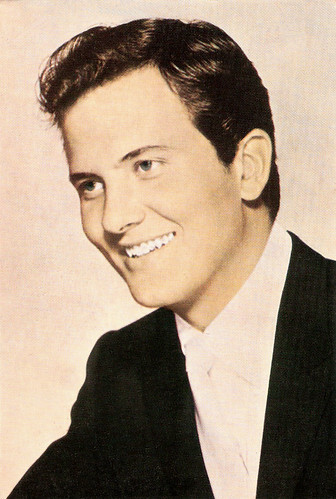
Dutch postcard. Sent by mail in 1964.
Sources: Hal Erickson (AllMovie), Wikipedia (Dutch and English), and .

Dutch postcard by Uitgeverij Takken, Utrecht, no. AX 4211. Photo: 20th Century Fox.

Dutch postcard by Gebr. Spanjersberg N.V., no. 5008. Photo: London. Pat Boone, Val Benedict, and Ronnie Burns in Bernardine (Henry Levin, 1957).

Dutch postcard by Uitgeverij Takken, Utrecht, no. AX 3845. Photo: 20th Century Fox. Christine Carère and Pat Boone in Mardi Gras (Edmund Goulding, 1958).
Polishing rhythm-and-blues hits into more accessible versions
Charles Eugene Patrick (Pat) Boone was born in Jacksonville, Florida, in 1934. His father, Archie Altman Boone, was a building contractor and his mother, Margaret Virginia (née Pritchard), was a nurse. His younger brother, Nick Boone, also had a popular music career under the name Nick Todd.
Pat grew up in Nashville, Tennessee, and attended David Lipscombe College, North Texas State College, and Columbia University from which he received a Bachelor of Science degree in 1958. Boone began his career by performing in Nashville's Centennial Park and started recording for Republic Records in 1954.
In 1955 he released a cover of the single 'Ain't That a Shame' by Fats Domino, and significantly broke the sales records of the original version. A number-one single in 1956 by Boone was a second cover and a revival of a then seven-year-old song 'I Almost Lost My Mind', by Ivory Joe Hunter, which was originally covered by another black star, Nat King Cole .
It is representative of the early period of Boone's career, which mainly focused on polishing rhythm-and-blues hits into more accessible versions, allowing the Rock and Roll tunes to reach a much wider audience. Boone was also criticised for his homogenised, sanitized versions. He succeeded in removing all of the more suggestive lyrics from his cover of Little Richard 's 'Long Tall Sally'. He changed the original's, "I saw Uncle John with Long Tall Sally, He saw Aunt Mary comin' and he ducked back in the alley" to, "Long Tall Sally's got a lot on the ball,/And nobody cares if she's long and tall." However, Little Richard himself once said: "It was Pat Boone who made me a millionaire".
Boone had the image of a fresh-faced smooth guy, who appealed to both teenagers and their parents. His singing style, a full baritone, followed in the footsteps of his idol Bing Crosby. Soon he switched more and more to singing ballads. At the end of the 1950s, Pat Boone was only surpassed in popularity by Elvis Presley. And just like Elvis, he made an attempt at some acting.
Although he made considerably fewer films than Elvis, it is said that his films were of considerably higher quality. Several film studios pursued him and he decided to go with 20th Century Fox, which had made Elvis Presley's first film. Fox reworked the play 'Bernardine' into a vehicle for Boone. The resulting film, Bernardine (Henry Levin, 1957), with Terry Moore and Janet Gaynor , was a solid hit, earning $3.75 million in the US.
His recording for the title song of his second film, April Love (Henry Levin, 1957), in which he co-starred with Shirley Jones, was nominated for an Oscar. At the age of 23, he began hosting a half-hour ABC variety television series, The Pat Boone Chevy Showroom, which aired for 115 episodes (1957–1960).
His recording of 'A Wonderful Time Up There' in 1958 became the first million-selling record with religious lyrics. Seeing himself as a devout born-again Christian, he refused music and film roles that went against his moral standards, including roles with the then-sex symbol Marilyn Monroe . In each of his film contracts, there was a term specifying that kissing his partner could not be forced on him by the director due to his religious convictions.
Less popular was the musical comedy Mardi Gras (Edmund Goulding, 1958) with Christine Carère . However, the Science-Fiction adventure, Journey to the Center of the Earth (Henri Levin, 1959), with James Mason and Arlene Dahl , was a huge hit.

German postcard by Krüger, no. 902/262. Photo: Ann-Margret and Pat Boone in State Fair (José Ferrer, 1962).

Spanish postcard by Postal Oscarcolor, no. 100, 1964.

German postcard by Krüger, no. 902/64.
The end of Boone's career as a hit machine
Pat Boone wrote the lyrics for the title song for the film Exodus (Otto Preminger, 1960), which he titled 'This Land Is Mine'. He produced and starred in a documentary, Salute to the Teenagers (1960), but did not make a film for a while, studying acting with Sanford Meisner.
He returned with a military comedy, All Hands on Deck (Norman Taurog, 1961), a mild hit. He starred opposite Bobby Darin and Ann-Margret in another remake, State Fair (José Ferrer, 1962), but it was another box office disappointment. Musicals were becoming less fashionable in Hollywood.
An invasion of British pop groups such as The Rolling Stones , The Beatles , and The Kinks ended Pat Boone's career as a hit machine, although he continued to make records in the 1960s. During the early 1960s, Boone starred in a handful of British films, produced by his own Cooga Mooga productions. In one of these, The Yellow Canary (Buzz Kulik, 1963), he attempted to shake up his established image by portraying a nasty, ill-tempered rock star.
In the 1960s, he also began writing self-help books for adolescents, including the best-seller 'Twixt Twelve and Twenty'. In the 1970s, he switched to gospel music and country and continued to perform in other media, especially radio. Later, he was a disc jockey for a popular American old-time radio station and ran his own record company, which re-releases records from the 1950s that no longer have a place on major record labels.
Boone married Shirley Lee Foley in 1953 and they had four daughters: Cherry, Lindy, Debby, and Laury. In the 1960s and 1970s, the family toured as gospel artists and made gospel albums such as 'The Pat Boone Family' and 'The Family Who Prays'.
In 1997, Boone released an album entitled 'No More Mr. Nice Guy', which featured a collection of heavy metal covers polished to fit the Pat Boone style. To advertise the album, he appeared at the American Music Awards ceremony in black leather. He lost his respectable image in one fell swoop, at least among large sections of his following among conservative Christians. Because of this action, he was fired from Gospel America, a television programme of the Trinity Broadcasting Network.
However, the music from this CD was often used during the intermission of hard rock and heavy metal concerts, and the CD was appreciated by the somewhat older guard of hard rockers who saw the humour in it and could appreciate the performance of the songs, which included a choir and a full orchestra. In 2003, his gospel recordings were recognised by Nashville's Gospel Music Association and added to the Gospel Music Hall of Fame.
Boone lived in Los Angeles for many years with his wife Shirley Foley. They were influential members of the 'Church on the Road', the Inglewood Church of Christ in San Fernando Valley. Shirley (84) passed away in January 2019, when they had been married for 65 years.

Dutch postcard by Uitgeverij Takken, Utrecht, no. AX 3313. Photo: 20th Century Fox. Pat Boone in Bernardine (Henry Levin, 1957).

Dutch postcard by Uitgeverij Takken, Utrecht, no. AX 3843. Photo: 20th Century Fox. Christine Carère and Pat Boone in Mardi Gras (Edmund Goulding, 1958).

Dutch postcard by Uitgeverij Takken, Utrecht, no. AX 4213. Photo: 20th Century Fox. Pat Boone in Journey to the Center of the Earth (Henri Levin, 1959).

Dutch postcard. Sent by mail in 1964.
Sources: Hal Erickson (AllMovie), Wikipedia (Dutch and English), and .
Published on April 03, 2022 22:00
April 2, 2022
Art Unlimited
Art Unlimited in Amsterdam has issued the most diverse images on postcards. 'Due to the infinite views that people can hold on the concept of art, Art Unlimited has become known as a publisher that does not think "in boxes"', according to their own website. Photography is a technique that Art Unlimited has published the most on postcards by far. The publishing company had a breakthrough among the general public in the 1980s and published images that have become classics in 20th-century postcard history.The history of Art Unlimited now spans almost 4 decades. Here's a selection of Art Unlimited postcards we love.
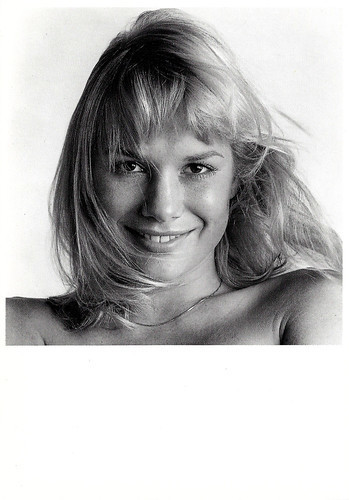
Dutch postcard by Art Unlimited, Amsterdam, no. B 1948, 1994. Photo: Paul Huf, 1976.
Monique van de Ven (1952) is a Dutch actress and director. With her film debut in Paul Verhoeven 's Turks fruit/Turkish Delight (1973), she was an international sensation. Although she appeared in some international films, she was mainly active in Dutch cinema and television.
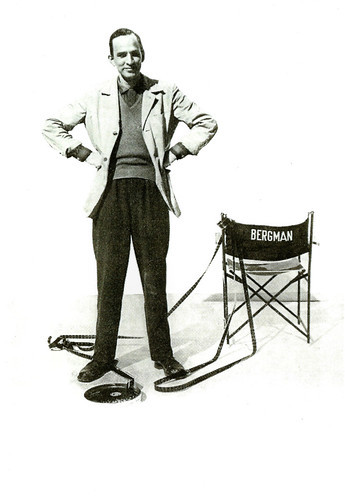
Dutch postcard by Art Unlimited, Amsterdam, no. B 3468. Caption: Ingmar Bergman , photographer unknown, ca. 1963.
Ingmar Bergman (1918-2007) was a Swedish film writer and director who achieved world fame with such films as Det sjunde inseglet/The Seventh Seal (1957); Smultronstället/Wild Strawberries (1957); the trilogy Såsom i en spegel/Through a Glass Darkly (1961), Nattsvardsgästerna/Winter Light (1963), and Tystnaden/The Silence (1963), and Viskningar och rop/Cries and Whispers (1972). His final feature, Fanny och Alexander/Fanny and Alexander (1982) won four Academy Awards, including for Best Foreign Language Film. Bergman directed over sixty films and documentaries, most of which he also wrote. He also directed over 170 plays and was Leading Director of the Royal Dramatic Theatre in Stockholm and of the Residenztheater in Munich.
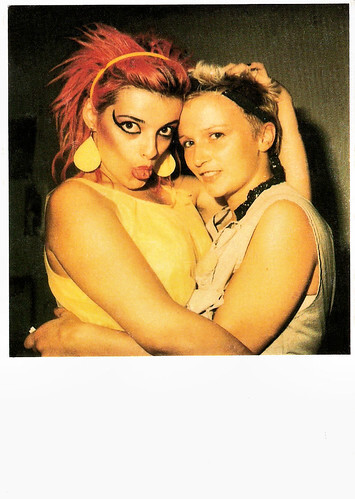
Dutch postcard by Art Unlimited, Amsterdam, no. C 1930. Photo: Bettie Ringma, 1980. Caption: Nina Hagen with Sacha, New York.
German singer, songwriter, and actress Nina Hagen (1955) is known for her theatrical vocals and is often referred to as the ‘Godmother of Punk due to her prominence during the punk and new wave movements in the late 1970s and early 1980s. During her 40-years-career she appeared in several European films.
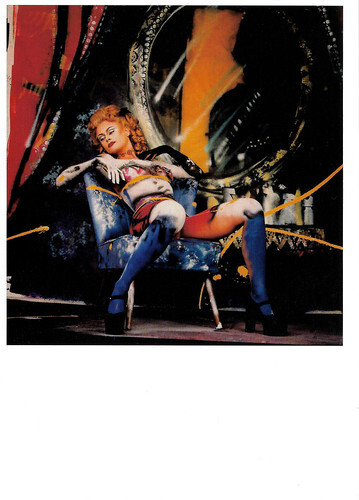
Dutch postcard by Art Unlimited, no. C 9824. Photo for Playboy by Herman Brood.
Monique Sluyter (1967) is a Dutch glamour model, TV presenter and actress. She posed five times for Playboy Magazine. In one of the sessions, she was bodypainted by artist Herman Brood.
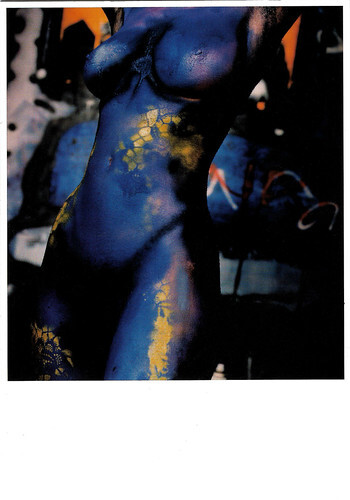
Dutch postcard by Art Unlimited, no. C 9826. Photo for Playboy by Herman Brood. Caption: bodyshot.
Monique Sluyter (1967) is a Dutch glamour model, TV presenter and actress. Sluyter made her film debut in Langer licht/Northern Light (David Lammers, 2006) opposite Raymond Thiry, for which she received good reviews. She also could be seen in bit roles in Deuce Bigalow: European Gigolo (Mike Bigelow, 2005) and Deiji/Daisy (Andrew Lau, 2008).
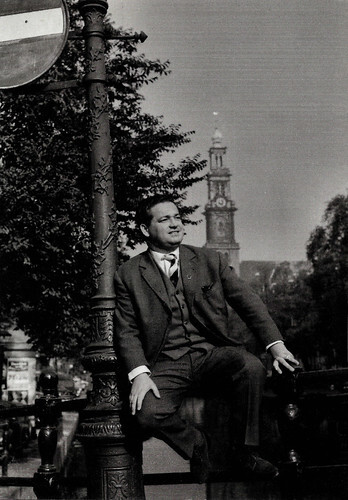
Dutch postcard by Art Unlimited, Amsterdam, no. B 1729, 1993. Photo: Dirk de Herder. Caption: Willy Alberti at the Westertoren, Amsterdam, 1962.
Dutch tenor Willy Alberti (1926-1985) sang in Dutch and Italian. The internationally popular ‘Tenore Napolitano’ was also an actor, and radio and TV personality. Alberti played a part as a café owner in the successful Dutch film Rififi in Amsterdam (John Korporaal aka Giovanni Korporaal, 1963).
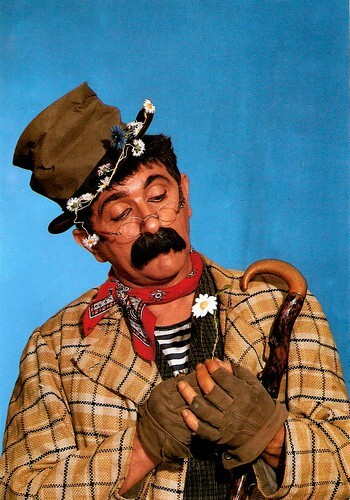
Dutch postcard by Art Unlimited, Amsterdam, no. C 5321, 1994. Photo: Dirk de Herder. Caption: "Tom Manders, Grand artiste".
Dutch artist, comedian and cabaret performer Tom Manders (1921-1972) was best known as Dorus. His TV shows were huge successes in the Netherlands and he also made a few films which were financial disasters.
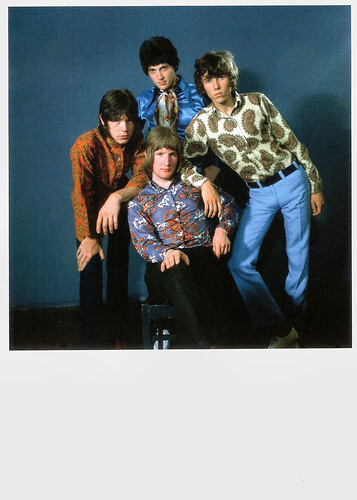
Dutch postcard by Art Unlimited, no. C 11205. Photo: Nico van der Stam (1968) / Maria Austria Instituut, Amsterdam / Stedelijk Museum Alkmaar.
Golden Earring is a Dutch rock band, founded in 1961 in The Hague as the Golden Earrings (the 's' was dropped in 1969). They achieved worldwide fame with their hits Radar Love (1973), Twilight Zone (1982), and When the Lady Smiles (1984). During their career, they had nearly 30 top-ten singles on the Dutch charts, and over the years they produced 25 studio albums.

Dutch postcard by Art Unlimited, Amsterdam, no. B 2201. Photo: Robin Barton, 1988.
Brooding macho Oliver Reed (1938-1999) was one of England's darker leading men and villainous character actors. He juggled over 60 film roles in 40 years and a full-blooded social life of women, booze, and bar fights. After a start in Hammer films, Reed worked often with acclaimed British directors Ken Russell, Richard Lester, and Michael Winner. His final role was as the old, gruff gladiator trainer in Ridley Scott's Gladiator (2000).
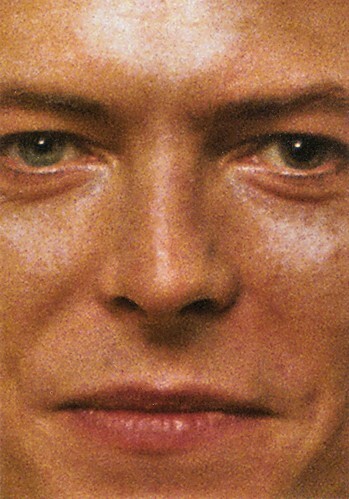
Dutch postcard by Art Unlimited, Amsterdam, no. 010a. Photo: Claude Vanheye.
The English musician and actor David Bowie (1947-2016) was a major pop star for over four decades. During the 1970s, he was a magnificent innovator, we love his album 'Changes'. With various stage and film roles, he showed to be a fine actor too.
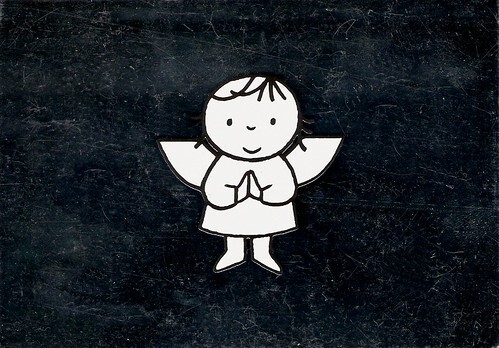
Dutch postcard by Art Unlimited, Amsterdam, no. DB 316. Illustration: Dick Bruna, 1963.
Dutch author, artist, illustrator and graphic designer Dick Bruna(1927-2019) was famous for his Miffy (Nijntje in Dutch), a small rabbit drawn with heavy graphic lines, simple shapes and primary colors. Aside from his prolific catalog of children's books, Bruna also illustrated and designed book covers, posters and promotional materials for his father's publishing company A.W. Bruna and Zoon. His most popular designs graced the covers of the Zwarte Beertjes series of books. Well known among his designs are those for Simenon's Maigret books, typified by graphic silhouettes of a pipe on various backgrounds.
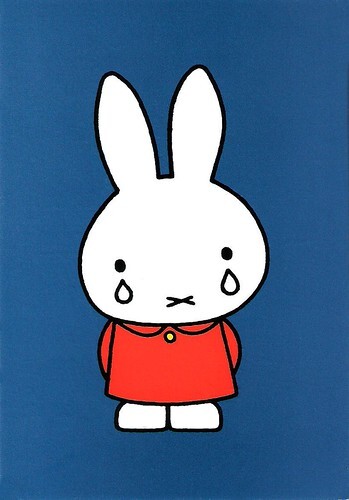
Dutch postcard by Art Unlimited, Amsterdam, 1975. Illustration: Dick Bruna, 1975.
In 1955, Dick Bruna drew Miffy (Nijntje) for the first time. In the first years, 'Mif' looks like a cloth toy animal, with somewhat clumsy ears. From 1963, when the Miffy booklets appeared in square format, she resembled the Rabbit as we still know her today. She looks at the reader with her black eyes, has two tight, pointed ears and nice round cheeks. The kid rabbit also starred in the cute TV series Miffy and Friends (2003-2007). In 2011, the last new book featuring Miffy appeared.
Sources: Art Unlimited, Nijntje (Dutch), and IMDb.

Dutch postcard by Art Unlimited, Amsterdam, no. B 1948, 1994. Photo: Paul Huf, 1976.
Monique van de Ven (1952) is a Dutch actress and director. With her film debut in Paul Verhoeven 's Turks fruit/Turkish Delight (1973), she was an international sensation. Although she appeared in some international films, she was mainly active in Dutch cinema and television.

Dutch postcard by Art Unlimited, Amsterdam, no. B 3468. Caption: Ingmar Bergman , photographer unknown, ca. 1963.
Ingmar Bergman (1918-2007) was a Swedish film writer and director who achieved world fame with such films as Det sjunde inseglet/The Seventh Seal (1957); Smultronstället/Wild Strawberries (1957); the trilogy Såsom i en spegel/Through a Glass Darkly (1961), Nattsvardsgästerna/Winter Light (1963), and Tystnaden/The Silence (1963), and Viskningar och rop/Cries and Whispers (1972). His final feature, Fanny och Alexander/Fanny and Alexander (1982) won four Academy Awards, including for Best Foreign Language Film. Bergman directed over sixty films and documentaries, most of which he also wrote. He also directed over 170 plays and was Leading Director of the Royal Dramatic Theatre in Stockholm and of the Residenztheater in Munich.

Dutch postcard by Art Unlimited, Amsterdam, no. C 1930. Photo: Bettie Ringma, 1980. Caption: Nina Hagen with Sacha, New York.
German singer, songwriter, and actress Nina Hagen (1955) is known for her theatrical vocals and is often referred to as the ‘Godmother of Punk due to her prominence during the punk and new wave movements in the late 1970s and early 1980s. During her 40-years-career she appeared in several European films.

Dutch postcard by Art Unlimited, no. C 9824. Photo for Playboy by Herman Brood.
Monique Sluyter (1967) is a Dutch glamour model, TV presenter and actress. She posed five times for Playboy Magazine. In one of the sessions, she was bodypainted by artist Herman Brood.

Dutch postcard by Art Unlimited, no. C 9826. Photo for Playboy by Herman Brood. Caption: bodyshot.
Monique Sluyter (1967) is a Dutch glamour model, TV presenter and actress. Sluyter made her film debut in Langer licht/Northern Light (David Lammers, 2006) opposite Raymond Thiry, for which she received good reviews. She also could be seen in bit roles in Deuce Bigalow: European Gigolo (Mike Bigelow, 2005) and Deiji/Daisy (Andrew Lau, 2008).

Dutch postcard by Art Unlimited, Amsterdam, no. B 1729, 1993. Photo: Dirk de Herder. Caption: Willy Alberti at the Westertoren, Amsterdam, 1962.
Dutch tenor Willy Alberti (1926-1985) sang in Dutch and Italian. The internationally popular ‘Tenore Napolitano’ was also an actor, and radio and TV personality. Alberti played a part as a café owner in the successful Dutch film Rififi in Amsterdam (John Korporaal aka Giovanni Korporaal, 1963).

Dutch postcard by Art Unlimited, Amsterdam, no. C 5321, 1994. Photo: Dirk de Herder. Caption: "Tom Manders, Grand artiste".
Dutch artist, comedian and cabaret performer Tom Manders (1921-1972) was best known as Dorus. His TV shows were huge successes in the Netherlands and he also made a few films which were financial disasters.

Dutch postcard by Art Unlimited, no. C 11205. Photo: Nico van der Stam (1968) / Maria Austria Instituut, Amsterdam / Stedelijk Museum Alkmaar.
Golden Earring is a Dutch rock band, founded in 1961 in The Hague as the Golden Earrings (the 's' was dropped in 1969). They achieved worldwide fame with their hits Radar Love (1973), Twilight Zone (1982), and When the Lady Smiles (1984). During their career, they had nearly 30 top-ten singles on the Dutch charts, and over the years they produced 25 studio albums.

Dutch postcard by Art Unlimited, Amsterdam, no. B 2201. Photo: Robin Barton, 1988.
Brooding macho Oliver Reed (1938-1999) was one of England's darker leading men and villainous character actors. He juggled over 60 film roles in 40 years and a full-blooded social life of women, booze, and bar fights. After a start in Hammer films, Reed worked often with acclaimed British directors Ken Russell, Richard Lester, and Michael Winner. His final role was as the old, gruff gladiator trainer in Ridley Scott's Gladiator (2000).

Dutch postcard by Art Unlimited, Amsterdam, no. 010a. Photo: Claude Vanheye.
The English musician and actor David Bowie (1947-2016) was a major pop star for over four decades. During the 1970s, he was a magnificent innovator, we love his album 'Changes'. With various stage and film roles, he showed to be a fine actor too.

Dutch postcard by Art Unlimited, Amsterdam, no. DB 316. Illustration: Dick Bruna, 1963.
Dutch author, artist, illustrator and graphic designer Dick Bruna(1927-2019) was famous for his Miffy (Nijntje in Dutch), a small rabbit drawn with heavy graphic lines, simple shapes and primary colors. Aside from his prolific catalog of children's books, Bruna also illustrated and designed book covers, posters and promotional materials for his father's publishing company A.W. Bruna and Zoon. His most popular designs graced the covers of the Zwarte Beertjes series of books. Well known among his designs are those for Simenon's Maigret books, typified by graphic silhouettes of a pipe on various backgrounds.

Dutch postcard by Art Unlimited, Amsterdam, 1975. Illustration: Dick Bruna, 1975.
In 1955, Dick Bruna drew Miffy (Nijntje) for the first time. In the first years, 'Mif' looks like a cloth toy animal, with somewhat clumsy ears. From 1963, when the Miffy booklets appeared in square format, she resembled the Rabbit as we still know her today. She looks at the reader with her black eyes, has two tight, pointed ears and nice round cheeks. The kid rabbit also starred in the cute TV series Miffy and Friends (2003-2007). In 2011, the last new book featuring Miffy appeared.
Sources: Art Unlimited, Nijntje (Dutch), and IMDb.
Published on April 02, 2022 22:00
Paul van Yperen's Blog
- Paul van Yperen's profile
- 13 followers
Paul van Yperen isn't a Goodreads Author
(yet),
but they
do have a blog,
so here are some recent posts imported from
their feed.



